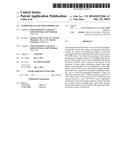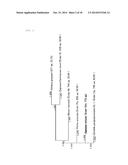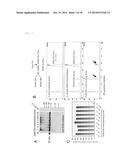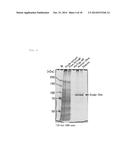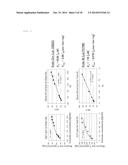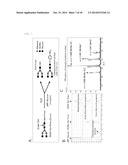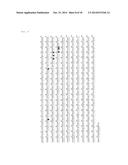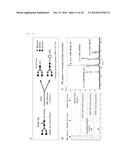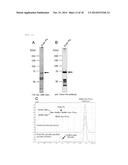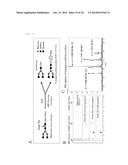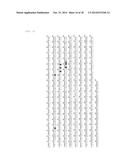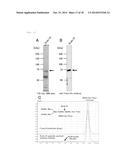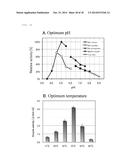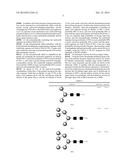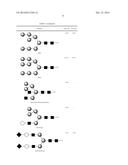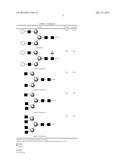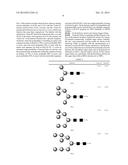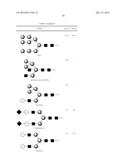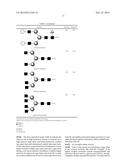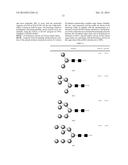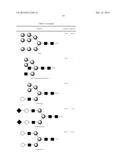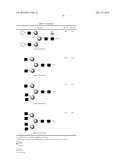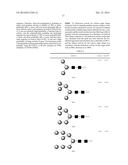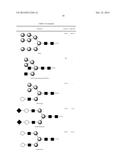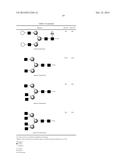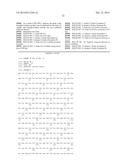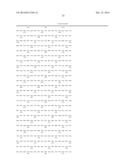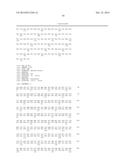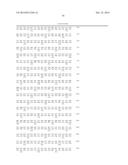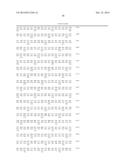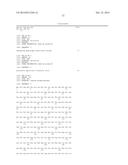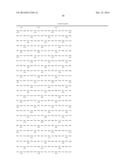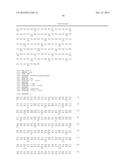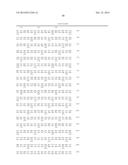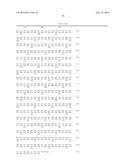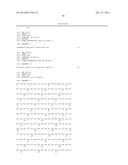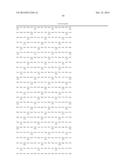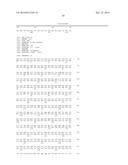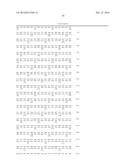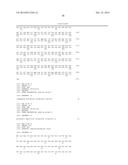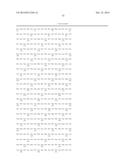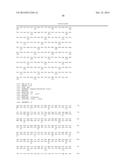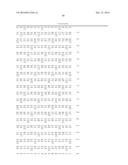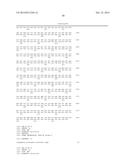Patent application title: COMPOSITE SUGAR CHAIN HYDROLASE
Inventors:
Yasunori Chiba (Ibaraki, JP)
Satoshi Murakami (Ibaraki, JP)
Hisashi Narimatsu (Ibaraki, JP)
Hisashi Narimatsu (Ibaraki, JP)
Assignees:
National Institute of Advanced Industrial Science and Technology
IPC8 Class: AC12N942FI
USPC Class:
435 681
Class name: Chemistry: molecular biology and microbiology micro-organism, tissue cell culture or enzyme using process to synthesize a desired chemical compound or composition enzymatic production of a protein or polypeptide (e.g., enzymatic hydrolysis, etc.)
Publication date: 2014-10-23
Patent application number: 20140315246
Abstract:
The present invention provides a novel
endo-β-N-acetylglucosaminidase (Endo-Om) using a transformant
produced by cloning an endo-β-N-acetylglucosaminidase (Endo-Om) gene
originated from a methylotrophic yeast Ogataea minuta IFO10746 strain.
The Endo-Om according to the present invention has a specific activity
13-fold higher than that of known Endo-M and a Vmax value 55-fold higher
than that of the known Endo-M, and is useful for the analysis of the
structures of sugar chains, including complex type sugar chains, in
glycoproteins and the modification of the sugar chains. Also provided are
an endo-β-N-acetylglucosaminidase (Endo-Cp), an
endo-β-N-acetylglucosaminidase (Endo-Pa) and an
endo-β-N-acetylglucosamimidase (Endo Zr) which are produced from
Candida parapolymorpha DL-1 ATCC26012 strain, Pichia anomala ATCC36904
strain and Zygosaccharomyces rouxii ATCC2623 strain, respectively, on the
basis of an Endo-Om gene sequence, and each of which has a similar level
of complex type sugar chain cleavage activity and a similar level of
complex type sugar chain transfer activity to those of Endo-Om.Claims:
1-9. (canceled)
10. A cDNA which codes a protein having endo-.beta.-N-acetylglucosaminidase activity wherein the protein comprises an amino acid sequence selected from the group consisting of: (1) the amino acid sequence set forth in SEQ ID NO, 1, 5, 9, or 13; (2) the amino acid sequence obtained by deletion, substitution, insertion and/or addition of an amino acid or several amino acids in the amino acid sequence set forth in SEQ ID NO. 1, 5, 9, or 13, (3) the amino acid sequence having an identity of 70% or more with the amino acid sequence set forth in SEQ ID NO. 1, 5, 9, or 13; (4) the amino acid sequence coded by the nucleotide sequence set forth in SEQ ID NO. 2, 6, 10, or 14; and (5) the amino acid sequence coded by the nucleotide sequence of the polynucleotide which hybridizes with the polynucleotide including the complementary sequence of the nucleotide sequence set forth in SEQ ID NO. 2, 6, 10, or 14 under stringent conditions.
11. A cDNA comprising a nucleotide sequence selected from the group consisting of: (1) the nucleotide sequence set forth in SEQ ID NO, 2, 6, 10, or 14 in containing polynucleotide; (2) the polynucleotide which hybridizes with the polynucleotide including the complementary sequence of the nucleotide sequence set forth in SEQ ID NO. 2, 6, 10, or 14 under stringent conditions, and codes a protein having endo-.beta.-N-acetylglucosaminidase activity; (3) the polynucleotide which is amplified by the primer set containing the nucleotide sequences set forth in SEQ ID NO. 3 and 4, has an identity of 70% or more with SEQ ID NO. 2, and codes a protein having endo-.beta.-N-acetylglucosaminidase activity; (4) the polynucleotide which is amplified by the primer set containing the nucleotide sequences set forth in SEQ ID NO. 7 and 8, has an identity of 70% or more with SEQ ID NO. 6, and codes a protein having endo-.beta.-N-acetylglucosaminidase activity; (5) the polynucleotide which is amplified by the primer set containing the nucleotide sequences set forth in SEQ ID NO. 11 and 12, has an identity of 70% or more with SEQ ID NO. 10, and codes a protein having endo-.beta.-N-acetylglucosaminidase activity; and (6) the polynucleotide which is amplified by the primer set containing the nucleotide sequences set forth in SEQ ID NO. 15 and 16, has an identity of 70% or more with SEQ ID NO. 14, and codes a protein having endo-.beta.-N-acetylglucosaminidase activity.
12. A vector for expressing a protein having endo-.beta.-N-acetylglucosaminidase activity, comprising the cDNA of claim 10.
13. A vector for expressing a protein having endo-.beta.-N-acetylglucosamimidase activity, comprising the cDNA of claim 11.
14. A transformant for expressing a protein having endo-.beta.-N-acetylglucosaminidase activity into which the vector of claim 12 is introduced.
15. The transformant of claim 14, wherein the transformant is hosted by yeast cells selected from any of the yeasts Ogataea minuta, Candida parapolymorpha, Pichia anomala, and Zygosaccharomyces rouxii.
16. A transformant for expressing a protein having endo-.beta.-N-acetylglucosaminidase activity into which the vector of claim 13 is introduced.
17. The transformant of claim 16, wherein the transformant is hosted by yeast cells selected from any of the yeasts Ogataea minuta, Candida parapolymorpha, Pichia anomala, and Zygosaccharomyces rouxii.
18. A method for producing a protein having endo-.beta.-N-acetylglucosaminidase activity, comprising the process of culturing the transformant of claim 14.
19. A method for producing a protein having endo-.beta.-N-acetylglucosaminidase activity, comprising the process of culturing the transformant of claim 16.
20. A method for cutting an asparagine-linked sugar chain from a glycoprotein, comprising the process of treating the glycoprotein with the protein having endo-.beta.-N-acetylglucosaminidase activity, comprising an amino acid sequence selected from the group consisting of: (1) the amino acid sequence set forth in SEQ ID NO, 1, 5, 9, or 13; (2) the amino acid sequence obtained by deletion, substitution, insertion and/or addition of an amino acid or several amino acids in the amino acid sequence set forth in SEQ ID NO. 1, 5, 9, or 13, (3) the amino acid sequence having an identity of 70% or more with the amino acid sequence set forth in SEQ ID NO. 1, 5, 9, or 13; (4) the amino acid sequence coded by the nucleotide sequence set forth in SEQ ID NO. 2, 6, 10, or 14; and (5) the amino acid sequence coded by the nucleotide sequence of the polynucleotide which hybridizes with the polynucleotide including the complementary sequence of the nucleotide sequence set forth in SEQ ID NO. 2, 6, 10, or 14 under stringent conditions.
21. A reagent for cutting an asparagine-linked sugar chain from a glycoprotein in which a protein having endo-.beta.-N-acetylglucosaminidase activity as an active ingredient, wherein the protein comprises an amino acid sequence selected from the group consisting of: (1) the amino acid sequence set forth in SEQ ID NO. 1, 5, 9, or 13; (2) the amino acid sequence obtained by deletion, substitution, insertion and/or addition of an amino acid or several amino acids in the amino acid sequence set forth in SEQ ID NO, 1, 5, 9, or (3) the amino acid sequence having an identity of 70% or more with the amino acid sequence set forth in SEQ ID NO. 1, 5, 9, or 13; (4) the amino acid sequence coded by the nucleotide sequence set forth in SEQ ID NO. 2, 6, 10, or 14; and (5) the amino acid sequence coded by the nucleotide sequence of the polynucleotide which hybridizes with the polynucleotide including the complementary sequence of the nucleotide sequence set forth in SEQ ID NO. 2, 6, 10, or 14 under stringent conditions.
22. A method for transferring an asparagine-linked sugar chain to any acceptor molecule, comprising the process of treating the acceptor molecule with the protein having endo-.beta.-N-acetylglucosaminidase activity, wherein the protein comprises an amino acide sequence selected from the group consisting of: (1) the amino acid sequence set forth in SEQ ID NO, 1, 5, 9, or 13; (2) the amino acid sequence obtained by deletion, substitution, insertion and/or addition of an amino acid or several amino acids in the amino acid sequence set forth in SEQ ID NO. 1, 5, 9, or 13, (3) the amino acid sequence having an identity of 70% or more with the amino acid sequence set forth in SEQ ID NO. 1, 5, 9, or 13; (4) the amino acid sequence coded by the nucleotide sequence set forth in SEQ ID NO, 2, 6, 10, or 14; and (5) the amino acid sequence coded by the nucleotide sequence of the polynucleotide which hybridizes with the polynucleotide including the complementary sequence of the nucleotide sequence set forth in SEQ ID NO. 2, 6, 10, or 14 under stringent conditions.
23. A reagent for transferring an asparagine-linked sugar chain to any acceptor molecule in which a protein having endo-3-N-acetylglucosaminidase activity as an active ingredient, wherein the protein comprises an amino acide sequence selected from the group consisting of: (1) the amino acid sequence set forth in SEQ ID NO. 1, 5, 9, or 13; (2) the amino acid sequence obtained by deletion, substitution, insertion and/or addition of an amino acid or several amino acids in the amino acid sequence set forth in SEQ ID NO. 1, 5, 9, or 13; (3) the amino acid sequence having an identity of 70% or more with the amino acid sequence set forth in SEQ ID NO. 1, 5, 9, or 13; (4) the amino acid sequence coded by the nucleotide sequence set forth in SEQ ID NO. 2, 6, 10, or 14; and (5) the amino acid sequence coded by the nucleotide sequence of the polynucleotide which hybridizes with the polynucleotide including the complementary sequence of the nucleotide sequence set forth in SEQ ID NO, 2, 6, 10, or 14 under stringent conditions.
Description:
TECHNICAL FIELD
[0001] The present invention relates to a complex type sugar chain hydrolase and its gene.
BACKGROUND ART
[0002] Glycoproteins are found in eukaryotes from microorganisms such as yeast to human, and are reported to be found in several bacteria in recent years. The functions of their sugar chains relate to stability and protease resistance of protein, and are necessary for folding for the formation of a higher-order structure. In addition, glycoproteins are known to control the interaction between proteins, and bind to lectin on the cell surface to cause signal transduction. The analysis of these glycoproteins requires cleavage of the sugar chains and determination of their structure. Peptide: N-glycanase and endo-β-N-acetylglucosaminidases are known as the enzymes which cleaves the N-linked sugar chain attached to asparagine residues. The latter endo-β-N-acetylglucosaminidases are enzymes which cleave the bond between chitobiose molecules at the reducing ends of N-type sugar chains, and known examples include Arthrobacter-derived Endo-A (Non Patent Literature 1, Patent Literature 4), Streptococcus pneumoniae-derived Endo-D (Non Patent Literature 2), Flavobacterium-derived Endo-F (Non Patent Literature 3), Streptomyces plicatus-derived Endo-H (Non Patent Literature 4), Mycosphaerella-derived endo-β-N-acetylglucosaminidase (Patent Literature 3), rice-derived Endo-Os (Non Patent Literature 5), Mucor hiemalis-derived Endo-M (Patent Literatures 1, 2, and 5, Non Patent Literatures 6 and 7) are known. Many of them have digestion activity between chitobiose molecules, and transglycosidase activity for transferring sugar chains. More specifically, they efficiently catalyze the reaction including the action on the N-type sugar chain of a glycoprotein to cut out the sugar chain, and transfer of the sugar chain to a carbohydrate or complex carbohydrate as the acceptor. Accordingly, endo-β-N-acetylglucosaminidases are enzymes useful not only for the analysis of the sugar chain structure of glycoproteins, and also for the modification of glycoproteins and glycolipids, preparation of neoglycoproteins, and homogenization of the sugar chain of glycoproteins.
[0003] The asparagine-linked sugar chains of glycoproteins showing major biological activity are classified into high-mannose type (mannan type sugar chain), hybrid type, and complex type sugar chains, according to their structures. However, among the endo-β-N-acetylglucosaminidases, Endo-M, Endo-F2, Endo-F3, Endo-S, and Endo-CE are reported to have activity for cleaving the complex type sugar chain.
[0004] The properties of Endo-M are studied in detail, and its substrate specificity is 4.4% for the biantennary complex type sugar chain (agalacto biantennary PA-sugar) when the activity for the high-mannose type Man8GlcNAc2 is set at 100% (Non Patent Literature 6). In addition, there is a description that Endo-M can cleave the triantennary and asialo tetraantennary N-type sugar chains (Non Patent Literature 7), but the activity for asialo triantennary and asialo tetraantennary was not detected in the enzyme activity measurement using a PA sugar chain (Non Patent Literature 6). Endo-M also cannot cleave the biantennary PA-sugar chain to which core fucose is attached.
[0005] Endo-F2 is an enzyme derived from Elizabethkingia miricola, and hydrolyzes high-mannose- and biantennary complex type sugar chains, but has no activity for hydrolyzing a hybrid type sugar chain (Non Patent Literature 8). Endo-F3 is also an enzyme derived from Elizabethkingia miricola, and hydrolyzes a biantennary or triantennary complex type sugar chain, but has no activity for hydrolyzing high-mannose and hybrid type sugar chains (Non Patent Literature 8). Endo-S is an enzyme derived from Streptococcus pyogenes, and hydrolyzes a biantennary complex type sugar chain, but has no activity for hydrolyzing high-mannose type and hybrid type sugar chains (Non Patent Literature 9). Endo-CE is an enzyme derived from Caenorhabditis elegans, and hydrolyzes high-mannose and biantennary complex type sugar chains. However, it is unknown whether it cleaves a hybrid type sugar chain (Non Patent Literature 10).
[0006] Regarding the modification of a complex type sugar chain, based on prior art findings, the substrate specificity of transglycosidase activity of endo-β-N-acetylglucosaminidases is the same as their digestion activity, so only these enzymes can transfer complex type sugar chains to acceptors.
[0007] The provision of an endo-β-N-acetylglucosaminidase having different substrate specificity from Endo-M is desired for the analysis of the sugar chain structure of a glycoprotein and the synthesis of glycoproteins having various sugar chains including complex type carbohydrate sugar chains, and the enzyme having high specific activity for a complex type sugar chain is also desired.
CITATION LIST
Patent Literatures
[0008] Patent Literature 1: JP 11-332568 A
[0009] Patent Literature 2: JP 7-59587 A
[0010] Patent Literature 3: JP 9-191875 A
[0011] Patent Literature 4: JP 9-173083 A
[0012] Patent Literature 5: WO 2008/111526 A
[0013] Patent Literature 6: WO 2009/057813 A
[0014] Patent Literature 7: JP 4464269 B1
Non Patent Literatures
[0014]
[0015] Non Patent Literature 1: Takegawa K et al., (1989) Appl Environ Microbiol. 55: p3107-3112
[0016] Non Patent Literature 2: Koide N and Muramatsu T, (1974) J Biol. Chem. 249: p4897-4904
[0017] Non Patent Literature 3: Elder J H and Alexander S, (1982) PNAS U.S.A. 79: 4540-4544
[0018] Non Patent Literature 4: Robbins P W et al., (1984) J Biol. Chem. 259: p7577-7583
[0019] Non Patent Literature 5: Kimura Y, (2007) In Comprehensive Glycoscience 3: p61-78
[0020] Non Patent Literature 6: Fujita et al., (2004) Arch Biochem Biophy. 432: p41-49
[0021] Non Patent Literature 7: Kadowaki S et al., (1990) Agric Biol. Chem. 54: p97-106
[0022] Non Patent Literature 8: Tarentino A L et al., (1993) Biol. Chem. 268: p9702-9708
[0023] Non Patent Literature 9: Goodfellow J J et al., (2012) Am Chem. Sci. 134: p8030-8033
[0024] Non Patent Literature 10: Kato T et al., (2002) Glycobiology 12: p581-587
SUMMARY OF INVENTION
Technical Problem
[0025] The present invention is intended to solve the problems with the prior art method for liberating a sugar chain from these asparagine-linked glycoproteins, and the transfer of a complex type sugar chain using transglycosidase activity. More specifically, the present invention is intended to obtain a novel enzyme which is different from the previously reported endo-β-N-acetylglucosaminidases, and provide endo-β-N-acetylglucosaminidase which is different from Endo-M in the substrate specificity and specific activity, and the method for producing the same.
Solution to Problem
[0026] During the study on the properties of the methylotrophic yeast Ogataea minuta IFO10746 strain, the inventors found that high endo-β-N-acetylglucosaminidase (Endo-Om) activity is present in the culture supernatant. Therefore, they isolated the Endo-Om gene from the yeast, and determined the nucleotide sequence and corresponding amino acid sequence (SEQ ID Nos. 1 and 2). The Endo-Om of the present invention has low homology (identity) with any of the sequences of known endo-β-N-acetylglucosaminidases, and is a novel enzyme having an identity at the amino acid level of 33.9% with the known Endo-M derived from the genus Mucor, 8.8% with Endo-F2, 9.0% with Endo-F3, 14.7% with Endo-S, 18.9% with Endo-CE, and about 53.9% with the hypothetical protein derived from the genus Candida, which has the closest sequence on the database. O. minuta strain was transformed using the Endo-Om gene derived from the O. minuta strain, and an Endo-Om gene-overexpressing strain was prepared, thereby increasing endo-β-N-acetylglucosaminidase activity. Endo-β-N-acetylglucosaminidase was isolated from this overexpressing strain, its properties were determined, and thus the present invention has been accomplished.
[0027] The endo-β-N-acetylglucosaminidase (Endo-Om) of the present invention has the following enzymological and physicochemical properties;
[0028] (1) Action; acts on an asparagine-linked glycoprotein in an endo-type, and liberates a sugar chain.
[0029] (2) Substrate specificity;
[0030] 1) cleaves the N,N'-diacetylchitobiose moiety, which is contained in the core structure of the high-mannose type, hybrid type, and biantennary complex type sugar chains, to form an oligosaccharide.
[0031] 2) when the activity for the high-mannose type M8A-PA sugar chain is set at 100%, the activity for the high-mannose type M6B-PA sugar chain is about 103%, and the activity for a biantennary complex type sugar chain (agalacto biantennary PA-sugar) is about 15%.
[0032] (3) Optimal pH; about 5.5
[0033] (4) Optimal temperature; 45 to 50° C.
[0034] (5) Gene; 2,319 bp (homology of 33% with the amino acid sequence of Endo-M)
[0035] (6) Molecular weight; 87,398 Da (from the amino acid sequence)
[0036] (7) Specific activity when 1 mM of the biantennary complex type sugar chain (NGA2-Asn-Fmoc) is used as the substrate; 0.80 μmol/min/mg
[0037] (about 13 times the specific activity of Endo-M (0.06 vol/min/mg))
[0038] (8) Km to the biantennary complex type sugar chain (NGA2-Asn-Fmoc); 5539 μM, Vmax; 3.88 μmol/min/mg
[0039] (31 times the Km of Endo-M (176 μM), 55 times the Vmax of Endo-M (0.070 μmol/min/mg))
[0040] (9) Transglycosidase activity; when the biantennary complex type (NGA2-Asn-Fmoc) was used as the sugar donor, and the acceptor was p-nitrophenylglucose, significant transglycosidase activity was confirmed.
[0041] When the activity for the high-mannose type M8A-PA sugar chain is set at 100%, the Endo-Om of the present invention has activity for the high-mannose type M6B-PA sugar chain is about 103%, and the activity for a biantennary complex type sugar chain (agalacto biantennary PA-sugar) is about 15%. Therefore, it has different substrate specificity from well-known Endo-M, and has specific activity as high as 13 times that of Endo-M and Vmax as high as 55 times that of Endo-M. The use of the overexpression system developed by the present invention allows high-volume production of high quality enzymes at a low cost.
[0042] Furthermore, based on the amino acid sequence of the Endo-Om of the present invention, BLAST search was carried on the NCBI amino acid sequence database of closely-related yeasts, and several genes partially having high homology region were detected. These yeast-derived genes were cloned and their sequences were determined, and the expression products were purified to obtain enzyme solutions. The enzymatic activity of these enzyme solutions was studied in detail, and it was found that the enzymes derived from the Candida parapolymorpha DL-1 strain belonging to the genus Candida, Pichia anomala belonging to the genus Pichia, and Zygosaccharomyces rouxii belonging to the genus Zygosaccharomyces are novel enzymes having high endo-β-N-acetylglucosaminidase (ENGase) activity as Endo-Om. These enzymes were named "Endo-Cp", "Endo-Pa", and "Endo-Zr", respectively.
[0043] More specifically, aspects of the present invention are as follows.
[0044] [1] A protein having endo-β-N-acetylglucosaminidase activity containing any of the following amino acid sequences (1) to (5):
[0045] (1) the amino acid sequence set forth in SEQ ID NO. 1, 5, 9, or 13;
[0046] (2) the amino acid sequence obtained by deletion, substitution, insertion and/or addition of one or several amino acids in the amino acid sequence set forth in SEQ ID NO. 1, 5, 9, or 13,
[0047] (3) the amino acid sequence having an identity of 70% or more with the amino acid sequence set forth in SEQ ID NO. 1, 5, 9, or 13;
[0048] (4) the amino acid sequence coded by the nucleotide sequence set forth in SEQ ID NO. 2, 6, 10, or 14;
[0049] (5) the amino acid sequence coded by the nucleotide sequence of the polynucleotide which hybridizes with the polynucleotide including the complementary sequence of the nucleotide sequence set forth in SEQ ID NO. 2, 6, 10, or 14 under stringent conditions.
[0050] [2] The polynucleotide which codes the protein having endo-β-N-acetylglucosaminidase activity of [1].
[0051] [3] A polynucleotide containing any of the following nucleotide sequences (1) to (6):
[0052] (1) the nucleotide sequence set forth in SEQ ID NO. 2, 6, 10, or 14 in containing polynucleotide;
[0053] (2) the polynucleotide which hybridizes with the polynucleotide including the complementary sequence of the nucleotide sequence set forth in SEQ ID NO. 2, 6, 10, or 14 under stringent conditions, and codes a protein having endo-β-N-acetylglucosaminidase activity;
[0054] (3) the polynucleotide which is amplified by the primer set containing the nucleotide sequences set forth in SEQ ID NO. 3 and 4, has an identity of 70% or more with SEQ ID NO. 2, and codes a protein having endo-β-N-acetylglucosaminidase activity;
[0055] (4) the polynucleotide which is amplified by the primer set containing the nucleotide sequences set forth in SEQ ID NO. 7 and 8, has an identity of 70% or more with SEQ ID NO. 6, and codes a protein having endo-β-N-acetylglucosaminidase activity;
[0056] (5) the polynucleotide which is amplified by the primer set containing the nucleotide sequences set forth in SEQ ID NO. 11 and 12, has an identity of 70% or more with SEQ ID NO. 10, and codes a protein having endo-β-N-acetylglucosaminidase activity.
[0057] (6) the polynucleotide which is amplified by the primer set containing the nucleotide sequences set forth in SEQ ID NO. 15 and 16, has an identity of 70% or more with SEQ ID NO. 14, and codes a protein having endo-β-N-acetylglucosaminidase activity.
[0058] [4] A vector for expressing a protein having endo-P-N-acetylglucosaminidase activity, containing the polynucleotide of [2] or [3].
[0059] [5] A transformant for expressing a protein having endo-β-N-acetylglucosaminidase activity into which the vector of [4] is introduced.
[0060] [6] The transformant of [5], wherein the transformant is hosted by yeast cells selected from any of the yeasts Ogataea minuta, Candida parapolymorpha, Pichia anomala, and Zygosaccharomyces rouxii.
[0061] [7] A method for producing a protein having endo-β-N-acetylglucosaminidase activity, including the use of the transformant of [5] or [6].
[0062] [8] A method for digesting an asparagine-linked sugar chain from a glycoprotein, including the use of the protein having endo-β-N-acetylglucosaminidase activity of [1].
[0063] [9] A method for transferring an asparagine-linked sugar chain to any acceptor molecule, including the use of the protein having endo-β-N-acetylglucosaminidase activity of [1].
Advantageous Effects of Invention
[0064] The endo-β-N-acetylglucosaminidase Endo-Om in the present invention has an identity of as low as 33.9% with known Endo-M at the amino acid sequence level, and has different substrate specificity in that the activity for a high-mannose type M6B-PA sugar chain is about 103%, and the activity for a biantennary complex type sugar chain (agalacto biantennary PA-sugar) is about 15%, when the activity for the high-mannose type M8A-PA sugar chain is set at 100%, and high specific activity and Vmax which are 13 times and 55 times those of Endo-M, respectively. Therefore, the Endo-Om is evidently a novel enzyme, but it has marked functions of Endo-M, so that it hydrolyzes a complex type sugar chain and has transglycosidase activity for a complex type sugar chain. In addition, Endo-Om has markedly high specific activity and maximum reaction speed, and thus is highly expected to be useful in the analysis and glycosylation of the sugar chain structure including the complex type sugar chains in glycoproteins. In addition, the use of the overexpression system developed by the present invention allows high-volume production of the high quality Endo-Om enzyme at a low cost.
[0065] Endo-Cp, Endo-Pa, and Endo-Zr, which are other endo-β-N-acetylglucosaminidase of the present invention also have similar complex type sugar chain cleavage activity and complex type sugar chain transfer activity, and are expected to have similar uses as those of Endo-Om.
BRIEF DESCRIPTION OF DRAWINGS
[0066] FIG. 1 shows the amino acid sequence and nucleotide sequence of the Endo-Om gene. In FIG. 1, the underlined part indicates the sequence highly conserved in GH family 85 ENGase; and .box-solid. indicates the presumed amino acid residue at the active center.
[0067] FIG. 2 shows the dendrogram of Endo-Om and ENGases derived from species close to yeast. In FIG. 2, the values in parentheses show the length of the amino acid sequence and homology with Endo-Om. Accession No., Ashbya gossypii, NP--986144; Mucor hiemalis (Endo-M), BAB43869; Candida parapolymorpha DL-1 (Hansenula polymorpha DL-1), EFW94296; Pichia anomala, CAC69142; Zygosaccharomyces rouxii, xP--002495262.
[0068] FIG. 3 shows the measurement result of protein expression and enzymatic activity in the Endo-Om-overexpressing O. minuta strain. A: confirmation of overexpression of Endo-Om by Western blotting; B: result of detection of enzyme reaction by HPLC; C: specific activity of Endo-Om-overexpressing strain.
[0069] FIG. 4 shows the SDS-PAGE result of a purified sample of the recombinant Endo-Om.
[0070] FIG. 5 shows the measurement results of Km and Vmax of Endo-Om and commercially available Endo-M.
[0071] FIG. 6 shows the measurement results of optimal reaction conditions (pH and temperature) of Endo-Om: A: optimal pH; and B: optimal temperature.
[0072] FIG. 7 shows the results of detection of the presence or absence of transglycosidase activity of Endo-Om. A: transglycosylation of Endo-Om; B: detection of sugar transfer activity by HPLC; C: MS patterns of the transglycosylation product
[0073] FIG. 8 shows the nucleotide sequence and amino acid sequence of the Endo-Cp gene. In FIG. 8, the underlined part indicates the sequence highly conserved in GH family 85 ENGase; and .box-solid. indicates the presumed amino acid residue at the active center.
[0074] FIG. 9 shows the results of SDS-PAGE, Western blotting, and enzyme activity measurement of the Endo-Cp partially purified enzyme solution. A: SDS-PAGE; B: Western blotting; and C: detection of enzymatic activity HPLC.
[0075] FIG. 10 shows the measurement results of the optimal reaction conditions (pH and temperature) of Endo-Cp. A: optimal pH; and B: optimal temperature.
[0076] FIG. 11 shows the results of the detection of the presence or absence of transglycosidase activity of Endo-Cp. A: transglycosylation of Endo-Om; B: detection of sugar transfer activity by HPLC; and C: MS patterns of the transglycosylation product.
[0077] FIG. 12 shows the nucleotide sequence and amino acid sequence of the Endo-Pa gene. In FIG. 12, the underlined part indicates the sequence highly conserved in GH family 85 ENGase; and .box-solid. indicates the presumed amino acid residue at the active center.
[0078] FIG. 13 shows the measurement results of SDS-PAGE, Western blotting, and enzyme activity of the Endo-Pa partially purified enzyme solution. A: SDS-PAGE; B: Western blotting; and C: detection of enzymatic activity by HPLC.
[0079] FIG. 14 shows the measurement results the optimal reaction conditions (pH and temperature) of Endo-Pa. A: optimal pH; and B: optimal temperature.
[0080] FIG. 15 shows the results of detection of the presence or absence of transglycosidase activity of Endo-Pa. A: transglycosylation of Endo-Pa; B: detection of sugar transfer activity by HPLC; and C: MS patterns of the transglycosylation product.
[0081] FIG. 16 shows the nucleotide sequence and amino acid sequence of the Endo-Zr gene. In FIG. 16, the underlined part indicates the sequence highly conserved in GH family 85 ENGase; and .box-solid. indicates the presumed amino acid residue at the active center.
[0082] FIG. 17 shows the results of SDS-PAGE, Western blotting, and measurement of enzyme activity of the Endo-Zr partially purified enzyme solution. A; SDS-PAGE; B: Western blotting; and C: detection of enzymatic activity by HPLC.
[0083] FIG. 18 shows the measurement results of the optimal reaction conditions (pH and temperature) of Endo-Zr. A: optimal pH; and B: optimal temperature.
DESCRIPTION OF EMBODIMENTS
1. Endo-β-N-Acetylglucosaminidase of the Present Invention
1-1. About "Endo-Om"
[0084] (1) Enzymological and Physicochemical Properties;
[0085] (1) action; acts on an asparagine-linked glycoprotein in an endo type, and liberates a sugar chain.
[0086] (2) Substrate specificity;
[0087] 1) cleaves the N,N'-diacetylchitobiose moiety, which is contained in the core structure of the high-mannose type, hybrid type, and biantennary complex type sugar chains, to form an oligosaccharide.
[0088] 2) when the activity for the high-mannose type M8A-PA sugar chain is set at 100%, the activity for a high-mannose type M6B-PA sugar chain is about 103%, and the activity for a biantennary complex type sugar chain (agalacto biantennary PA-sugar) is about 15%.
[0089] (3) Optimal pH; about 5.5
[0090] (4) Optimal temperature; 45 to 50° C.
[0091] (5) Gene; 2,319 bp (homology of 33% with the amino acid sequence of Endo-M)
[0092] (6) Molecular weight; 87,398 Da (from the amino acid sequence)
[0093] (7) Specific activity when 1 mM of the biantennary complex type sugar chain (NGA2-Asn-Fmoc) is used as the substrate; 0.80 μmol/min/mg
[0094] (about 13 times the specific activity of Endo-M (0.06 μmol/min/mg))
[0095] (8) Km for the biantennary complex type sugar chain (NGA2-Asn-Fmoc); 5539 μM, Vmax 3.88 μmol/min/mg
[0096] (31 times the Km of Endo-M (176 μM), 55 times the Vmax of Endo-M (0.070 μmol/min/mg))
[0097] (9) Transglycosidase activity; significant transglycosidase activity was confirmed when the biantennary complex type (NGA2-Asn-Fmoc) was used as the sugar donor, and the acceptor was p-nitrophenylglucose.
[0098] (2) Amino Acid Sequence and Nucleotide Sequence
[0099] The endo-β-N-acetylglucosaminidase (Endo-Om) of the present invention can be expressed as a protein having endo-β-N-acetylglucosaminidase activity containing any of the following amino acid sequences (1) to (5). The protein is preferably derived from a yeast, and particular preferably derived from an Ogataea yeast.
[0100] (1) the amino acid sequence set forth in SEQ ID No. 1;
[0101] (2) the amino acid sequence obtained by deletion, substitution, insertion and/or addition of one or several amino acids in the amino acid sequence set forth in SEQ ID No. 1 ("several amino acids" means 1 to 20, preferably 1 to 10, and more preferably 1 to 5 amino acids);
[0102] (3) the amino acid sequence having an identity of at least 70% with the amino acid sequence set forth in SEQ ID No. 1 (the amino acid sequence preferably has an identity of 80% or more, more preferably 85% or more, and even more preferably 90% or more);
[0103] (4) the amino acid sequence coded by the nucleotide sequence set forth in SEQ ID NO. 2;
[0104] (5) the amino acid sequence coded by the nucleotide sequence of the polynucleotide which hybridizes with the polynucleotide including the complementary sequence of the nucleotide sequence set forth in SEQ ID NO. 2 under stringent conditions;
[0105] wherein the "stringent conditions" mean the conditions of an ordinary hybridization operation described in, for example, edited by T. Maniatis et al, Molecular Cloning: A Laboratory Manual 2nd ed. (1989) Cold Spring Harbor Laboratory, wherein a so-called specific hybrid is formed, and no nonspecific hybrid is formed. For example, the conditions mean the incubation in 6×SSC (1×SSC is 0.15 M NaCl, 0.015 M sodium citrate, pH 7.0), 0.5% SDS, 5×Denhardt's [Denhardt's, 0.1% bovine serum albumin (BSA), 0.1% polyvinyl pyrrolidone, and 0.1% Ficoll 400] and 100 μg/ml salmon sperm DNA, at 50° C. for 4 hours to overnight. When the increase in the stringency is desired, the incubation is carried out in 2×SSC, 0.5% SDS, 25% formamide, 5×Denhardt's, and 100 μg/ml salmon sperm DNA, at 55° C. for 4 hours to overnight. Commonly, the conditions allow less than 15%, preferably less than 10% of mismatch in the entire nucleotide sequence.
[0106] Further, the protein having Endo-Om activity of the present invention is including a yeast-derived amino acid sequence which is detected by the BLAST search through the NCBI GenBank amino acid sequence database at a homology of 30% or more, preferably 40% or more, more preferably 50% or more, even more preferably 70% or more, most preferably 80% or more with the amino acid sequence set forth in SEQ ID No. 1, and is a protein having endo-β-N-acetylglucosaminidase activity. In particular, it is preferably the gene derived from a genus Ogataea yeast.
[0107] Alternatively, it can be expressed as a protein which is coded by the gene including the yeast-derived nucleotide sequence detected by the BLAST search through the NCBI GenBank nucleotide sequence database at a homology of 30% or more, preferably 40% or more, more preferably 50% or more, even more preferably 70% or more, and most preferably 80% or more with the nucleotide sequence set forth in SEQ ID NO. 2, and has endo-β-N-acetylglucosaminidase activity.
[0108] In addition, the Endo-Om gene of the present invention can be expressed as a polynucleotide which codes the protein having endo-β-N-acetylglucosaminidase activity containing any of the above-described amino acid sequences (1) to (5), and also can be expressed as any of the following polynucleotides (1) to (3), wherein the polynucleotide is preferably derived from a yeast, particularly preferably derived from a genus Ogataea yeast:
[0109] (1) the polynucleotide containing the nucleotide sequence set forth in SEQ ID NO. 2;
[0110] (2) the polynucleotide which hybridizes with the polynucleotide including the complementary sequence of the nucleotide sequence set forth in SEQ ID NO. 2 under stringent conditions, and codes a protein having endo-β-N-acetylglucosaminidase activity;
[0111] (3) the polynucleotide which is amplified by the primer set containing the nucleotide sequences set forth in SEQ ID NO. 3 and 4, has an identity of 70% or more with SEQ ID NO. 2, and codes a protein having endo-β-N-acetylglucosaminidase activity (the nucleotide sequence preferably has an identity of 80% or more, more preferably 85% or more, and even more preferably 90% or more);
[0112] As shown in FIG. 2, the endo-β-N-acetylglucosaminidase (Endo-Om) of the present invention has specific sequence which has an identity of only 33.9% at the amino acid sequence level with the well-known Endo-M derived of the genus Mucor, and has an identity of about 53.9% at the amino acid level with the hypothetical protein derived from the genus Candida at the closest position in the database. Therefore, when the polypeptide is including an amino acid sequence having an identity of 70% or more, preferably 80% or more, and even more preferably 90% or more with the amino acid sequence set forth in SEQ ID No. 1, it has an extremely high probability of having Endo-Om activity, and the polynucleotide including the nucleotide sequence having an identity of 70% or more, preferably 80% or more, and more preferably 90% or more with the nucleotide sequence set forth in SEQ ID NO. 2 also has a high probability of being an Endo-Om gene. The homology search of polypeptides and polynucleotides can be carried out by, for example, using the FASTA or BLAST program for DNA Databank of JAPAN (DDBJ).
[0113] (3) Hydrolysis Activity for Various Sugar Chains
[0114] Using the Endo-Om partially purified enzyme solution of the present invention, hydrolysis activity for various PA-labeled commercially available sugar chains (TaKaRa-Bio Inc.) were measured, and the results are shown in the following (Table 1) together with the measurements in a literature on Endo-M (Non Patent Literature 6). The hydrolysis activity at that time was calculated from the peak area ratio between the PA-labeled sugar chain and its hydrolysate as substrates in HPLC, and the relative activity for the various sugar chains was calculated, with the hydrolysis activity for the sugar chain with an M8A structure set at 100%.
TABLE-US-00001 TABLE 1 Substrate Endo-Om Endo-M* ##STR00001## 55.9% 19.5% ##STR00002## 13.7% 15.4% ##STR00003## 103% 74.0% ##STR00004## 100% 100% ##STR00005## 81.3% 66.5% ##STR00006## 0.8% -- ##STR00007## 5.9% -- ##STR00008## 1.6% 7.0% ##STR00009## 4.6% 13.3% ##STR00010## ND ND ##STR00011## 15.1% 4.4% ##STR00012## ND ND ##STR00013## ND ND The relative activity was calculated using M8A as the substrate. *Relative activity of Endo-M was cited from Fujita et al. (2004) Arch Biochem Biophy, 432: p 41-49 : Mannose, .box-solid.: GlcNAc, ◯: Galactose, : Fucose, .diamond-solid.: Neu5Ac, ND: Not detected.
[0115] The above-described results (Table 1) indicate that Endo-Om has as high hydrolysis activity as Endo-M for a high-mannose sugar chain, and further hydrolyzes a hybrid type sugar chain and a biantennary complex type sugar chain. On the other hand, it cannot hydrolyze a triantennary or more highly branched complex type sugar chain, and a sugar chain having a core fucose structure. In addition, it shows different reactivity for several sugar chains from Endo-M, and exhibits particularly higher reactivity for the sugar chains having an agalacto biantennary, M3B, M6B, or M9A structure than Endo-M.
[0116] (4) Transglycosidase Activity
[0117] Endo-Om has activity for transferring a sugar chain to any acceptor molecule, like Endo-M. Examples of the typical acceptor molecules include monosaccharides and derivatives thereof such as a glucose and GlcNAc, and glycopeptides and glycoproteins having them. The sugar chain to be transferred is an asparagine-linked sugar chain, and may be a chemically synthesized sugar chain or cleaved sugar chain.
[0118] The transglycosidase activity of Endo-Om was detected by incubating the reaction solution containing a biantennary complex type sugar chain as the substrate, acceptor molecules (p-nitrophenylglucose), and an Endo-Om partially purified enzyme solution at 30° C. for 3 hours, and then subjecting it to HPLC after the completion of the reaction; a new peak different from the hydrolysate was detected, and was identified by MS analysis to be a transglycosylation product including an acceptor molecule to which a biantennary complex type sugar chain is added (FIG. 7).
1-2. About "Endo-Cp"
[0119] (1) Enzymological and Physicochemical Properties;
[0120] (1) action; acts on an asparagine-linked glycoprotein in an endo type, and liberates a sugar chain.
[0121] (2) substrate specificity;
[0122] 1) cleaves the N,N'-diacetylchitobiose moiety, which is contained in the core structure of the high-mannose type, hybrid type, and biantennary complex type sugar chains, to form an oligosaccharide;
[0123] 2) when the activity for the high-mannose type M8A-PA sugar chain is set at 100%, the activity for a high-mannose type M6B-PA sugar chain is about 172%, and the activity for a biantennary complex type sugar chain (agalacto biantennary PA-sugar) is about 7.0%;
[0124] (3) Optimal pH; about 5.5
[0125] (4) Optimal temperature; 60° C.
[0126] (5) Gene; 2,238 bp (homology of 38% with the amino acid sequence of Endo-M)
[0127] (6) Molecular weight; 86,500 Da (from the amino acid sequence)
[0128] (7) Transglycosidase activity; when the biantennary complex type (NGA2-Asn-Fmoc) was used as the sugar donor, and the acceptor was p-nitrophenylglucose, significant transglycosidase activity was confirmed.
[0129] (2) Amino Acid Sequence and Nucleotide Sequence
[0130] The endo-β-N-acetylglucosaminidase of the present invention (Endo-Cp) can be expressed as a protein containing any of the following amino acid sequences (1) to (5) and having endo-β-N-acetylglucosaminidase activity; the protein is preferably derived from a yeast, more preferably a Candida yeast, and most preferably Candida parapolymorpha:
[0131] (1) the amino acid sequence set forth in SEQ ID NO. 5;
[0132] (2) the amino acid sequence obtained by deletion, substitution, insertion and/or addition of one or several amino acids in the amino acid sequence set forth in SEQ ID No. 5 ("several amino acids" means 1 to 20, preferably 1 to 10, and more preferably 1 to 5 amino acids);
[0133] (3) the amino acid sequence having an identity of at least 70% with the amino acid sequence set forth in SEQ ID No. 5 (the amino acid sequence preferably has an identity of 80% or more, more preferably 85% or more, and even more preferably 90% or more);
[0134] (4) the amino acid sequence coded by the nucleotide sequence set forth in SEQ ID NO. 6; and
[0135] (5) the amino acid sequence coded by the nucleotide sequence of the polynucleotide which hybridizes with the polynucleotide including the complementary sequence of the nucleotide sequence set forth in SEQ ID NO. 6 under stringent conditions (wherein the "stringent conditions" are as described above).
[0136] Furthermore, the protein having Endo-Cp activity of the present invention is including the yeast-derived amino acid sequence detected by the BLAST search through the NCBI GenBank amino acid sequence database at a homology of 30% or more, preferably 40% or more, more preferably 50% or more, even more preferably 70% or more, and most preferably 80% or more with the amino acid sequence set forth in SEQ ID NO. 5, and has endo-β-N-acetylglucosaminidase activity.
[0137] In particular, it is preferably derived from a genus Candida yeast, particularly Candida parapolymorpha.
[0138] Alternatively, it can be expressed as a protein which is coded by the gene detected by the BLAST search through the NCBI GenBank nucleotide sequence database at a homology of 30% or more, preferably 40% or more, more preferably 50% or more, even more preferably 70% or more, and most preferably 80% or more with the nucleotide sequence set forth in SEQ ID NO. 6, and has endo-β-N-acetylglucosaminidase activity.
[0139] The Endo-Cp gene of the present invention can be expressed as a polynucleotide which codes the protein containing any of the above-described amino acid sequences (1) to (5) and having endo-β-N-acetylglucosaminidase activity, and also can be expressed as a polynucleotide of any of the following (1) to (3); the polynucleotide is preferably derived from a yeast, and particularly preferably derived from a genus Candida yeast:
[0140] (1) the polynucleotide containing the nucleotide sequence set forth in SEQ ID NO. 6,
[0141] (2) the polynucleotide which hybridizes with the polynucleotide including the complementary sequence of the nucleotide sequence set forth in SEQ ID NO. 6 under stringent conditions, and codes a protein having endo-β-N-acetylglucosaminidase activity;
[0142] (3) the polynucleotide which is amplified by the primer set containing the nucleotide sequences set forth in SEQ ID NO. 7 and 8, has an identity of 70% or more with SEQ ID NO. 6, and codes a protein having endo-β-N-acetylglucosaminidase activity (the nucleotide sequence preferably has an identity of 80% or more, more preferably 85% or more, and even more preferably 90% or more).
[0143] As shown in FIG. 2, the endo-β-N-acetylglucosaminidase of the present invention (Endo-Cp) has an identity of 53.9% at the amino acid sequence level with the "Endo-Om" of the present invention derived from Ogataea minuta, and has identities of 42.8% and 31.9% with the "Endo-Pa" enzyme derived from Pichia anomala and the "Endo-Zr" enzyme derived from Zygosaccharomyces rouxii, which were found at the same time, respectively. The identity with the well-known "Endo-M" derived from the genus Mucor is only 38.2% at the amino acid sequence level. In this manner, the "Endo-Cp" of the present invention has a specific sequence. Therefore, when the polypeptide is including an amino acid sequence having an identity of 70% or more, preferably 80% or more, and even more preferably 90% or more with the amino acid sequence set forth in SEQ ID No. 5, it has an extremely high probability of having Endo-Cp activity, and the polynucleotide including the nucleotide sequence having an identity of 70% or more, preferably 80% or more, and more preferably 90% or more with the nucleotide sequence set forth in SEQ ID NO. 6 also has a high probability of being an Endo-Cp gene. The homology search of polypeptides and polynucleotides can be carried out by, for example, using the FASTA or BLAST program for DNA Databank of JAPAN (DDBJ).
[0144] (3) Hydrolysis Activity for Various Sugar Chains
[0145] Using the Endo-Cp partially purified enzyme solution of the present invention, hydrolysis activity for various PA-labeled commercially available sugar chains (TaKaRa-Bio Inc.) were measured, and the results are shown in the following (Table 2) together with the measurements in a literature on Endo-M (Non Patent Literature 6). The hydrolysis activity at that time was calculated from the peak area ratio between the PA-labeled sugar chain and its hydrolysate as substrates in HPLC, and the relative activity for the various sugar chains was calculated, with the hydrolysis activity for the sugar chain with an M8A structure set at 100%.
TABLE-US-00002 TABLE 2 Substrate Endo-Cp Endo-M* ##STR00014## 37.3% 19.5% ##STR00015## 15.1% 15.4% ##STR00016## 172% 74.0% ##STR00017## 100% 100% ##STR00018## 21.6% 66.5% ##STR00019## 0.4% -- ##STR00020## 4.7% -- ##STR00021## 1.1% 7.0% ##STR00022## 3.1% 13.3% ##STR00023## ND ND ##STR00024## 7.0% 4.4% ##STR00025## ND ND ##STR00026## ND ND The relative activity was calculated using M8A as the substrate. *Relative activity of Endo-M was cited from Fujita et al. (2004) Arch Biochem Biophy, 432: p 41-49 : Mannose, .box-solid.: GlcNAc, ◯: Galactose, : Fucose, .diamond-solid.: Neu5Ac, ND: Not detected.
[0146] The above-described results (Table 2) indicate that Endo-Cp has as high hydrolysis activity as Endo-M for a high-mannose sugar chain, and further hydrolyzes a hybrid type sugar chain and a biantennary complex type sugar chain. On the other hand, it cannot hydrolyze a triantennary or more highly branched complex type sugar chain and a sugar chain having a core fucose structure. In addition, it exhibits higher reactivity for almost all sugar chains than Endo-M. In addition, it shows different reactivity for several sugar chains from Endo-M, and exhibits particularly higher reactivity for sugar chains having an agalacto biantennary, M3B, and M6B structures than Endo-M.
[0147] (4) Transglycosidase Activity
[0148] Endo-Cp has activity for transferring a sugar chain to any acceptor molecule, like Endo-M. Examples of the typical acceptor molecules include monosaccharides and derivatives thereof such as a glucose and GlcNAc, and glycopeptides and glycoproteins having them. The sugar chain to be transferred is an asparagine-linked sugar chain, and may be a chemically synthesized sugar chain or cleaved sugar chain.
[0149] The transglycosidase activity of Endo-Cp was detected by incubating the reaction solution containing a biantennary complex type sugar chain as the substrate, acceptor molecules (p-nitrophenylglucose), and an Endo-Cp partially purified enzyme solution at 30° C. for 3 hours, and then subjecting it to HPLC after the completion of the reaction; a new peak different from the hydrolysate was detected, and was identified by MS analysis to be a transglycosylation product including an acceptor molecule to which a biantennary complex type sugar chain is added (FIG. 11).
1-3. About "Endo-Pa"
[0150] (1) Enzymological and Physicochemical Properties;
[0151] (1) Action; acts on an asparagine-linked glycoprotein in an endo type, and liberates a sugar chain.
[0152] (2) Substrate specificity;
[0153] 1) cleaves the N,N'-diacetylchitobiose moiety, which is contained in the core structure of the high-mannose type, hybrid type, and biantennary complex type sugar chains, to form an oligosaccharide;
[0154] 2) when the activity for the high-mannose type M8A-PA sugar chain is set at 100%, the activity for the high-mannose type M6B-PA sugar chain is about 140%, and the activity for a biantennary complex type sugar chain (agalacto biantennary PA-sugar) is about 54.4%.
[0155] (3) Optimal pH; about 5.0 to 5.5
[0156] (4) Optimal temperature; 40° C.
[0157] (5) Gene; 1,971 bp (homology of 33.0% with the amino acid sequence of Endo-M)
[0158] (6) Molecular weight; 76,050 Da (from the amino acid sequence)
[0159] (7) Transglycosidase activity; when the biantennary complex type (NGA2-Asn-Fmoc) was used as the sugar donor, and the acceptor was p-nitrophenylglucose, significant transglycosidase activity was confirmed.
[0160] (2) Amino Acid Sequence and Nucleotide Sequence
[0161] The endo-β-N-acetylglucosaminidase of the present invention (Endo-Pa) can be expressed as a protein containing any of the following amino acid sequences (1) to (5) and having endo-β-N-acetylglucosaminidase activity; the protein is preferably derived from a yeast, more preferably a Pichia yeast, and most preferably Pichia anomala:
[0162] (1) the amino acid sequence set forth in SEQ ID NO. 9,
[0163] (2) the amino acid sequence obtained by deletion, substitution, insertion and/or addition of one or several amino acids in the amino acid sequence set forth in SEQ ID No. 9 ("several amino acids" means 1 to 20, preferably 1 to 10, and more preferably 1 to 5 amino acids);
[0164] (3) the amino acid sequence having an identity of at least 70% with the amino acid sequence set forth in SEQ ID No. 9 (the amino acid sequence preferably has an identity of 80% or more, more preferably 85% or more, and even more preferably 90% or more);
[0165] (4) the amino acid sequence coded by the nucleotide sequence set forth in SEQ ID NO. 10; and
[0166] (5) the amino acid sequence coded by the nucleotide sequence of the polynucleotide which hybridizes with the polynucleotide including the complementary sequence of the nucleotide sequence set forth in SEQ ID NO. 10 under stringent conditions (wherein the "stringent conditions" are as described above).
[0167] Furthermore, the protein having Endo-Pa activity of the present invention is including the yeast-derived amino acid sequence detected by the BLAST search through the NCBI GenBank amino acid sequence database at a homology of 30% or more, preferably 40% or more, more preferably 50% or more, even more preferably 70% or more, and most preferably 80% or more with the amino acid sequence set forth in SEQ ID NO. 10, and has endo-β-N-acetylglucosaminidase activity. In particular, the gene is preferably derived from a Pichia yeast, and particularly preferably derived from Pichia anomala.
[0168] Alternatively, it can be expressed as a protein which is coded by the gene including the yeast-derived nucleotide sequence detected by the BLAST search through the NCBI GenBank nucleotide sequence database at a homology of 30% or more, preferably 40% or more, more preferably 50% or more, even more preferably 70% or more, and most preferably 80% or more with the nucleotide sequence set forth in SEQ ID NO. 10, and has endo-β-N-acetylglucosaminidase activity.
[0169] In addition, the Endo-Pa gene of the present invention can be expressed as a polynucleotide which codes the protein having endo-β-N-acetylglucosaminidase activity containing any of the above-described amino acid sequences (1) to (5), and also can be expressed as any of the following polynucleotides (1) to (3), wherein the polynucleotide is preferably derived from a yeast, particularly preferably derived from a Pichia yeast, and most preferably derived from Pichia anomala:
[0170] (1) the polynucleotide containing the nucleotide sequence set forth in SEQ ID NO. 10;
[0171] (2) the polynucleotide which hybridizes with the polynucleotide including the complementary sequence of the nucleotide sequence set forth in SEQ ID NO. 10 under stringent conditions, and codes a protein having endo-β-N-acetylglucosaminidase activity;
[0172] (3) the polynucleotide which is amplified by the primer set containing the nucleotide sequences set forth in SEQ ID NO. 11 and 12, has an identity of 70% or more with SEQ ID NO. 10, and codes a protein having endo-β-N-acetylglucosaminidase activity (the nucleotide sequence preferably has an identity of 80% or more, more preferably 85% or more, and even more preferably 90% or more);
[0173] As shown in FIG. 2, the endo-β-N-acetylglucosaminidase (Endo-Pa) of the present invention has an identity of 42.5% at the amino acid sequence level with the "Endo-Om" of the present invention derived from Ogataea minuta, and has identities of 42.8% and 30.2% with the "Endo-Cp" enzyme derived from Candida parapolymorpha DL-1 and the "Endo-Zr" enzyme derived from Zygosaccharomyces rouxii, which were found at the same time, respectively. The identity with the well-known "Endo-M" derived from the genus Mucor is only 33.0% at the amino acid sequence level. In this manner, the "Endo-Pa" of the present invention has a specific sequence. Therefore, when the polypeptide is including an amino acid sequence having an identity of 70% or more, preferably 80% or more, and even more preferably 90% or more with the amino acid sequence set forth in SEQ ID No. 9, it has an extremely high probability of having Endo-Pa activity, and the polynucleotide including the nucleotide sequence having an identity of 70% or more, preferably 80% or more, and more preferably 90% or more with the nucleotide sequence set forth in SEQ ID NO. 10 also has a high probability of being an Endo-Pa gene. The homology search of polypeptides and polynucleotides can be carried out by, for example, using the FASTA or BLAST program for DNA Databank of JAPAN (DDBJ).
[0174] (3) Hydrolysis Activity for Various Sugar Chains
[0175] Using the Endo-Pa partially purified enzyme solution of the present invention, hydrolysis activity for various PA-labeled commercially available sugar chains (TaKaRa-Bio Inc.) were measured, and the results are shown in the following (Table 3) together with the measurements in a literature on Endo-M (Non Patent Literature 6). The hydrolysis activity at that time was calculated from the peak area ratio between the PA-labeled sugar chain and its hydrolysate as substrates in HPLC, and the relative activity for the various sugar chains was calculated, with the hydrolysis activity for the sugar chain with an M8A structure set at 100%.
TABLE-US-00003 TABLE 3 Substrate Endo-Pa Endo-M* ##STR00027## 152% 19.5% ##STR00028## 94.3% 15.4% ##STR00029## 140% 74.0% ##STR00030## 100% 100% ##STR00031## 115% 66.5% ##STR00032## 4.0% -- ##STR00033## 35.4% -- ##STR00034## 36.3% 7.0% ##STR00035## 40.5% 13.3% ##STR00036## ND ND ##STR00037## 54.4% 4.4% ##STR00038## ND ND ##STR00039## ND ND The relative activity was calculated using M8A as the substrate. *Relative activity of Endo-M was cited from Fujita et al. (2004) Arch Biochem Biophy, 432: p 41-49. : Mannose, .box-solid.: GlcNAc, ◯: Galactose, : Fucose, .diamond-solid.: Neu5Ac, ND: Not detected.
[0176] The above-described results (Table 3) indicate that Endo-Pa has as high hydrolysis activity as Endo-M for a high-mannose sugar chain, and further hydrolyzes a hybrid type sugar chain and a biantennary complex type sugar chain. On the other hand, it cannot hydrolyze a triantennary or more highly branched complex type sugar chain and a sugar chain having a core fucose structure. In addition, it exhibits higher reactivity for almost all sugar chains than Endo-M.
[0177] (4) Transglycosidase Activity
[0178] Endo-Pa has activity for transferring a sugar chain to any acceptor molecule, like Endo-M. Examples of the typical acceptor molecules include monosaccharides and derivatives thereof such as a glucose and GlcNAc, and glycopeptides and glycoproteins having them. The sugar chain to be transferred is an asparagine-linked sugar chain, and may be a chemically synthesized sugar chain or cleaved sugar chain.
[0179] The transglycosidase activity of Endo-Pa was detected by incubating the reaction solution containing a biantennary complex type sugar chain as the substrate, acceptor molecules (p-nitrophenylglucose), and an Endo-Pa partially purified enzyme solution at 30° C. for 16 hours, and then subjecting it to HPLC after the completion of the reaction; a new peak different from the hydrolysate was detected, and was identified by MS analysis to be a transglycosylation product including an acceptor molecule to which a biantennary complex type sugar chain is added (FIG. 15).
1-4. About "Endo-Zr"
[0180] (1) Enzymological and Physicochemical Properties;
[0181] (1) Action; acts on an asparagine-linked glycoprotein in an endo type, and liberates a sugar chain.
[0182] (2) Substrate specificity;
[0183] 1) cleaves the N,N'-diacetylchitobiose moiety, which is contained in the core structure of the high-mannose type, hybrid type, and biantennary complex type sugar chains, to form an oligosaccharide;
[0184] 2) when the activity for the high-mannose type M8A-PA sugar chain is set at 100%, the activity for the high-mannose type M6B-PA sugar chain is about 127%, and the activity for a biantennary complex type sugar chain (agalacto biantennary PA-sugar) is about 23.6%.
[0185] (3) Optimal pH; about 4.5 to 5.0
[0186] (4) Optimal temperature; 40° C.
[0187] (5) Gene; 1920 bp (homology of 29.4% with the amino acid sequence of Endo-M)
[0188] (6) Molecular weight; 73,105 Da (from the amino acid sequence)
[0189] (7) Transglycosidase activity; not detected.
[0190] (2) Amino Acid Sequence and Nucleotide Sequence
[0191] The endo-β-N-acetylglucosaminidase of the present invention (Endo-Zr) can be expressed as a protein containing any of the following amino acid sequences (1) to (5) and having endo-β-N-acetylglucosaminidase activity; the protein is preferably derived from a yeast, more preferably a Zygosaccharomyces yeast, and most preferably derived from Zygosaccharomyces rouxii:
[0192] (1) the amino acid sequence set forth in SEQ ID NO. 13,
[0193] (2) the amino acid sequence obtained by deletion, substitution, insertion and/or addition of one or several amino acids in the amino acid sequence set forth in SEQ ID No. 13 ("several amino acids" means 1 to 20, preferably 1 to 10, and more preferably 1 to 5 amino acids);
[0194] (3) the amino acid sequence having an identity of at least 70% with the amino acid sequence set forth in SEQ ID No. 13 (the amino acid sequence preferably has an identity of 80% or more, more preferably 85% or more, and even more preferably 90% or more);
[0195] (4) the amino acid sequence coded by the nucleotide sequence set forth in SEQ ID NO. 14; and
[0196] (5) the amino acid sequence coded by the nucleotide sequence of the polynucleotide which hybridizes with the polynucleotide including the complementary sequence of the nucleotide sequence set forth in SEQ ID NO. 14 under stringent conditions (wherein the "stringent conditions" are as described above).
[0197] Furthermore, the protein having Endo-Zr activity of the present invention is including the yeast-derived amino acid sequence detected by the BLAST search through the NCBI GenBank amino acid sequence database at a homology of 30% or more, preferably 40% or more, more preferably 50% or more, even more preferably 70% or more, and most preferably 80% or more with the amino acid sequence set forth in SEQ ID NO. 13, and has endo-β-N-acetylglucosaminidase activity. In particular, the gene is preferably derived from a Zygosaccharomyces yeast.
[0198] Alternatively, it can be expressed as a protein which is coded by the gene including the yeast-derived nucleotide sequence detected by the BLAST search through the NCBI GenBank nucleotide sequence database at a homology of 30% or more, preferably 40% or more, more preferably 50% or more, even more preferably 70% or more, and most preferably 80% or more with the nucleotide sequence set forth in SEQ ID NO. 14, and has endo-β-N-acetylglucosaminidase activity.
[0199] In addition, the Endo-Zr gene of the present invention can be expressed as a polynucleotide which codes the protein having endo-β-N-acetylglucosaminidase activity containing any of the above-described amino acid sequences (1) to (5), and also can be expressed as any of the following polynucleotides (1) to (3), wherein the polynucleotide is preferably derived from a yeast, particularly preferably derived from a Zygosaccharomyces yeast:
[0200] (1) the polynucleotide containing the nucleotide sequence set forth in SEQ ID NO. 14;
[0201] (2) the polynucleotide which hybridizes with the polynucleotide including the complementary sequence of the nucleotide sequence set forth in SEQ ID NO. 14 under stringent conditions, and codes a protein having endo-β-N-acetylglucosaminidase activity;
[0202] (3) the polynucleotide which is amplified by the primer set containing the nucleotide sequences set forth in SEQ ID NO. 15 and 16, has an identity of 70% or more with SEQ ID NO. 14, and codes a protein having endo-β-N-acetylglucosaminidase activity (the nucleotide sequence preferably has an identity of 80% or more, more preferably 85% or more, and even more preferably 90% or more);
[0203] As shown in FIG. 2, the endo-β-N-acetylglucosaminidase (Endo-Zr) of the present invention has an identity of 30.6% at the amino acid sequence level with the "Endo-Om" of the present invention derived from Ogataea minuta, and has identities of 31.9% and 30.2% with the "Endo-Cp" enzyme derived from Candida parapolymorpha DL-1 and the "Endo-Pa" enzyme derived from Pichia anomala, which were found at the same time, respectively. The identity with the well-known "Endo-M" derived from the genus Mucor is only 29.4% at the amino acid sequence level. In this manner, the "Endo-Zr" of the present invention has a specific sequence. Therefore, when the polypeptide is including an amino acid sequence having an identity of 70% or more, preferably 80% or more, and even more preferably 90% or more with the amino acid sequence set forth in SEQ ID No. 13, it has an extremely high probability of having Endo-Zr activity, and the polynucleotide including the nucleotide sequence having an identity of 70% or more, preferably 80% or more, and more preferably 90% or more with the nucleotide sequence set forth in SEQ ID NO. 14 also has a high probability of being an Endo-Zr gene. The homology search of polypeptides and polynucleotides can be carried out by, for example, using the FASTA or BLAST program for DNA Databank of JAPAN (DDBJ).
[0204] (3) Hydrolysis activity for various sugar chains Using the Endo-Zr partially purified enzyme solution of the present invention, hydrolysis activity for various PA-labeled commercially available sugar chains (TaKaRa-Bio Inc.) were measured, and the results are shown in the following (Table 4) together with the measurements in a literature on Endo-M (Non Patent Literature 6). The hydrolysis activity at that time was calculated from the peak area ratio between the PA-labeled sugar chain and its hydrolysate as substrates in HPLC, and the relative activity for the various sugar chains was calculated, with the hydrolysis activity for the sugar chain with an M8A structure set at 100%.
TABLE-US-00004 TABLE 4 Substrate Endo-Zr Endo-M* ##STR00040## 85.7% 19.5% ##STR00041## 39.8% 15.4% ##STR00042## 127% 74.0% ##STR00043## 100% 100% ##STR00044## 33.4% 66.5% ##STR00045## ND -- ##STR00046## 13.2% -- ##STR00047## 17.3% 7.0% ##STR00048## 30.0% 13.3% ##STR00049## ND ND ##STR00050## 23.6% 4.4% ##STR00051## ND ND ##STR00052## ND ND The relative activity was calculated using M8A as the substrate. *Relative activity of Endo-M was cited from Fujita et al. (2004) Arch Biochem Biophy, 432: p. 41-49 : Mannose, .box-solid.: GlcNAc, ◯: Galactose, : Fucose, .diamond-solid.: Neu5Ac, ND: Not detected.
[0205] The above-described results (Table 4) indicate that Endo-Zr has as high hydrolysis activity as Endo-M for a high-mannose sugar chain, and further hydrolyzes a hybrid type sugar chain and a biantennary complex type sugar chain. On the other hand, it cannot hydrolyze a triantennary or more highly branched complex type sugar chain, a sugar chain having a core fucose structure, and a hybrid type sugar chain having bisecting GlcNAc. In addition, it shows different reactivity for several sugar chains from Endo-M, and exhibits particularly higher reactivity for a biantennary complex type sugar chain and sugar chains having an M3B, MSA, or M6B structure than Endo-M.
2. Method for Obtaining and Producing the Endo-β-N-Acetylglucosaminidase of the Present Invention
2-1. Method for Obtaining and Producing Endo-Om
[0206] (1) Strain Producing the Endo-β-N-Acetylglucosaminidase (Endo-Om) of the Present Invention
[0207] The microorganism producing the Endo-Om of the present invention is the methylotrophic yeast Ogataea minuta IFO10746 strain described in Patent Literature 6 previously applied by the inventors, and is a yeast strain which can be grown using methanol as the only one carbon source. Details about the culture method are as described in Patent Literature 6. Methanol is added to a medium for ordinary yeasts, and ordinary yeast culture conditions are used. The cultured cells are collected and crushed, and the supernatant free from impurity can be used as a crude enzyme solution. However, the amount of production was small, so that the Endo-Om gene was cloned, and transformed using the original yeast strain as the host, and an Endo-Om gene-overexpression system was prepared as described in the following (3).
[0208] (2) Method for Obtaining Endo-Om and its Gene from Other Microorganism
[0209] The host-vector system using the Ogataea minuta IFO10746 strain is described in JP 4464269 B1 (Patent Literature 7). The genome sequence information was searched for the gene having high homology with Endo-M, and a gene partially having high homology was found. Then, the genome DNA of O. minuta was extracted by a common procedure, and the ORF full length sequence of the Endo-Om gene was amplified by the PCR method using the primer 1 (SEQ ID NO. 3) and primer 2 (SEQ ID NO. 4).
TABLE-US-00005 Primer 1: (SEQ ID NO. 3) 5'-CGATGACAAGGGATCATGGCGCAATCTCAGCTACTGG-3' Primer 2: (SEQ ID NO. 4) 5'-GCACCGTCTCGGATCTCACACCCAAACCTCACTCC-3'
[0210] The PCR fragment thus obtained was subcloned by TOPO Blunt cloning kit (Invitrogen), and thus the nucleotide sequence was determined.
[0211] The nucleotide sequence and amino acid sequence of the Endo-Om gene obtained by the cloning are shown in FIG. 1. The ORF of Endo-Om is including 2319 bases, and coded the protein including 772 amino acids and having a molecular weight of 87,398.
[0212] The present method may be used for a closely-related organism of Ogataea minuta from which the Endo-Om gene of the present invention is obtained, for example, a Pichia yeast which is other methylotrophic yeast, or a DNA library derived from a microorganism such as a bacterium, thereby obtaining an enzyme gene having Endo-Om activity.
[0213] More specifically, the Endo-Om gene thus obtained can be described as the gene which hybridizes with the DNA including the nucleotide sequence set forth in SEQ ID NO. 2 and the DNA including its complementary nucleotide sequence under stringent conditions, and codes a protein having Endo-Om activity.
[0214] The Endo-Om gene of the present invention can be obtained by searching a well-known database, and the Endo-Om gene thus obtained has a nucleotide sequence with a homology (identity) of 70% or more, preferably 85% or more, more preferably 90% or more, and most preferably 95% or more for the nucleotide sequence set forth in SEQ ID NO. 2, and the corresponding protein having Endo-Om activity can be expressed as having an amino acid sequence with a homology (identity) of 70% or more, preferably 80% or more, more preferably 90% or more, and most preferably 95% or more for the amino acid sequence set forth in SEQ ID NO. 1. The homology search of polypeptides and polynucleotides can be carried out by, for example, using the FASTA or BLAST program for DNA Databank of JAPAN (DDBJ).
[0215] (3) Method for Constructing Overexpression System and Producing Endo-Om in High Volume
[0216] The Endo-Om-overexpressing strain of a methylotrophic yeast O. minuta was prepared as follows.
[0217] Firstly, the ORF full length sequence (2349 bp) of the Endo-Om gene was amplified by the PCR method, purified, and then incorporated into the plasmid pOMEA1 for expression using In-Fusion® Advantage PCR Cloning Kit (Clontech), and thus pOMEA1-Endo-Om was constructed.
[0218] The pOMEA1-Endo-Om thus constructed was transformed into the competent cells of the O. minuta TK10-1-2 strain using the electroporation method, and thus an Endo-Om-overexpressing O. minuta strain (Endo-Om/TK10-1-2 strain) was obtained.
[0219] The Endo-Om/TK10-1-2 strain was induced to express Endo-Om, an extracting buffer and glass beads were added to the collected yeast cells, and shaken vigorously to crush the cells. The insoluble matter was removed from the supernatant by centrifugation, and the supernatant was used as an Endo-Om crude enzyme solution.
[0220] The Endo-Om crude enzyme solution was denatured by an SDS sample buffer, Western blotting was carried out by a common procedure, thereby confirming the protein expression.
[0221] In order to obtain the above-described Endo-Om-overexpressing strain, the host is preferably the same methylotrophic yeast from which the Endo-Om gene of the present invention is obtained, or its analogue yeast. Alternatively, a bacterium such as E. coli, bacteria, insect cells, plant cells, or animal cells may be used to construct a similar overexpressing strain by using a vector into which a high expressing promoter is incorporated. In addition, production using a transgenic animal is possible.
[0222] Using a transformant strain such as a transformed Ogataea minuta Endo-Om-overexpressing strain, high-volume production is allowed under ordinary transformant culture conditions, or using a culture method by methanol induction.
2-2. Method for Obtaining and Producing Endo-Cp
[0223] (1) Strain Producing the Endo-β-N-Acetylglucosaminidase (Endo-Cp) of the Present Invention
[0224] The microorganism producing the Endo-Om of the present invention is a methylotrophic yeast Candida parapolymorpha DL-1 ATCC26012 strain, and is a yeast strain which can be grown using methanol as the only one carbon source. The yeast is cultured under ordinary yeast culture conditions using a medium for ordinary yeasts containing methanol. The cultured yeast cells are collected and crushed, and the supernatant free from impurity can be used as a crude enzyme solution. However, the amount of production was small, so that the Endo-Cp gene was cloned, and transformed using E. coli as the host, and an Endo-Cp gene-overexpression system was prepared as described in the following (3).
[0225] (2) Method for Obtaining Endo-Cp and its Gene from Other Microorganism
[0226] The genome DNA of the Candida parapolymorpha DL-1 ATCC26012 strain was extracted by a common procedure, and the ORF full-length sequence of the Endo-Cp gene was amplified by the PCR method using the primer 3 (SEQ ID NO. 7) and the primer 4 (SEQ ID NO. 8).
TABLE-US-00006 Primer 3: (SEQ ID NO. 7) 5'-TCGAAGGTAGGCATATGCCTCGAAACACAGCTAA-3' Primer 4: (SEQ ID NO. 8) 5'-GCTTGAATTCGGATCCTCAAATGTGCATATCGGTACCCT-3'
[0227] The PCR product thus obtained was incorporated into the protein-expressing plasmid pCold I DNA for E. coli (TaKaRa-Bio Inc.) using In-Fusion® HD Cloning Kit (Clontech), thereby constructing pCold I-Endo-Cp. The DNA sequencing of the purified vector was carried out, and the full-length nucleotide sequence of the Endo-Cp gene was determined.
[0228] The nucleotide sequence and amino acid sequence of the Endo-Cp gene obtained by the cloning are shown in FIG. 8. The ORF of Endo-Cp is including 2238 bases, and coded the protein including 745 amino acids and having a molecular weight of 86,500.
[0229] The present method may be used for a closely-related organism of Candida parapolymorpha DL-1 from which the Endo-Cp gene of the present invention is obtained, for example, a Pichia yeast which is other methylotrophic yeast, or a DNA library derived from a microorganism such as a bacterium, thereby obtaining an enzyme gene having Endo-Cp activity.
[0230] More specifically, the Endo-Cp gene thus obtained can be described as the gene which hybridizes with the DNA including the nucleotide sequence set forth in SEQ ID NO. 6 and the DNA including its complementary nucleotide sequence under stringent conditions, and codes a protein having Endo-Cp activity.
[0231] The Endo-Cp gene of the present invention can be obtained by searching a well-known database, and the Endo-Cp gene thus obtained has a nucleotide sequence with a homology (identity) of 70% or more, preferably 85% or more, more preferably 90% or more, and most preferably 95% or more for the nucleotide sequence set forth in SEQ ID NO. 6, and the corresponding protein having Endo-Cp activity can be expressed as having an amino acid sequence with a homology (identity) of 70% or more, preferably 80% or more, more preferably 90% or more, and most preferably 95% or more for the amino acid sequence set forth in SEQ ID NO. 5. The homology search of polypeptides and polynucleotides can be carried out by, for example, using the FASTA or BLAST program for DNA Databank of JAPAN (DDBJ).
[0232] (3) Method for Constructing Overexpression System and Producing Endo-Cp in High Volume
[0233] The Endo-Cp-overexpressing strain of a E. coli was prepared as follows.
[0234] The pCold I-Endo-Cp described in (2) was transformed into the E. coli competent cells for protein expression (NEB Express Competent E. coli (High Efficiency), NEW ENGRAND BioLabs), thereby obtaining an Endo-Cp-expressing E. coli strain.
[0235] The Endo-Cp-expressing E. coli strain was induced to express Endo-Cp, an extracting buffer and glass beads were added to the collected bacterial cells, and shaken vigorously to crush the cells. The insoluble matter was removed from the supernatant by centrifugation, and the supernatant was used as an Endo-Cp crude enzyme solution.
[0236] The Endo-Cp crude enzyme solution was denatured by an SDS sample buffer, Western blotting was carried out by a common procedure, thereby confirming the protein expression.
[0237] In order to obtain the above-described Endo-Cp-overexpressing strain, the host is preferably the same Candida yeast from which the Endo-Cp gene of the present invention is obtained, or its analogue yeast.
[0238] Alternatively, a bacterium such as E. coli, bacteria, insect cells, plant cells, or animal cells may be used to construct a similar overexpressing strain by using a vector into which a high expressing promoter is incorporated. In addition, production using a transgenic animal is possible.
[0239] Using a transformant strain such as an Endo-Cp-overexpressing E. coli strain, high-volume production is allowed under ordinary transformant culture conditions.
2-3. Method for Obtaining and Producing Endo-Pa
[0240] (1) Strain Producing the Endo-β-N-Acetylglucosaminidase (Endo-Pa) of the Present Invention
[0241] The microorganism producing the Endo-Ps of the present invention is a Pichia anomala ATCC36904. The yeast is cultured under ordinary yeast culture conditions using a medium for ordinary yeasts. The cultured yeast cells are collected and crushed, and the supernatant free from impurity can be used as a crude enzyme solution. However, the amount of production was small, so that the Endo-Pa gene was cloned, and transformed using E. coli as the host, and an Endo-Pa gene-overexpression system was prepared as described in the following (3).
[0242] (2) Method for Obtaining Endo-Pa and its Gene from Other Microorganism
[0243] The genome DNA of the Pichia anomala ATCC36904 strain was extracted by a common procedure, and the ORF full-length sequence of the Endo-Pa gene was amplified by the PCR method using the primer 5 (SEQ ID NO. 11) and the primer 6 (SEQ ID NO. 12).
TABLE-US-00007 Primer 5: (SEQ ID NO. 11) 5'-TCGAAGGTAGGCATATGCAACATGATCATGCTGCCATA-3' Primer 6: (SEQ ID NO. 12) 5'-GCTTGAATTCGGATCCCTATATAAATATATCCTCGCCTTTG-3'
[0244] The PCR product thus obtained was incorporated into the protein-expressing plasmid pCold I DNA for E. coli (TaKaRa-Bio Inc.) using In-Fusion® HD Cloning Kit (Clontech), thereby constructing pCold I-Endo-Pa. The DNA sequencing of the purified vector was carried out, and the full-length nucleotide sequence of the Endo-Pa gene was determined.
[0245] The nucleotide sequence and amino acid sequence of the Endo-Pa gene obtained by the cloning are shown in FIG. 12. The ORF of Endo-Pa is including 1971 bases, and coded the protein including 656 amino acids and having a molecular weight of 76,050.
[0246] The present method may be used for a closely-related organism of Pichia anomala from which the Endo-Pa gene of the present invention is obtained, for example, a Pichia yeast which is other methylotrophic yeast, or a DNA library derived from a microorganism such as a bacterium, thereby obtaining an enzyme gene having Endo-Pa activity.
[0247] More specifically, the Endo-Pa gene thus obtained can be described as the gene which hybridizes with the DNA including the nucleotide sequence set forth in SEQ ID NO. 10 and the DNA including its complementary nucleotide sequence under stringent conditions, and codes a protein having Endo-Pa activity.
[0248] The Endo-Pa gene of the present invention can be obtained by searching a well-known database, and the Endo-Pa gene thus obtained has a nucleotide sequence with a homology (identity) of 70% or more, preferably 85% or more, more preferably 90% or more, and most preferably 95% or more for the nucleotide sequence set forth in SEQ ID NO. 10, and the corresponding protein having Endo-Pa activity can be expressed as having an amino acid sequence with a homology (identity) of 70% or more, preferably 80% or more, more preferably 90% or more, and most preferably 95% or more for the amino acid sequence set forth in SEQ ID NO. 9. The homology search of polypeptides and polynucleotides can be carried out by, for example, using the FASTA or BLAST program for DNA Databank of JAPAN (DDBJ).
[0249] (3) Method for Constructing Overexpression System and Producing Endo-Pa in High Volume
[0250] The Endo-Pa-overexpressing strain of a E. coli was prepared as follows.
[0251] The pCold I-Endo-Pa described in (2) was transformed into the E. coli competent cells for protein expression (NEB Express Competent E. coli (High Efficiency), NEW ENGRAND BioLabs), thereby obtaining an Endo-Pa-expressing E. coli strain.
[0252] The Endo-Pa-expressing E. coli strain was induced to express Endo-Pa, an extracting buffer and glass beads were added to the collected bacterial cells, and shaken vigorously to crush the cells. The insoluble matter was removed from the supernatant by centrifugation, and the supernatant was used as an Endo-Pa crude enzyme solution.
[0253] The Endo-Pa crude enzyme solution was denatured by an SDS sample buffer, Western blotting was carried out by a common procedure, thereby confirming the protein expression.
[0254] In order to obtain the above-described Endo-Pa-overexpressing strain, the host is preferably the same Pichia yeast from which the Endo-Pa gene of the present invention is obtained, or its analogue yeast. Alternatively, bacteria such as E. coli, insect cells, plant cells, or animal cells may be used to construct a similar overexpressing strain by using a vector into which a high expressing promoter is incorporated. In addition, production using a transgenic animal is possible.
[0255] Using a transformant strain such as an Endo-Pa-overexpressing E. coli strain, high-volume production is allowed under ordinary transformant culture conditions.
2-4. Method for Obtaining and Producing Endo-Zr
[0256] (1) Strain Producing the Endo-β-N-Acetylglucosaminidase (Endo-Zr) of the Present Invention
[0257] The microorganism producing the Endo-Zr of the present invention is a Zygosaccharomyces rouxii ATCC2623. The yeast is cultured under ordinary yeast culture conditions using a medium for ordinary yeasts. The cultured bacterial cells are collected and crushed, and the supernatant free from impurity can be used as a crude enzyme solution. However, the amount of production was small, so that the Endo-Zr gene was cloned, and transformed using E. coli as the host, and an Endo-Zr gene-overexpression system was prepared as described in the following (3).
[0258] (2) Method for Obtaining Endo-Pa and its Gene from Other Microorganism
[0259] The genome DNA of the Zygosaccharomyces rouxii ATCC2623 strain was extracted by a common procedure, and the ORF full-length sequence of the Endo-Zr gene was amplified by the PCR method using the primer 7 (SEQ ID NO. 15) and the primer 8 (SEQ ID NO. 16).
TABLE-US-00008 Primer 7: (SEQ ID NO. 15) 5'-TCGAAGGTAGGCATATGAAACGTATTAATCAGGT-3' Primer 8: (SEQ ID NO. 16) 5'-GCTTGAATTCGGATCCTTACTTCTTGACTACGAATTTCAAAG-3'
[0260] The PCR product thus obtained was incorporated into the protein-expressing plasmid pCold I DNA for E. coli (TaKaRa-Bio Inc.) using In-Fusion® HD Cloning Kit (Clontech), thereby constructing pCold I-Endo-Zr. The DNA sequencing of the purified vector was carried out, and the full length nucleotide sequence of the Endo-Zr gene was determined.
[0261] The nucleotide sequence and amino acid sequence of the Endo-Zr gene obtained by the cloning are shown in FIG. 16. The ORF of Endo-Pa is including 1920 bases, and coded the protein including 639 amino acids and having a molecular weight of 73,105.
[0262] The present method may be used for a closely-related organism of Zygosaccharomyces rouxii from which the Endo-Zr gene of the present invention is obtained, for example, a Pichia yeast which is other methyl-utilizing yeast, or a DNA library derived from a microorganism such as a bacterium, thereby obtaining an enzyme gene having Endo-Zr activity.
[0263] More specifically, the Endo-Zr gene thus obtained can be described as the gene which hybridizes with the DNA including the nucleotide sequence set forth in SEQ ID NO. 14 and the DNA including its complementary nucleotide sequence under stringent conditions, and codes a protein having Endo-Zr activity.
[0264] The Endo-Zr gene of the present invention can be obtained by searching a well-known database, and the Endo-Zr gene thus obtained has a nucleotide sequence with a homology (identity) of 70% or more, preferably 85% or more, more preferably 90% or more, and most preferably 95% or more for the nucleotide sequence set forth in SEQ ID NO. 14, and the corresponding protein having Endo-Zr activity can be expressed as having an amino acid sequence with a homology (identity) of 70% or more, preferably 80% or more, more preferably 90% or more, and most preferably 95% or more for the amino acid sequence set forth in SEQ ID NO. 13. The homology search of polypeptides and polynucleotides can be carried out by, for example, using the FASTA or BLAST program for DNA Databank of JAPAN (DDBJ).
[0265] (3) Method for Constructing Overexpression System and Producing Endo-Zr in High Volume
[0266] The Endo-Zr-overexpressing strain of E. coli was prepared as follows.
[0267] The pCold I-Endo-Zr described in (2) was transformed into the E. coli competent cells for protein expression (NEB Express Competent E. coli (High Efficiency), NEW ENGRAND BioLabs), thereby obtaining an Endo-Zr-expressing E. coli strain.
[0268] The Endo-Zr-expressing E. coli strain was induced to express Endo-Zr, an extracting buffer and glass beads were added to the collected bacterial cells, and shaken vigorously to crush the cells. The insoluble matter was removed from the supernatant by centrifugation, and the supernatant was used as an Endo-Zr crude enzyme solution.
[0269] The Endo-Zr crude enzyme solution was denatured by an SDS sample buffer, Western blotting was carried out by a common procedure, thereby confirming the protein expression.
[0270] In order to obtain the above-described Endo-Zr-overexpressing strain, the host is preferably the same Zygosaccharomyces yeast belonging to the genus from which the Endo-Zr gene of the present invention is obtained, or its analogue yeast. Alternatively, bacteria such as E. coli, insect cells, plant cells, or animal cells may be used to construct a similar overexpressing strain by using a vector into which a high expressing promoter is incorporated. In addition, production using a transgenic animal is possible.
[0271] Using a transformant strain such as an Endo-Zr-overexpressing E. coli strain, high-volume production is allowed under ordinary transformant culture conditions.
3. Use of the Endo-β-N-Acetylglucosaminidase of the Present Invention
[0272] The endo-β-N-acetylglucosaminidase (Endo-Om) of the present invention has activity for cleaving a complex type sugar chain with a high specific activity, and also has activity for transferring a cleaved sugar chain and a chemically synthesized sugar chain to any acceptor molecule, for example, a monosaccharide such as glucose or N-acetylglucosamine or its derivative, or a glycopeptide or glycoprotein having the saccharide.
[0273] Accordingly, the use of the Endo-Om of the present invention allows the analysis of the sugar chain structure including the complex type sugar chain in a glycoprotein. In addition, it can be used for various types of glycosylation, such as the preparation of a neoglycoprotein including the addition of a sugar chain to a protein to which a sugar chain will not be naturally attached, or the introduction of an N-type sugar chain to the position to which the sugar chain will not be attached, cleavage of a heterogeneous sugar chain, followed by homogenization of the N-type sugar chain of a glycoprotein using transglycosidase reaction, and preparation of a standard glycoprotein for a sugar chain analyzer.
[0274] Endo-Cp, Endo-Pa, and Endo-Zr, which are other endo-β-N-acetylglucosaminidases of the present invention, also have similar complex type sugar chain cleavage activity and complex type sugar chain transfer activity for any acceptor molecules, so that they are expected to have similar uses.
[0275] The present invention is further described below with reference to examples. The technical scope of the present invention will not be limited by these explanations. In addition, the contents of the technical literatures cited herein are regarded as parts of the disclosure of the present description.
EXAMPLES
Example 1
Discovery of O. minuta-Derived ENGase (Endo-Om)
[0276] As described in the preceding application by the present inventors (Patent Literature 6), secretion production of human glycotransferase using O. minuta was carried out. The secreted MGAT5 was partially purified, and reaction was carried out using a biantennary complex type sugar chain (NGA2-Asn-Fmoc) as the receptor substrate, and UDP-GlcNAc as the donor substrate. As the result of the analysis of the products, the peak of by-product other than the transglycosylation product was confirmed. The receptor substrate NGA2-Asn-Fmoc was successively digested by exo-glycosidase to prepare a standard sample, and the peak was analyzed; it was suggested that the bond between GlcNAcβ1-4GlcNAc is cleaved existing on the reducing end of the receptor substrate. It is known that Endo-M has activity for efficiently cleaving a biantennary complex type sugar chain, so that O. minuta was considered to have same activity. Therefore, cloning of the gene was studied.
Example 2
Cloning of O. minuta-Derived ENGase (Endo-Om) Gene
[0277] The host-vector system using the Ogataea minuta IFO10746 strain is described in JP 4464269 B1 (Patent Literature 7). The genome sequence information was searched for the gene having high homology with Endo-M, and a gene partially having high homology was found. Then, the genome DNA of O. minuta was extracted by a common procedure, and the ORF full length sequence of the Endo-Om gene was amplified by the PCR method using the primer 1 (SEQ ID NO. 3) and the primer 2 (SEQ ID NO. 4).
TABLE-US-00009 Primer 1: (SEQ ID NO. 3) 5'-CGATGACAAGGGATCATGGCGCAATCTCAGCTACTGG-3' Primer 2: (SEQ ID NO. 4) 5'-GCACCGTCTCGGATCTCACACCCAAACCTCACTCC-3'
[0278] The PCR fragment thus obtained was subcloned using TOPO Blunt cloning kit (Invitrogen), and the nucleotide sequence was determined.
[0279] The nucleotide sequence and amino acid sequence of the Endo-Om gene obtained by the cloning are shown in FIG. 1. The ORF of Endo-Om is including 2319 bases, and coded the protein including 772 amino acids and having a molecular weight of 87,398. The estimated isoelectric point was 5.59. Based on the amino acid sequence thus obtained, BLAST search was carried on the NCBI amino acid sequence database; Endo-Om had the sequence highly conserved in GH family 85 ENGase belonging to the GH18 Chitinase-like superfamily at the position of about 80 to 410 amino acids on the N-terminal side. Of the upper sequences hit by BLAST search, the species close to yeasts were expressed in a dendrogram and shown in FIG. 2. For the sequences other than Endo-M, annotation was not described as ENGase in the database. Endo-Om had the highest homology (53.9%) with the estimated ENGase (the following Example 6, Endo-Cp) derived from the methylotrophic yeast Candida parapolymorpha DL-1 (Hansenula polymorpha DL-1). The homology with Mucor hiemalis-derived Endo-M was 33.9%, and had no homology with the sequences other than those conserved on the N-terminus. On the other hand, no corresponding gene was detected in Pichia pastoris or Candida boidinii, which are methylotrophic yeasts. In addition, no corresponding gene was detected in Saccharomyces cerevisiae.
Example 3
Preparation of Endo-Om-Overexpressing O. minuta Strain
[0280] The Endo-Om-overexpressing strain of the methanol-utilizing yeast O. minuta was prepared as follows.
[0281] Firstly, in the same manner as in Example 2, the ORF full length sequence of the Endo-Om gene was amplified by the PCR method using the above-described primer 1 (SEQ ID NO. 3) and primer 2 (SEQ ID NO. 4).
[0282] The amplified PCR product of 2349 bp was purified, and then the PCR product was incorporated into the plasmid pOMEA1 for expression, which had been cleaved by BamHI, using In-Fusion® Advantage PCR Cloning Kit (Clontech), and thus pOMEA1-Endo-Om was constructed.
[0283] The pOMEA1-Endo-Om thus constructed was cleaved by NotI, and introduced into the competent cells of the O. minuta TK10-1-2 strain using the electroporation method. The transformed yeast was spread over an SD-Ade agar media (2% D-glucose, 0.67% yeast nitrogen base w/o amino acids (Difco), 0.5% casamino acid, 0.1 mg/ml Uracil, 1.5% agar), and cultured at 30° C. for 2 days, thereby obtaining transformant colonies. The colonies were picked up from the plate, incorporation into the chromosome was confirmed by the simple PCR method including suspension in a PCR reaction solution, and the colonies were used as the Endo-Om-overexpressing O. minuta strain (Endo-Om/TK10-1-2 strain).
Example 4
Confirmation of Expression and Enzymatic Activity of Endo-Om in Endo-Om-Overexpressing O. minuta Strain
[0284] The Endo-Om/TK10-1-2 strain was inoculated into a 3 ml of YPD medium (2% peptone, 1% yeast extract, and 2% glucose), cultured at 30° C. for 2 days. The medium supernatant was removed by centrifugation, and the yeast cells was resuspended in 3 ml of a BMMY medium (2% peptone, 1% yeast extract, 1.34% yeast nitrogen base w/o amino acids, 2% casamino acid, 1% MeOH, 0.2 mg/ml adenine 1/2 sulfate, 0.1 mg/ml uracil, and 100 mM potassium phosphate buffer (pH 6.0)), and cultured at 20° C. for further 2 days, thereby inducing the expression of Endo-Om. An extraction buffer (50 mM sodium phosphate buffer (pH 7.4), 1.25 M NaCl, 1 mM PMSF, 1× Complete (Roche), and 5% glycerol) and glass beads were added to the collected yeast cells, and shaken vigorously to crush the cells. The supernatant from which insoluble matter was removed by centrifugation was used as an Endo-Om crude enzyme solution.
[0285] Western blotting was carried out as follows. The Endo-Om crude enzyme solution was denatured by an SDS sample buffer, and subjected to Western blotting by a common procedure. Using a mouse anti-FLAG antibody as the primary antibody, and an anti-mouse IgG antibody horseradish peroxidase conjugate was used as the secondary antibody, and ECL plus system (GE Healthcare) and a chemiluminescence detector (GE Healthcare) were used for detection.
[0286] The results of Western blotting are shown in FIG. 3A. For the Endo-Om-overexpressing strain, the signal of FLAG-tag was detected at the position corresponding to 87 kDa which is identical to the molecular mass of Endo-Om, and protein expression was confirmed.
[0287] The enzyme activity was measured as follows. A reaction solution (total volume: 10 μl) containing 100 mM of a sodium acetate buffer (pH 5.3) at the final concentration, 0.5 M NaCl, 10 μM of a Fmoc-labeled biantennary complex type sugar chain (NGA2-Asn-Fmoc), and an Endo-Om crude enzyme solution was incubated at 50° C. for 1 hour, and heated at 95° C. for 5 minutes, thereby stopping the enzyme reaction. The reaction solution was subjected to HPLC, and the enzymatic activity was calculated from the peak area ratio between the NGA2-Asn-Fmoc as the substrate and its hydrolysate. The column was Asahipak NH2P-50 4E (4.6.250 mm, Shodex), and the solvents were acetonitrile (solvent A) and 200 mM of TEAA (pH 7.0, GLEN RESEARCH: solvent B). Isocratic elution was carried out at a flow rate of 1.0 ml/min, and the solvent B: 43%, and detection was carried out using a fluorescence detector (excitation wavelength 265 nm, and fluorescence wavelength 315 nm). The activity hydrolyzing 1 vol of NGA2-Asn-Fmoc in 1 minute under the above-described reaction conditions was defined as 1 Unit of the enzymatic activity of Endo-Om.
[0288] The detection result of the enzyme reaction by HPLC is shown in FIG. 3B. Firstly, the biantennary complex type sugar chain (NGA2-Asn-Fmoc) alone as the substrate was subjected to HPLC; a peak was detected at the position of 11.7 min. Subsequently, each of the crude enzyme solutions of the O. minuta strain before transformation and the Endo-Om-overexpressing strain was allowed to react at the ratio of 50 μg protein/reaction, and the activities were compared. For the Endo-Om-overexpressing strain, the peak of the substrate remarkably decreased in comparison with the strain before transformation, and the peak of the hydrolysate GlcNAc-Asn-Fmoc (6.8 min) increased. This result indicates that Endo-Om is the enzyme of O. minuta hydrolyzing the biantennary complex type sugar chain.
[0289] Subsequently, the specific activity of the Endo-Om-overexpressing strain was compared, and the result is shown in FIG. 3C. For the TK10-1-2 strain before transformation, the specific activity was 15.0 [μUnit/mg protein] when 10 μM of NGA2-Asn-Fmoc was used as the substrate. For the Endo-Om-overexpressing strain, the specific gravity increased to 295 to 339 [μUnit/mg protein] (20 to 24 times the before transformation).
Example 5
Study of Properties of Endo-Om
(5-1) Preparation of Endo-Om Purified Enzyme Solution, Calculation of Specific Activity Km, and Vmax
[0290] The properties of Endo-Om were studied using a purified enzyme solution. According to the method described in Example 4, the Endo-Om crude enzyme solution prepared from 100 ml culture was substituted with an equilibration buffer (20 mM sodium phosphate buffer (pH 7.4), 0.5 M NaCl, 0.5 mM PMSF, 50 mM imidazole) by dialysis. The Endo-Om crude enzyme solution after dialysis was subjected to a HisTrap HP column (GE Healthcare), washed with the equilibration buffer, and eluted stepwise by an equilibration buffer containing 50 mM, 100 mM, and 200 mM of imidazole, thereby eluting the protein. The fraction containing Endo-Om eluted from the column was subjected to ultrafiltration concentration using Amicon Ultra (50,000 NMWL, Millipore), further dialyzed with 20 mM of sodium phosphate buffer (pH 7.4) and 0.5 M of NaCl, and glycerol was added to make the final concentration 10%, thereby making an Endo-Om purified enzyme solution. According to the method described in Example 4, the activity of the Endo-Om purified enzyme solution when the substrate concentration was 1 mM was measured, and the specific activity was calculated. In addition, activity measurement was carried out using NGA2-Asn-Fmoc at different concentrations as the substrates, and Km and Vmax were calculated. For comparison, the specific activity, Km, and Vmax of the commercially available Endo-M were calculated by the same method. The optimal pH of Endo-M is 6.0 (Non Patent Literature 6), so that the pH of the sodium acetate buffer was made 6.0 when measuring the activity of Endo-M.
[0291] The purification result of Endo-Om is shown in FIG. 4. Endo-Om was purified to a single band on SDS-PAGE. The specific activity of the purified Endo-Om was 0.80 mmol/min/mg when 1 mM of NGA2-Asn-Fmoc was used as the substrate. The specific activity of the commercially available Endo-M under the measurement conditions was 0.06 vol/min/mg, indicated that the specific activity of Endo-Om is about 13 times that of Endo-M. In addition, activity measurement was carried out using NGA2-Asn-Fmoc at different concentrations as the substrates, and Km and Vmax were calculated; the Km and Vmax of Endo-Om were 5539 μM and 3.88 mmol/min/mg, respectively, which were 31 times the Km (176 μM) and 55 times the Vmax (0.070 μmol/min/mg) of the commercially available Endo-M (FIG. 5).
(5-2) Study of Optimal Reaction Conditions for Endo-Om
[0292] Study of the optimal reaction pH for Endo-Om was carried out as follows. A reaction solution containing any of various buffers having a final concentration of 100 mM, 0.5 M of NaCl, 10 μM of NGA2-Asn-Fmoc, and an Endo-Om purified enzyme solution (total volume: 10 μl) was incubated at 50° C. for 1 hour, and heated at 95° C. for 5 minutes, thereby stopping the enzyme reaction. The buffers used herein were a sodium citrate buffer (pH 3.5-5.5), a sodium acetate buffer (pH 4.5-6.0), a sodium phosphate buffer (pH 6.0-7.5), a MOPS-NaOH buffer (pH 6.5-8.0), and a Tris-HCl buffer (pH 8.0-9.0). The reaction solution was subjected to HPLC by the method described in Example 4, and the enzymatic activity was calculated. The optimal reaction temperature was studied by changing the reaction temperature in the activity measurement method described in Example 4 in the range of 10° C. to 60° C.
[0293] The measurement results of the optimal reaction conditions for Endo-Om are shown in FIG. 6. The optimal reaction pH for Endo-Om was about 5.5, and the optimal reaction temperature was about 50° C.
(5-3) Study of Hydrolysis Activity for Various Sugar Chains
[0294] Comparison of hydrolysis activity for PA-labeled sugar chains having various structures was carried out as follows. A reaction solution containing a sodium acetate buffer at final concentration of 100 mM (pH 5.3), 0.5 M of NaCl, 1 μM of any of various PA-labeled sugar chains (TaKaRa-Bio Inc.), and an Endo-Om purified enzyme solution (total volume: 10 μl) was incubated at 30° C. for 3 to 12 hours, and heated at 95° C. for 5 minutes thereby stopping the enzyme reaction. The reaction solution was subjected to HPLC, and enzymatic activity was calculated from the peak area ratio between the PA-labeled sugar chain as the substrate and its hydrolysate. The column used herein was Cosmosil 5C18-ARII (2.0.150 mm, Nacalai Tesque, Inc.), the solvents were a 0.1 M ammonium acetate buffer (pH 4.0: solvent A), a 0.1 M ammonium acetate buffer (pH 4.0), and 0.5% 1-butanol (solvent B). Linear gradient elution was carried out using the solvent B: 5%-50% at a flow rate of 0.5 ml/min over a period of 24 minutes, and detection was carried out using a fluorescence detector (excitation wavelength 320 nm, and fluorescence wavelength 400 nm). The enzymatic activity was calculated with the activity hydrolyzing 1 μmol of the PA-labeled sugar chain in 1 minute under the above-described reaction conditions as 1 Unit, and the relative activity for various sugar chains were calculated with the hydrolysis activity for the sugar chain having an M8A structure as 100%.
[0295] The measurement results of the hydrolysis activity of Endo-Om for PA-labeled sugar chains having various structures are shown in Table 1. For comparison, the data from the past literature concerning Endo-M (Non Patent Literature 6) was cited. Endo-Om showed as high hydrolysis activity for a high-mannose sugar chain as Endo-M, and also hydrolyzed a hybrid type sugar chain and a biantennary complex type sugar chain. On the other hand, it was revealed that Endo-Om cannot hydrolyzes a triantennary or more highly branched complex type sugar chain and a sugar chain having a core fucose structure. In addition, reactivity for several sugar chains was different from that of Endo-M, and higher reactivity was exhibited particularly for sugar chains having agalacto biantennary, M3B, M6B, and M9A structures than Endo-M.
(5-4) Study of the Presence or Absence of Transglycosidase Activity
[0296] Same ENGases are known to have activity for hydrolyzing a sugar chain and transferring the cleaved sugar chain to any acceptor molecule. Typical examples of such ENGase include Endo-M. Therefore, the presence or absence of sugar transfer activity (transglycosidase activity) of Endo-Om was studied.
[0297] The transglycosidase activity of Endo-Om was detected as follows. The reaction solution containing a sodium acetate buffer at a final concentration of 100 mM (pH 6.0), 2 mM NGA2-Asn-Fmoc, 50 mM acceptor molecule (p-nitrophenylglucose), and an Endo-Om purified enzyme solution (total volume: 10 μl) was incubated at 30° C. for 3 hours, and heated at 95° C. for 5 minutes to stop the enzyme reaction. The total amount of the reaction solution was subjected to HPLC by the method described in Example 4, and detection was carried out using a UV detector (274 nm). In addition, the peak corresponding to a transglycosylation product was collected, freeze-dried, and then redissolved in Milli-Q water and subjected to mass spectrometry using MALDI-QIT-TOFMS (AXIMA-QIT, Shimadzu Co., Ltd.), thereby identifying the transglycosylation product.
[0298] The result of the detection of transglycosylation activity of Endo-Om is shown in FIG. 7. In the reaction system containing no acceptor, transglycosylation will not occur, so that only the peaks of NGA2-Asn-Fmoc as the donor (10.8 min) and GlcNAc-Asn-Fmoc as the hydrolysate (6.6 min) were detected. In the reaction solution containing an acceptor, the peak of the hydrolysate and a new peak likely attributable to the transglycosylation product (4.15 min) were detected. These peaks were collected, and subjected to MS analysis; a molecular ion peak which corresponds to the predicted molecular weight of the transglycosylation product was detected (m/z=1389 [M+Na--O2].sup.+, m/z=1405 [M+Na--O].sup.+, m/z=1421 [M+Na].sup.+, m/z=1437 [M+K].sup.+). These results suggest that Endo-Om has activity for transferring the cleaved sugar chain to any acceptor molecule.
Example 6
Cloning of Candida parapolymorpha DL-1-Derived ENGase (Endo-Cp) Gene
[0299] Based on the amino acid sequence of Endo-Om, BLAST search was carried out for the NCBI amino acid sequence database. As a result of this, genes partially having high homologies were detected in several yeasts (FIG. 2). Among them, the gene derived from Candida parapolymorpha DL-1 (Hansenula polymorpha DL-1) had a homology of 53.9% with the amino acid sequence of Endo-Om, but annotation was not described as ENGase in the database. Therefore, cloning of the Endo-Cp gene and the construction of the protein expression system were studied.
[0300] The genome DNA of the Candida parapolymorpha DL-1 ATCC26012 strain was extracted by a common procedure, and the ORF full-length sequence of the Endo-Cp gene was amplified by the PCR method using the primer 3 (SEQ ID NO. 7) and the primer 4 (SEQ ID NO. 8).
TABLE-US-00010 Primer 3: (SEQ ID NO. 7) 5'-TCGAAGGTAGGCATATGCCTCGAAACACAGCTAA-3' Primer 4: (SEQ ID NO. 8) 5'-GCTTGAATTCGGATCCTCAAATGTGCATATCGGTACCCT-3'
[0301] The PCR product thus obtained was purified, the PCR product was incorporated into the protein expression plasmid pCold I DNA for E. coli (TaKaRa-Bio Inc.), which had been cleaved by Nde I and BamHI, using In-Fusion® HD Cloning Kit (Clontech), thereby constructing pCold I-Endo-Cp. DNA sequencing of the purified vector was carried out, and the full-length nucleotide sequence of the Endo-Cp gene was determined.
[0302] The nucleotide sequence and amino acid sequence of the Endo-Cp gene obtained by cloning are shown in FIG. 8. The ORF of Endo-Cp including 2238 bases, and coded a protein including 745 amino acids and having a molecular weight of 86,500. The estimated isoelectric point was 5.61. Endo-Cp had the sequence which is highly conserved in GH family 85 ENGase belonging to the GH18 Chitinase-like superfamily at the position of about 75 to 410 amino acids on the N-terminal side.
Example 7
Preparation of Endo-Cp Expressing E. coli Strain
[0303] The pCold I-Endo-Cp of Example 6 was introduced into the E. coli competent cell for protein expression (NEB Express Competent E. coli (High Efficiency), NEW ENGRAND BioLabs). The transformed E. coli was spread out to an LB agar medium containing 100 μg/ml of ampicillin (2.5% LB Broth, Miller (Difco), 1.5% Agar), and cultured overnight at 37° C., thereby obtaining the transformant colonies. The colonies were picked up from the plate, amplification of the Endo-Cp gene was confirmed by the simple PCR method including suspension in a PCR reaction solution, and the colonies were used as the Endo-Cp-expressing E. coli strain.
Example 8
Expression Induction of Endo-Cp and Preparation of Partially Purified Enzyme Solution
[0304] The Endo-Cp-expressing E. coli strain was inoculated into 5 ml of an LB medium, and cultured at 37° C. overnight. The total amount of the E. coli preculture was added to 500 ml of the LB medium, and cultured at 37° C. for about 3 hours, thereby growing the E. coli cells until the OD value reached about 0.5. Thereafter, IPTG was added to make the final concentration 1.0 mM, and quenched to 15° C. to give a cold shock, thereby inducing protein expression. After culturing at 15° C. for 48 hours, the E. coli cells were collected, and an extraction buffer (50 mM sodium phosphate buffer (pH 7.4), 1.25 M NaCl, 1 mM PMSF, 1× Complete (Roche), 5% glycerol) and glass beads were added, and shaken vigorously to crush the bacterial cells. The supernatant from which insoluble matter was removed by centrifugation was used as the Endo-Cp crude enzyme solution. The Endo-Cp crude enzyme solution was substituted with an equilibration buffer (20 mM sodium phosphate buffer (pH 7.4), 0.5 M NaCl, 0.5 mM PMSF, 50 mM imidazole) by dialysis. The Endo-Cp crude enzyme solution after dialysis was subjected to an HisTrap HP column (GE Healthcare), washed with an equilibration buffer, and then eluted stepwise by an equilibration buffer containing 50 mM, 100 mM, and 200 mM of imidazole in stages, thereby eluting the protein. The fraction containing Endo-Cp eluted from the column was subjected to ultrafiltration concentration using Amicon Ultra (50,000 NMWL, Millipore), further dialyzed with 20 mM of sodium phosphate buffer (pH 7.4) and 0.5 M of NaCl, and glycerol was added to make the final concentration 10%, thereby making an Endo-Cp partially purified enzyme solution.
[0305] Western blotting was carried out as follows. The Endo-Cp partially purified enzyme solution was denatured by an SDS sample buffer, and subjected to Western blotting by a common procedure. Using a mouse anti-Tetra-His antibody as the primary antibody, and an anti-mouse IgG antibody horseradish peroxidase conjugate was used as the secondary antibody, and ECL plus system (GE Healthcare) and a chemiluminescence detector (GE Healthcare) were used for detection.
[0306] The enzyme activity was measured as follows. A reaction solution (total volume: 10 μl) containing 100 mM of a sodium acetate buffer (pH 5.3) at the final concentration, 0.5 M NaCl, 10 μM of a Fmoc-labeled biantennary complex type sugar chain (NGA2-Asn-Fmoc), and Endo-Cp was incubated at 30° C. for 3 hours, and heated at 95° C. for 5 minutes, thereby stopping the enzyme reaction. The reaction solution was subjected to HPLC, and the enzymatic activity was calculated from the peak area ratio between the NGA2-Asn-Fmoc as the substrate and its hydrolysate. The column was Asahipak NH2P-50 4E (4.6.250 mm, Shodex), and the solvents were acetonitrile (solvent A) and 200 mM of TEAA (pH 7.0, GLEN RESEARCH: solvent B). Isocratic elution was carried out at a flow rate of 1.0 ml/min, and the solvent B: 43%, and detection was carried out using a fluorescence detector (excitation wavelength 265 nm, and fluorescence wavelength 315 nm). The activity hydrolyzing 1 μmol of NGA2-Asn-Fmoc in 1 minute under the above-described reaction conditions was defined as 1 Unit of the enzymatic activity of Endo-Cp.
[0307] The results of SDS-PAGE, Western blotting, and activity measurement of the Endo-Cp partially purified enzyme solution are shown in FIG. 9. Plural bands were detected in SDS-PAGE, and a signal of His-tag was detected in Western blotting at the position corresponding to 86.5 kDa which is identical to the molecular mass of Endo-Cp, indicating the successful protein expression (FIGS. 9A and 9B). The activity was measured using the biantennary complex type sugar chain (NGA2-Asn-Fmoc) as the substrate; the peak of the substrate (10.8 min) decreased for the reaction solution containing the Endo-Cp partially purified enzyme solution, and the peak (6.8 min) of the hydrolysate GlcNAc-Asn-Fmoc appeared (FIG. 9C). These results revealed that Endo-Cp is an ENGase which hydrolyzes a biantennary complex type sugar chain in the same manner as the known Endo-M. The specific activity of the Endo-Cp partially purified enzyme solution was 120 μUnit/mg.
Example 9
Study of Properties of Endo-Cp
(9-1) Study of Optimal Reaction Conditions for Endo-Cp
[0308] Study of the optimal reaction pH for Endo-Cp was carried out as follows. A reaction solution containing any of various buffers having a final concentration of 100 mM, 0.5 M of NaCl, 10 μM of NGA2-Asn-Fmoc, and an Endo-Cp partially purified enzyme solution (total volume: 10 μl) was incubated at 30° C. for 3 hours, and heated at 95° C. for 5 minutes, thereby stopping the enzyme reaction. The buffers used herein were a sodium citrate buffer (pH 3.5-5.5), a sodium acetate buffer (pH 4.5-6.0), a sodium phosphate buffer (pH 6.0-7.5), a MOPS-NaOH buffer (pH 6.5-8.0), and a Tris-HCl buffer (pH 8.0-9.0). The reaction solution was subjected to HPLC by the method described in Example 8, and the enzymatic activity was calculated. The optimal reaction temperature was studied by changing the reaction temperature in the activity measurement method described in Example 8 in the range of 10° C. to 70° C.
[0309] The measurement results of the optimal reaction conditions for Endo-Cp are shown in FIG. 10. The optimal reaction pH for Endo-Cp was about 5.5, and the optimal reaction temperature was about 60° C.
(9-2) Study of Hydrolysis Activity for Various Sugar Chains
[0310] Comparison of hydrolysis activity for PA-labeled sugar chains having various structures was carried out as follows. A reaction solution containing a sodium acetate buffer at final concentration of 100 mM (pH 5.3), 0.5 M of NaCl, 1 μM of any of various PA-labeled sugar chains (TaKaRa-Bio Inc.), and an Endo-Cp partially purified enzyme solution (total volume: 10 μl) was incubated at 30° C. for 3 to 12 hours, and heated at 95° C. for 5 minutes thereby stopping the enzyme reaction. The reaction solution was subjected to HPLC, and enzymatic activity was calculated from the peak area ratio between the PA-labeled sugar chain as the substrate and its hydrolysate. The column used herein was Cosmosil 5C18-ARII (2.0.150 mm, Nacalai Tesque, Inc.), the solvents were a 0.1 M ammonium acetate buffer (pH 4.0: solvent A), a 0.1 M ammonium acetate buffer (pH 4.0), and 0.5% 1-butanol (solvent B). Linear gradient elution was carried out using the solvent B: 5%-50% at a flow rate of 0.5 ml/min over a period of 24 minutes, and detection was carried out using a fluorescence detector (excitation wavelength 320 nm, and fluorescence wavelength 400 nm). The enzymatic activity was calculated with the activity hydrolyzing 1 μmol of the PA-labeled sugar chain in 1 minute under the above-described reaction conditions as 1 Unit, and the relative activity for various sugar chains were calculated with the hydrolysis activity for the sugar chain having an M8A structure as 100%.
[0311] The measurement results of the hydrolysis activity of Endo-Cp for PA-labeled sugar chains having various structures are shown in Table 2. For comparison, the data from the past literature concerning Endo-M (Non Patent Literature 6) was cited. Endo-Cp showed as high hydrolysis activity for a high-mannose sugar chain as Endo-M, and also hydrolyzed a hybrid type sugar chain and a biantennary complex type sugar chain. On the other hand, it was revealed that Endo-Om cannot hydrolyzes a triantennary or more highly branched complex type sugar chain and a sugar chain having a core fucose structure. In addition, reactivity for several sugar chains was different from that of Endo-M, and higher reactivity was exhibited particularly for sugar chains having agalacto biantennary, M3B, and M6B structures than Endo-M.
(9-3) Study of the Presence or Absence of Transglycosidase Activity
[0312] Same ENGases are known to have activity for hydrolyzing a sugar chain and transferring the cleaved sugar chain to any acceptor molecule. Typical examples of such ENGase include Endo-M. Therefore, the presence or absence of sugar transfer activity (transglycosidase activity) of Endo-Cp was studied.
[0313] The transglycosidase activity of Endo-Cp was detected as follows. The reaction solution containing a sodium acetate buffer at a final concentration of 100 mM (pH 6.0), 2 mM NGA2-Asn-Fmoc, 50 mM acceptor molecule (p-nitrophenylglucose), and an Endo-Cp partially purified enzyme solution (total volume: 10 μl) was incubated at 30° C. for 3 hours, and heated at 95° C. for 5 minutes to stop the enzyme reaction. The total amount of the reaction solution was subjected to HPLC by the method described in Example 8, and detection was carried out using a UV detector (274 nm). In addition, the peak corresponding to a transglycosylation product was collected, freeze-dried, and then redissolved in Milli-Q water and subjected to mass spectrometry using MALDI-QIT-TOFMS (A•MA-QIT, Shimadzu Co., Ltd.), thereby identifying the transglycosylation product.
[0314] The result of the detection of transglycosylation activity of Endo-Cp is shown in FIG. 11. For comparison, the result for Endo-Om is also shown. The Endo-Cp was allowed to react in the reaction system containing an acceptor; the peak of the transglycosylation product (4.15 min) was detected besides the peak of the hydrolysate in the same manner as Endo-Om. The peak was collected, and subjected to MS analysis; a molecular ion peak which corresponds to the predicted molecular weight of the transglycosylation product was detected (m/z=1389 [M+Na--O2].sup.+, m/z=1405 [M+Na--O].sup.+, m/z=1421 [M+Na].sup.+, m/z=1437 [M+K].sup.+). These results suggest that Endo-Cp has activity for transferring the cleaved sugar chain to any acceptor molecule.
Example 10
Cloning of Pichia anomala-Derived ENGase (Endo-Pa) Gene
[0315] Based on the amino acid sequence of Endo-Om, BLAST search was carried out for the NCBI amino acid sequence database. As a result of this, genes partially having high homologies were found in several yeasts (FIG. 2). Among them, the gene derived from Pichia anomala had a homology of 42.5% with the amino acid sequence of Endo-Om, but annotation was not described as ENGase in the database. Therefore, cloning of the Endo-Pa gene and the construction of the protein expression system were studied.
[0316] The genome DNA of Pichia anomala ATCC36904 strain was extracted by a common procedure, and the ORF full length sequence of the Endo-Pa gene was amplified by the PCR method using the primer 5 (SEQ ID NO. 11) and primer 6 (SEQ ID NO. 12).
TABLE-US-00011 Primer 5: (SEQ ID NO. 11) 5'-TCGAAGGTAGGCATATGCAACATGATCATGCTGCCATA-3' Primer 6: (SEQ ID NO. 12) 5'-GCTTGAATTCGGATCCCTATATAAATATATCCTCGCCTTTG-3'
[0317] The PCR product thus obtained was purified, the PCR product was incorporated into the protein expression plasmid pCold I DNA for E. coli (TaKaRa-Bio Inc.), which had been cleaved by Nde I and BamHI, using In-Fusion® HD Cloning Kit (Clontech), thereby constructing pCold I-Endo-Pa. DNA sequencing of the purified vector was carried out, and the full-length nucleotide sequence of the Endo-Pa gene was determined.
[0318] The nucleotide sequence and amino acid sequence of the Endo-Pa gene obtained by cloning are shown in FIG. 12. The ORF of Endo-Pa including 1971 bases, and coded a protein including 656 amino acids and having a molecular weight of 76,050. The estimated isoelectric point was 6.06. Endo-Pa had the sequence which is highly conserved in GH family 85 ENGase belonging to the GH18 Chitinase-like superfamily at the position of about 65 to 400 amino acids on the N-terminal side.
Example 11
Preparation of Endo-Pa Expressing E. Coli Strain
[0319] The pCold I-Endo-Pa of Example 10 was introduced into the E. coli competent cell for protein expression (NEB Express Competent E. coli (High Efficiency), NEW ENGRAND BioLabs). The transformed E. coli was spread out to an LB agar medium containing 100 μg/ml of ampicillin (2.5% LB Broth, Miller (Difco), 1.5% Agar), and cultured overnight at 37° C., thereby obtaining the transformant colonies. The colonies were picked up from the plate, amplification of the Endo-Pa gene was confirmed by the simple PCR method including suspension in a PCR reaction solution, and the colonies were used as the Endo-Pa-expressing E. coli strain.
Example 12
Expression Induction of Endo-Pa and Preparation of Partially Purified Enzyme Solution
[0320] The Endo-Pa-expressing E. coli strain was inoculated into 5 ml of an LB medium, and cultured at 37° C. overnight. The total amount of the E. coli preculture was added to 500 ml of the LB medium, and cultured at 37° C. for about 3 hours, thereby growing the E. coli cells until the OD value reached about 0.5. Thereafter, IPTG was added to make the final concentration 1.0 mM, and quenched to 15° C. to give a cold shock, thereby inducing protein expression. After culturing at 15° C. for 48 hours, the bacterial cells were collected, and an extraction buffer (50 mM sodium phosphate buffer (pH 7.4), 1.25 M NaCl, 1 mM PMSF, 1× Complete (Roche), 5% glycerol) and glass beads were added, and shaken vigorously to crush the bacterial cells. The supernatant from which insoluble matter was removed by centrifugation was used as the Endo-Pa crude enzyme solution. The Endo-Pa crude enzyme solution was substituted with an equilibration buffer (20 mM sodium phosphate buffer (pH 7.4), 0.5 M NaCl, 0.5 mM PMSF, 50 mM imidazole) by dialysis. The Endo-Pa crude enzyme solution after dialysis was subjected to an HisTrap HP column (GE Healthcare), washed with an equilibration buffer, and then eluted stepwise by an equilibration buffer containing 50 mM, 100 mM, and 200 mM of imidazole in stages, thereby eluting the protein. The fraction containing Endo-Pa eluted from the column was subjected to ultrafiltration concentration using Amicon Ultra (50,000 NMWL, Millipore), further dialyzed with 20 mM of sodium phosphate buffer (pH 7.4) and 0.5 M of NaCl, and glycerol was added to make the final concentration 10%, thereby making an Endo-Pa partially purified enzyme solution.
[0321] Western blotting was carried out as follows. The Endo-Pa partially purified enzyme solution was denatured by an SDS sample buffer, and subjected to Western blotting by a common procedure. Using a mouse anti-Tetra-His antibody as the primary antibody, and an anti-mouse IgG antibody horseradish peroxidase conjugate was used as the secondary antibody, and ECL plus system (GE Healthcare) and a chemiluminescence detector (GE Healthcare) were used for detection.
[0322] The enzyme activity was measured as follows. A reaction solution (total volume: 10 μl) containing 100 mM of a sodium acetate buffer (pH 5.3) at the final concentration, 0.5 M NaCl, 10 μM of a Fmoc-labeled biantennary complex type sugar chain (NGA2-Asn-Fmoc), and Endo-Pa was incubated at 30° C. for 3 hours, and heated at 95° C. for 5 minutes, thereby stopping the enzyme reaction. The reaction solution was subjected to HPLC, and the enzymatic activity was calculated from the peak area ratio between the NGA2-Asn-Fmoc as the substrate and its hydrolysate. The column was Asahipak NH2P-50 4E (4.6.250 mm, Shodex), and the solvents were acetonitrile (solvent A) and 200 mM of TEAA (pH 7.0, GLEN RESEARCH: solvent B). Isocratic elution was carried out at a flow rate of 1.0 ml/min, and the solvent B: 43%, and detection was carried out using a fluorescence detector (excitation wavelength 265 nm, and fluorescence wavelength 315 nm). The activity hydrolyzing 1 μmol of NGA2-Asn-Fmoc in 1 minute under the above-described reaction conditions was defined as 1 Unit of the enzymatic activity of Endo-Pa.
[0323] The results of SDS-PAGE, Western blotting, and activity measurement of the Endo-Pa partially purified enzyme solution are shown in FIG. 13. Plural bands were detected in SDS-PAGE, and a signal of His-tag was detected in Western blotting at the position slightly below 76 kDa which is identical to the molecular weight predicted from the sequence, indicating the successful protein expression (FIGS. 13A and 13B). The activity was measured using the biantennary complex type sugar chain (NGA2-Asn-Fmoc) as the substrate; the peak of the substrate (10.8 min) decreased for the reaction solution containing the Endo-Pa partially purified enzyme solution, and the peak (6.8 min) of the hydrolysate GlcNAc-Asn-Fmoc appeared (FIG. 13C). These results revealed that Endo-Pa is an ENGase which hydrolyzes a biantennary complex type sugar chain in the same manner as the known Endo-M. The specific activity of the Endo-Pa partially purified enzyme solution was 353 μUnit/mg.
Example 13
Study of Properties of Endo-Pa
(13-1) Study of Optimal Reaction Conditions for Endo-Pa
[0324] Study of the optimal reaction pH for Endo-Pa was carried out as follows. A reaction solution containing any of various buffers having a final concentration of 100 mM, 0.5 M of NaCl, 10 μM of NGA2-Asn-Fmoc, and an Endo-Pa partially purified enzyme solution (total volume: 10 μl) was incubated at 30° C. for 3 hours, and heated at 95° C. for 5 minutes, thereby stopping the enzyme reaction. The buffers used herein were a sodium citrate buffer (pH 3.5-5.5), a sodium acetate buffer (pH 4.5-6.0), a sodium phosphate buffer (pH 6.0-7.5), a MOPS-NaOH buffer (pH 6.5-8.0), and a Tris-HCl buffer (pH 8.0-9.0). The reaction solution was subjected to HPLC by the method described in Example 12, and the enzymatic activity was calculated. The optimal reaction temperature was studied by changing the reaction temperature in the activity measurement method described in Example 12 in the range of 10° C. to 60° C.
[0325] The measurement results of the optimal reaction conditions for Endo-Pa are shown in FIG. 14. The optimal reaction pH for Endo-Pa was between 5.0-5.5, and the optimal reaction temperature was about 40° C.
(13-2) Study of Hydrolysis Activity for Various Sugar Chains
[0326] Comparison of hydrolysis activity for PA-labeled sugar chains having various structures was carried out as follows. A reaction solution containing a sodium acetate buffer at final concentration of 100 mM (pH 5.3), 0.5 M of NaCl, 1 μM of any of various PA-labeled sugar chains (TaKaRa-Bio Inc.), and an Endo-Pa partially purified enzyme solution (total volume: 10 μl) was incubated at 30° C. for 3 to 12 hours, and heated at 95° C. for 5 minutes thereby stopping the enzyme reaction. The reaction solution was subjected to HPLC, and enzymatic activity was calculated from the peak area ratio between the PA-labeled sugar chain as the substrate and its hydrolysate. The column used herein was Cosmosil 5C18-ARII (2.0.150 mm, Nacalai Tesque, Inc.), the solvents were a 0.1 M ammonium acetate buffer (pH 4.0: solvent A), a 0.1 M ammonium acetate buffer (pH 4.0), and 0.5% 1-butanol (solvent B). Linear gradient elution was carried out using the solvent B: 5%-50% at a flow rate of 0.5 ml/min over a period of 24 minutes, and detection was carried out using a fluorescence detector (excitation wavelength 320 nm, and fluorescence wavelength 400 nm). The enzymatic activity was calculated with the activity hydrolyzing 1 μmol of the PA-labeled sugar chain in 1 minute under the above-described reaction conditions as 1 Unit, and the relative activity for various sugar chains were calculated with the hydrolysis activity for the sugar chain having an M8A structure as 100%.
[0327] The measurement results of the hydrolysis activity of Endo-Pa for PA-labeled sugar chains having various structures are shown in Table 3. For comparison, the data from the past literature concerning Endo-M (Non Patent Literature 6) was cited. Endo-Pa showed as high hydrolysis activity for a high-mannose sugar chain as Endo-M, and also hydrolyzed a hybrid type sugar chain and a biantennary complex type sugar chain. On the other hand, it was revealed that Endo-Om cannot hydrolyzes a triantennary or more highly branched complex type sugar chain and a sugar chain having a core fucose structure. In addition, higher reactivity was exhibited for almost all sugar chains than Endo-M.
(13-3) Study of the Presence or Absence of Transglycosidase Activity
[0328] Same ENGases are known to have activity for hydrolyzing a sugar chain and transferring the cleaved sugar chain to any acceptor molecule. Typical examples of such ENGase include Endo-M. Therefore, the presence or absence of sugar transfer activity (transglycosidase activity) of Endo-Pa was studied.
[0329] The transglycosidase activity of Endo-Pa was detected as follows. The reaction solution containing a sodium acetate buffer at a final concentration of 100 mM (pH 6.0), 2 mM NGA2-Asn-Fmoc, 50 mM acceptor molecule (p-nitrophenylglucose), and an Endo-Pa partially purified enzyme solution (total volume: 10 μl) was incubated at 30° C. for 16 hours, and heated at 95° C. for 5 minutes to stop the enzyme reaction. The total amount of the reaction solution was subjected to HPLC by the method described in Example 12, and detection was carried out using a UV detector (274 nm). In addition, the peak corresponding to a transglycosylation product was collected, freeze-dried, and then redissolved in Milli-Q water and subjected to mass spectrometry using MALDI-QIT-TOFMS (AXIMA-QIT, Shimadzu Co., Ltd.), thereby identifying the transglycosylation product.
[0330] The result of the detection of transglycosylation activity of Endo-Pa is shown in FIG. 15. For comparison, the result for Endo-Om is also shown. The Endo-Pa was allowed to react in the reaction system containing an acceptor; the peak of the transglycosylation product (4.15 min) was newly detected besides the peak of the hydrolysate in the same manner as Endo-Om. The peak was collected, and subjected to MS analysis; a molecular ion peak which corresponds to the predicted molecular mass of the transglycosylation product was detected (m/z=1389 [M+Na--O2].sup.+, m/z=1405 [M+Na--O].sup.+, m/z=1421 [M+Na].sup.+, m/z=1437 [M+K].sup.+). These results suggest that Endo-Pa has activity for transferring the cleaved sugar chain to any acceptor molecule.
Example 14
Cloning of Zygosaccharomyces rouxii-Derived ENGase (Endo-Zr) Gene
[0331] Based on the amino acid sequence of Endo-Om, BLAST search was carried out for the NCBI amino acid sequence database. As a result of this, genes partially having high homologies were detected in several yeasts (FIG. 2). Among them, the gene derived from Zygosaccharomyces rouxii had a homology of 30.6% with the amino acid sequence of Endo-Om, but annotation was not described as ENGase in the database. Therefore, cloning of the Endo-Zr gene and the construction of the protein expression system were studied.
[0332] The genome DNA of the Zygosaccharomyces rouxii ATCC2623 train was extracted by a common procedure, and the ORF full length sequence of the Endo-Zr gene was amplified by the PCR method using the primer 7 (SEQ ID NO. 15 and the primer 8 (SEQ ID NO. 16).
TABLE-US-00012 Primer 7: (SEQ ID NO. 15) 5'-TCGAAGGTAGGCATATGAAACGTATTAATCAGGT-3' Primer 8: (SEQ ID NO. 16) 5'-GCTTGAATTCGGATCCTTACTTCTTGACTACGAATTTCAAAG-3'
[0333] The PCR product thus obtained was purified, the PCR product was incorporated into the protein expression plasmid pCold I DNA for E. coli (TaKaRa-Bio Inc.), which had been cleaved by Nde I and BamHI, using In-Fusion® HD Cloning Kit (Clontech), thereby constructing pCold I-Endo-Zr. DNA sequencing of the purified vector was carried out, and the full-length nucleotide sequence of the Endo-Zr gene was determined.
[0334] The nucleotide sequence and amino acid sequence of the Endo-Zr gene obtained by cloning are shown in FIG. 16. The ORF of Endo-Zr including 1920 bases, and coded a protein including 639 amino acids and having a molecular weight of 73,105. The estimated isoelectric point was 6.69. Endo-Zr had the sequence which is highly conserved in GH family 85 ENGase belonging to the GH18 Chitinase-like superfamily at the position of about 70 to 400 amino acids on the N-terminal side.
Example 15
Preparation of Endo-Zr-Expressing E. Coli Strain
[0335] The pCold I-Endo-Zr of Example 14 was introduced into the E. coli competent cell for protein expression (NEB Express Competent E. coli (High Efficiency), NEW ENGRAND BioLabs). The transformed E. coli was spread out to an LB agar medium containing 100 μg/ml of ampicillin (2.5% LB Broth, Miller (Difco), 1.5% Agar), and cultured overnight at 37° C., thereby obtaining the transformant colonies. The colonies were picked up from the plate, amplification of the Endo-Zr gene was confirmed by the simple PCR method including suspension in a PCR reaction solution, and the colonies were used as the Endo-Zr-expressing E. coli strain.
Example 16
Expression Induction of Endo-Zr and Preparation of Partially Purified Enzyme Solution
[0336] The Endo-Zr-expressing E. coli strain was inoculated into 5 ml of an LB medium, and cultured at 37° C. overnight. The total amount of the E. coli preculture was added to 500 ml of the LB medium, and cultured at 37° C. for about 3 hours, thereby growing the bacterial cells until the OD value reached about 0.5. Thereafter, IPTG was added to make the final concentration 1.0 mM, and quenched to 15° C. to give a cold shock, thereby inducing protein expression. After culturing at 15° C. for 48 hours, the E. coli cells were collected, and an extraction buffer (50 mM sodium phosphate buffer (pH 7.4), 1.25 M NaCl, 1 mM PMSF, 1× Complete (Roche), 5% glycerol) and glass beads were added, and shaken vigorously to crush the bacterial cells. The supernatant from which insoluble matter was removed by centrifugation was used as the Endo-Zr crude enzyme solution. The Endo-Zr crude enzyme solution was substituted with an equilibration buffer (20 mM sodium phosphate buffer (pH 7.4), 0.5 M NaCl, 0.5 mM PMSF, 50 mM imidazole) by dialysis. The Endo-Zr crude enzyme solution after dialysis was subjected to an HisTrap HP column (GE Healthcare), washed with an equilibration buffer, and then eluted by an equilibration buffer containing 50 mM, 100 mM, and 200 mM of imidazole in stages, thereby eluting the protein. The fraction containing Endo-Zr eluted from the column was subjected to ultrafiltration concentration using Amicon Ultra (50,000 NMWL, Millipore), further dialyzed with 20 mM of sodium phosphate buffer (pH 7.4) and 0.5 M of NaCl, and glycerol was added to make the final concentration 10%, thereby making an Endo-Zr partially purified enzyme solution.
[0337] Western blotting was carried out as follows. The Endo-Zr partially purified enzyme solution was denatured by an SDS sample buffer, and subjected to Western blotting by a common procedure. Using a mouse anti-Tetra-His antibody as the primary antibody, and an anti-mouse IgG antibody horseradish peroxidase conjugate was used as the secondary antibody, and ECL plus system (GE Healthcare) and a chemiluminescence detector (GE Healthcare) were used for detection.
[0338] The enzyme activity was measured as follows. A reaction solution (total volume: 10 μl) containing 100 mM of a sodium acetate buffer (pH 5.3) at the final concentration, 0.5 M NaCl, 10 μM of a Fmoc-labeled biantennary complex type sugar chain (NGA2-Asn-Fmoc), and Endo-Zr was incubated at 30° C. for 3 to 12 hours, and heated at 95° C. for 5 minutes, thereby stopping the enzyme reaction. The reaction solution was subjected to HPLC, and the enzymatic activity was calculated from the peak area ratio between the NGA2-Asn-Fmoc as the substrate and its hydrolysate. The column was Asahipak NH2P-50 4E (4.6.250 mm, Shodex), and the solvents were acetonitrile (solvent A) and 200 mM of TEAA (pH 7.0, GLEN RESEARCH: solvent B). Isocratic elution was carried out at a flow rate of 1.0 ml/min, and the solvent B: 43%, and detection was carried out using a fluorescence detector (excitation wavelength 265 nm, and fluorescence wavelength 315 nm). The activity hydrolyzing 1 μmol of NGA2-Asn-Fmoc in 1 minute under the above-described reaction conditions was defined as 1 Unit of the enzymatic activity of Endo-Zr.
[0339] The results of SDS-PAGE, Western blotting, and activity measurement of the Endo-Zr partially purified enzyme solution are shown in FIG. 17. Plural bands were detected in SDS-PAGE, and a signal of His-tag was detected in Western blotting at the position corresponding to 73 kDa which is identical to the molecular mass of Endo-Zr, indicating the protein expression (FIGS. 17A and 17B). The activity was measured using the biantennary complex type sugar chain (NGA2-Asn-Fmoc) as the substrate; the peak of the substrate (10.8 min) decreased for the reaction solution containing the Endo-Zr partially purified enzyme solution, and the peak (6.8 min) of the hydrolysate GlcNAc-Asn-Fmoc appeared (FIG. 17C). These results revealed that Endo-Zr is an ENGase which hydrolyzes a biantennary complex type sugar chain in the same manner as the known Endo-M. The specific activity of the Endo-Pa partially purified enzyme solution was 3.3 μUnit/mg.
Example 17
Study of Properties of Endo-Zr
(17-1) Study of Optimal Reaction Conditions for Endo-Zr
[0340] Study of the optimal reaction pH for Endo-Zr was carried out as follows. A reaction solution containing any of various buffers having a final concentration of 100 mM, 0.5 M of NaCl, 10 μM of NGA2-Asn-Fmoc, and an Endo-Zr partially purified enzyme solution (total volume: 10 μl) was incubated at 30° C. for 3 hours, and heated at 95° C. for 5 minutes, thereby stopping the enzyme reaction. The buffers used herein were a sodium citrate buffer (pH 3.5-5.5), a sodium acetate buffer (pH 4.5-6.0), a sodium phosphate buffer (pH 6.0-7.5), a MOPS-NaOH buffer (pH 6.5-8.0), and a Tris-HCl buffer (pH 8.0-9.0). The reaction solution was subjected to HPLC by the method described in Example 16, and the enzymatic activity was calculated. The optimal reaction temperature was studied by changing the reaction temperature in the activity measurement method described in Example 16 in the range of 10° C. to 60° C.
[0341] The measurement results of the optimal reaction conditions for Endo-Zr are shown in FIG. 18. The optimal reaction pH for Endo-Zr was between 4.5-5.0, and the optimal reaction temperature was about 40° C.
(17-2) Study of Hydrolysis Activity for Various Sugar Chains
[0342] Comparison of hydrolysis activity for PA-labeled sugar chains having various structures was carried out as follows. A reaction solution containing a sodium acetate buffer at final concentration of 100 mM (pH 5.3), 0.5 M of NaCl, 1 μM of any of various PA-labeled sugar chains (TaKaRa-Bio Inc.), and an Endo-Zr partially purified enzyme solution (total volume: 10 μl) was incubated at 30° C. for 3 to 12 hours, and heated at 95° C. for 5 minutes thereby stopping the enzyme reaction. The reaction solution was subjected to HPLC, and enzymatic activity was calculated from the peak area ratio between the PA-labeled sugar chain as the substrate and its hydrolysate. The column used herein was Cosmosil 5C18-ARII (2.0.150 mm, Nacalai Tesque, Inc.), the solvents were a 0.1 M ammonium acetate buffer (pH 4.0: solvent A), a 0.1 M ammonium acetate buffer (pH 4.0), and 0.5% 1-butanol (solvent B). Linear gradient elution was carried out using the solvent B: 5%-50% at a flow rate of 0.5 ml/min over a period of 24 minutes, and detection was carried out using a fluorescence detector (excitation wavelength 320 nm, and fluorescence wavelength 400 nm). The enzymatic activity was calculated with the activity hydrolyzing 1 μmol of the PA-labeled sugar chain in 1 minute under the above-described reaction conditions as 1 Unit, and the relative activity for various sugar chains were calculated with the hydrolysis activity for the sugar chain having an M8A structure as 100%.
[0343] The measurement results of the hydrolysis activity of Endo-Zr for PA-labeled sugar chains having various structures are shown in Table 4. For comparison, the data from the past literature concerning Endo-M (Non Patent Literature 6) was cited. Endo-Zr showed as high hydrolysis activity for a high-mannose sugar chain as Endo-M, and also hydrolyzed a hybrid type sugar chain and a biantennary complex type sugar chain. On the other hand, it was revealed that Endo-Zr cannot hydrolyzes a triantennary or more highly branched complex type sugar chain, a sugar chain having a core fucose structure, and a complex type sugar chain having a bisecting GlcNAc. In addition, it shows different reactivity for several sugar chains from Endo-M, and exhibits particularly higher reactivity for sugar chains having a biantennary M3B, M5A and M6B structures than Endo-M.
(17-3) Study of the Presence or Absence of Transglycosidase Activity
[0344] Same ENGases are known to have activity for hydrolyzing a sugar chain and transferring the cleaved sugar chain to any acceptor molecule. Typical examples of such ENGase include Endo-M. Therefore, the presence or absence of sugar transfer activity (transglycosidase activity) of Endo-Zr was studied.
[0345] The transglycosidase activity of Endo-Zr was detected as follows. The reaction solution containing a sodium acetate buffer at a final concentration of 100 mM (pH 6.0), 2 mM NGA2-Asn-Fmoc, 50 mM acceptor molecule (p-nitrophenylglucose), and an Endo-Zr partially purified enzyme solution (total volume: 10 μl) was incubated at 30° C. for 16 hours, and heated at 95° C. for 5 minutes to stop the enzyme reaction. The total amount of the reaction solution was subjected to HPLC by the method described in Example 16, and detection was carried out using a UV detector (274 nm).
[0346] As a result of the HPLC analysis, the peak of the transglycosylation product was not detected for the Endo-Zr sample, and transglycosidase activity was not confirmed (Data not shown).
[0347] [Sequence Free Text]
[0348] SEQ ID NO. 1: Endo-Om AA
[0349] SEQ ID NO. 2: Endo-Om (2319 bp)
[0350] SEQ ID NO. 3: primer 1 (Endo-Om primer F)
[0351] SEQ ID NO. 4: primer 2 (Endo-Om primer R)
[0352] SEQ ID NO. 5: Endo-Cp AA (Candida parapolymorpha)
[0353] SEQ ID NO. 6: Endo-Cp (Candida parapolymorpha) (2238 bp)
[0354] SEQ ID NO. 7: primer 3 (Endo-Cp primer F)
[0355] SEQ ID NO. 8: primer 4 (Endo-Cp primer R)
[0356] SEQ ID NO. 9: Endo-Pa AA (Pichia anomala)
[0357] SEQ ID NO. 10: Endo-Pa (Pichia anomala) (1971 bp)
[0358] SEQ ID NO. 11: primer 5 (Endo-Pa primer F)
[0359] SEQ ID NO. 12: primer 6 (Endo-Om primer R)
[0360] SEQ ID NO. 13: Endo-Zr AA (Zygosaccharomyces rouxii)
[0361] SEQ ID NO. 14: Endo-Zr (Zygosaccharomyces rouxii) (1920 bp)
[0362] SEQ ID NO. 15: primer 7 (Endo-Zr primer F)
[0363] SEQ ID NO. 16: primer 8 (Endo-Zr primer R)
Sequence CWU
1
1
161772PRTOgataea minuta 1Met Ala Gln Ser Gln Leu Leu Gly Gly Ala Val Arg
Pro Val Phe Phe 1 5 10
15 Asp Lys Leu Glu Glu Leu Arg Arg Trp His Thr Gln Ser Ala Asn Leu
20 25 30 Ser Arg Glu
Ser Glu Leu Asp Ser Leu Asn Val Ala Thr Glu Pro Phe 35
40 45 Ser Ser Tyr Glu Arg Ala Gln Thr
Gly Ser Gly Ser Arg Ser Ser Glu 50 55
60 Pro Val Pro Gly Asp Lys Glu Asp Pro Pro Ile Lys Leu
Met Val Cys 65 70 75
80 His Asp Phe Lys Gly Gly Tyr Gln Asp Tyr Glu Asp Ala Gln Pro Leu
85 90 95 Gly Tyr Phe Pro
His Pro Thr Gly Ser Arg Tyr Phe Leu Gln Tyr Pro 100
105 110 Gln Leu Ile Asp Gln Phe Val Tyr Phe
Ser His His Arg Val Thr Val 115 120
125 Pro Pro Val Asn Trp Ile Asn Phe Cys His Arg Asn Gly Ile
Lys Cys 130 135 140
Phe Gly Thr Val Ile Phe Glu Gly Asn Ala Ser Lys Asp Phe Glu Glu 145
150 155 160 Leu Asp Arg Leu Val
Ser Arg Asp Glu Lys Gly Asp Phe Val Phe Val 165
170 175 Asp Ala Leu Ile Lys Leu Ala Ala His Tyr
Gly Phe Asp Gly Tyr Leu 180 185
190 Leu Asn Ile Glu Thr Thr Phe Ser Asn Thr Lys Ile Ala Ala Asp
Leu 195 200 205 Glu
Pro Phe Ala Glu Gln Leu Lys Ser Gly Leu His Cys Leu Asp Ser 210
215 220 Lys Asn Glu Leu Ile Trp
Tyr Asp Ser Tyr Val Phe Pro Ala Asn Lys 225 230
235 240 Val Ser Tyr Thr Asn Gly Val Thr Glu Ser Asn
Tyr Asn Phe Phe Ser 245 250
255 Leu Ser Asp Ala Phe Phe Ser Asn Tyr Trp Trp Asn Ile Lys Asn Leu
260 265 270 Gln Glu
Asn Ile Lys Asn Val Gly Val Leu Gly Val Gln Lys Lys Ile 275
280 285 Tyr Val Gly Tyr Asp Val Trp
Gly Arg Gly Thr Leu Val Gly Lys Gly 290 295
300 Gly Phe Asp Ser Ser Leu Ala Cys Lys Met Ile Ala
Lys Phe Lys Ser 305 310 315
320 Asn Val Ala Leu Phe Ala Pro Ala Trp Thr Tyr Glu Ser Leu Gly Pro
325 330 335 Lys Asp Phe
Asn Gln Asn Asp Ala Arg Phe Trp Ile Gly Leu Phe Glu 340
345 350 Asn Glu Ser Ser Ile Ser Ser Thr
Val Pro Pro His Ser Ser Ala Val 355 360
365 Tyr Lys Ile Asn Glu Ser Ser Phe Ile Phe Tyr Thr Asn
Phe Ser Ser 370 375 380
Gly Glu Gly Asn Arg Phe Phe Ser Lys Gly Ser Glu Val Tyr Arg Lys 385
390 395 400 Asn Trp Val Asn
Gly Ser Leu Gln Phe Asp Leu Pro Ile Asp Leu His 405
410 415 Arg Lys Asp Lys Asn Gly Leu Gln Trp
Ala Leu Asp Lys Ser Asp Ala 420 425
430 Phe His Gly Gly Ala Cys Leu Glu Ile Lys Tyr Ser Glu Ile
Lys Asp 435 440 445
Glu Asn Gly Tyr Gln Ile Phe Asn Asn Gln Met Val Ser Asp Phe Thr 450
455 460 Leu Phe Asn Phe Thr
Lys Glu Cys His Phe Pro Thr Val Asn Val Lys 465 470
475 480 Val Thr Tyr Lys Leu Asn His Lys Thr Lys
Ser Thr Phe Lys Ile Lys 485 490
495 Ile Lys Tyr Ile Ile Glu Arg Arg Phe Arg Ser Val Gln Thr Val
Arg 500 505 510 Thr
Gly Tyr Leu Thr Ile Pro Leu Leu Ser Thr Ser Gly Lys Trp Phe 515
520 525 Thr Val Glu Glu Ser Phe
Gln Ile Asn Leu Gln Thr Ser His Glu Tyr 530 535
540 Ile Val Leu Glu Ser Ala His Val Thr Tyr Asp
Glu Asp Arg Ser Ala 545 550 555
560 Asp Ser Phe Phe Arg Ser Tyr Ile Val Glu Asp Ser Ala Ile Thr Ser
565 570 575 Val Ile
Asp Asn Glu Glu Tyr Glu Lys Leu Ile Asn Ser Glu Ile Tyr 580
585 590 Asn Asp Asp Glu Asp Glu Asp
Trp Ile Leu Val Pro Ser Asp Val Ser 595 600
605 Ile Ser Ser Ser Glu Ser Gln Ser Asn Asp Ser Lys
Thr Gln Tyr Leu 610 615 620
Gly Arg Lys Leu Phe Gly Asn Lys Ser Thr Pro Lys Thr Arg Thr Leu 625
630 635 640 Glu Gly Thr
Ala Pro Leu Leu Arg Ile Gly Glu Phe Ala Ile Ile Ser 645
650 655 Ala Asn Asn Tyr Pro Ser Ser Asn
Phe Leu Ala Val Thr Ser Val Lys 660 665
670 Ser Ile Glu Ser Ser Arg Leu Glu Gly Asp Ser Leu Val
Leu Leu Asn 675 680 685
Trp Gln Val Gly Glu Gly His Gln Lys Gly Val Cys Tyr Tyr Ile Ile 690
695 700 Tyr Val Asn Gly
Ala Val Val Gly Leu Ser Val Ala Pro Lys Phe Ile 705 710
715 720 Tyr Gln Asp Thr Glu Leu Ala Ser Glu
Asn Ser Ala Ser Ala Arg Ser 725 730
735 Asn Tyr Lys Lys Ser Gly Leu Gly Ser Ser Ser Asp Arg Lys
Ser Lys 740 745 750
Val Arg Val Asp Ser Val Asp Lys Leu Gly Asn Val Phe Thr Gly Ser
755 760 765 Glu Val Trp Val
770 22319DNAOgataea
minutaCDS(1)..(2316)terminator(2317)..(2319) 2atg gcg caa tct cag cta ctg
ggc ggt gca gtg cgc cca gtt ttc ttc 48Met Ala Gln Ser Gln Leu Leu
Gly Gly Ala Val Arg Pro Val Phe Phe 1 5
10 15 gac aaa ctg gaa gag ctc cgg cgt tgg
cac acc cag tca gcg aat ttg 96Asp Lys Leu Glu Glu Leu Arg Arg Trp
His Thr Gln Ser Ala Asn Leu 20 25
30 tcc aga gag tcg gaa ttg gac agt ctc aac gtt
gca act gaa cca ttt 144Ser Arg Glu Ser Glu Leu Asp Ser Leu Asn Val
Ala Thr Glu Pro Phe 35 40
45 tcc tcc tac gag agg gca caa acc ggg tct gga tcc cgg
tcc agc gag 192Ser Ser Tyr Glu Arg Ala Gln Thr Gly Ser Gly Ser Arg
Ser Ser Glu 50 55 60
cca gtc cct gga gac aaa gag gac cct cct atc aag ctg atg gtt
tgc 240Pro Val Pro Gly Asp Lys Glu Asp Pro Pro Ile Lys Leu Met Val
Cys 65 70 75 80
cac gat ttc aaa ggc ggc tat cag gac tac gag gac gcc cag cct ttg
288His Asp Phe Lys Gly Gly Tyr Gln Asp Tyr Glu Asp Ala Gln Pro Leu
85 90 95 ggc
tat ttt ccc cac cca acc ggc tcg agg tac ttc ttg cag tat ccg 336Gly
Tyr Phe Pro His Pro Thr Gly Ser Arg Tyr Phe Leu Gln Tyr Pro
100 105 110 cag ctc ata
gac cag ttc gtt tac ttt agt cac cac aga gtc acc gtt 384Gln Leu Ile
Asp Gln Phe Val Tyr Phe Ser His His Arg Val Thr Val 115
120 125 ccg cct gtg aac tgg
atc aat ttc tgc cat aga aac ggg ata aaa tgc 432Pro Pro Val Asn Trp
Ile Asn Phe Cys His Arg Asn Gly Ile Lys Cys 130
135 140 ttt gga act gtc atc ttt gaa
ggt aat gcg tcg aag gat ttt gaa gag 480Phe Gly Thr Val Ile Phe Glu
Gly Asn Ala Ser Lys Asp Phe Glu Glu 145 150
155 160 ctg gac cga ttg gtt tct cgc gat gaa
aag gga gac ttt gtc ttt gtg 528Leu Asp Arg Leu Val Ser Arg Asp Glu
Lys Gly Asp Phe Val Phe Val 165 170
175 gac gca ttg att aag ctg gct gcg cat tac ggt
ttc gac ggc tat ctt 576Asp Ala Leu Ile Lys Leu Ala Ala His Tyr Gly
Phe Asp Gly Tyr Leu 180 185
190 ctc aac att gaa act acg ttc agc aac acc aag att gcg
gct gac ttg 624Leu Asn Ile Glu Thr Thr Phe Ser Asn Thr Lys Ile Ala
Ala Asp Leu 195 200 205
gag ccg ttt gct gaa cag ctc aag tca ggt ctc cat tgt ctg gat
tca 672Glu Pro Phe Ala Glu Gln Leu Lys Ser Gly Leu His Cys Leu Asp
Ser 210 215 220
aag aat gaa ctc atc tgg tac gac tca tac gtt ttc ccg gca aac aag
720Lys Asn Glu Leu Ile Trp Tyr Asp Ser Tyr Val Phe Pro Ala Asn Lys
225 230 235 240 gtt
tcc tac acc aac ggg gtg acc gag tcg aat tac aac ttt ttc tca 768Val
Ser Tyr Thr Asn Gly Val Thr Glu Ser Asn Tyr Asn Phe Phe Ser
245 250 255 ctg tcc gac
gct ttt ttc tcc aat tac tgg tgg aac atc aaa aac ttg 816Leu Ser Asp
Ala Phe Phe Ser Asn Tyr Trp Trp Asn Ile Lys Asn Leu 260
265 270 cag gag aac atc aaa
aac gtt ggc gtg ttg ggc gtt cag aag aaa att 864Gln Glu Asn Ile Lys
Asn Val Gly Val Leu Gly Val Gln Lys Lys Ile 275
280 285 tac gtc ggc tac gac gtc tgg
ggc cgt gga acg ctg gtt ggc aaa gga 912Tyr Val Gly Tyr Asp Val Trp
Gly Arg Gly Thr Leu Val Gly Lys Gly 290 295
300 ggg ttt gac tcc agc ttg gcg tgc aaa
atg att gca aag ttc aag tct 960Gly Phe Asp Ser Ser Leu Ala Cys Lys
Met Ile Ala Lys Phe Lys Ser 305 310
315 320 aac gtt gcc cta ttt gcg cca gcg tgg acc tat
gag agt ctg ggg ccg 1008Asn Val Ala Leu Phe Ala Pro Ala Trp Thr Tyr
Glu Ser Leu Gly Pro 325 330
335 aaa gac ttc aat caa aat gac gcc cgg ttc tgg att ggt
ctt ttt gaa 1056Lys Asp Phe Asn Gln Asn Asp Ala Arg Phe Trp Ile Gly
Leu Phe Glu 340 345 350
aac gag tca tcc atc tcg tct acc gtc cct cca cac agc tct gct
gtg 1104Asn Glu Ser Ser Ile Ser Ser Thr Val Pro Pro His Ser Ser Ala
Val 355 360 365
tat aaa atc aac gag tcc agc ttc atc ttt tac acc aac ttc agt tcg
1152Tyr Lys Ile Asn Glu Ser Ser Phe Ile Phe Tyr Thr Asn Phe Ser Ser
370 375 380 ggt
gaa gga aac aga ttt ttc agc aag ggg tcc gag gtg tac cga aag 1200Gly
Glu Gly Asn Arg Phe Phe Ser Lys Gly Ser Glu Val Tyr Arg Lys 385
390 395 400 aat tgg gtc
aat ggg agc ttg cag ttt gac ctc cct atc gac cta cac 1248Asn Trp Val
Asn Gly Ser Leu Gln Phe Asp Leu Pro Ile Asp Leu His
405 410 415 cga aag gac aag aac
gga ctc cag tgg gca ctg gat aag tcg gac gcg 1296Arg Lys Asp Lys Asn
Gly Leu Gln Trp Ala Leu Asp Lys Ser Asp Ala 420
425 430 ttt cac ggc gga gca tgt cta
gag atc aag tac agt gag ata aaa gac 1344Phe His Gly Gly Ala Cys Leu
Glu Ile Lys Tyr Ser Glu Ile Lys Asp 435 440
445 gaa aac gga tat caa att ttc aac aac
caa atg gtc agc gat ttc acc 1392Glu Asn Gly Tyr Gln Ile Phe Asn Asn
Gln Met Val Ser Asp Phe Thr 450 455
460 ctg ttc aat ttc acc aaa gag tgt cat ttc cca
acc gtc aac gtc aag 1440Leu Phe Asn Phe Thr Lys Glu Cys His Phe Pro
Thr Val Asn Val Lys 465 470 475
480 gtg acc tac aag cta aac cac aaa aca aaa tca act ttc
aag atc aaa 1488Val Thr Tyr Lys Leu Asn His Lys Thr Lys Ser Thr Phe
Lys Ile Lys 485 490
495 atc aag tat atc att gaa aga aga ttc aga tct gtt caa aca gtc
cgc 1536Ile Lys Tyr Ile Ile Glu Arg Arg Phe Arg Ser Val Gln Thr Val
Arg 500 505 510
acg ggc tac ctc act att cca ctt ctt tca acc tct gga aaa tgg ttc
1584Thr Gly Tyr Leu Thr Ile Pro Leu Leu Ser Thr Ser Gly Lys Trp Phe
515 520 525 acg
gtt gaa gaa tcc ttc caa atc aac ttg caa acc tct cac gag tac 1632Thr
Val Glu Glu Ser Phe Gln Ile Asn Leu Gln Thr Ser His Glu Tyr 530
535 540 att gtc ctc
gaa agt gcc cac gtc acg tac gat gaa gac aga agt gca 1680Ile Val Leu
Glu Ser Ala His Val Thr Tyr Asp Glu Asp Arg Ser Ala 545
550 555 560 gac agt ttt ttc aga
tct tac atc gtg gaa gac tct gct atc acg tca 1728Asp Ser Phe Phe Arg
Ser Tyr Ile Val Glu Asp Ser Ala Ile Thr Ser 565
570 575 gtc att gac aac gag gag tac
gaa aag ctg atc aac agc gag att tac 1776Val Ile Asp Asn Glu Glu Tyr
Glu Lys Leu Ile Asn Ser Glu Ile Tyr 580
585 590 aat gac gat gaa gac gag gac tgg att
ctc gtt ccc tct gac gtt tca 1824Asn Asp Asp Glu Asp Glu Asp Trp Ile
Leu Val Pro Ser Asp Val Ser 595 600
605 ata agc tcc tca gag agc cag agt aac gac tcc
aag acc cag tat ctg 1872Ile Ser Ser Ser Glu Ser Gln Ser Asn Asp Ser
Lys Thr Gln Tyr Leu 610 615 620
ggt cga aag ctc ttc gga aac aaa agt acg ccc aaa acc
cga acc ctg 1920Gly Arg Lys Leu Phe Gly Asn Lys Ser Thr Pro Lys Thr
Arg Thr Leu 625 630 635
640 gaa ggc acg gct ccc cta ctc aga ata ggc gag ttt gca atc atc agt
1968Glu Gly Thr Ala Pro Leu Leu Arg Ile Gly Glu Phe Ala Ile Ile Ser
645 650 655
gca aac aac tat ccc tcc tcc aac ttc ctc gct gtt acc agt gtc aag
2016Ala Asn Asn Tyr Pro Ser Ser Asn Phe Leu Ala Val Thr Ser Val Lys
660 665 670 tcg atc
gag tca agc cgg ttg gaa ggg gat tct ttg gtg ctg ctg aat 2064Ser Ile
Glu Ser Ser Arg Leu Glu Gly Asp Ser Leu Val Leu Leu Asn 675
680 685 tgg cag gtg ggg
gag gga cac cag aaa ggg gtc tgc tac tat ata att 2112Trp Gln Val Gly
Glu Gly His Gln Lys Gly Val Cys Tyr Tyr Ile Ile 690
695 700 tat gtg aat ggc gcg gtc
gtg gga ctc tca gtt gct cct aag ttt atc 2160Tyr Val Asn Gly Ala Val
Val Gly Leu Ser Val Ala Pro Lys Phe Ile 705 710
715 720 tac cag gat acc gag ttg gcg tcg
gag aac agt gca tct gct cgt tcg 2208Tyr Gln Asp Thr Glu Leu Ala Ser
Glu Asn Ser Ala Ser Ala Arg Ser 725
730 735 aat tac aag aaa agc ggg ctt ggg tcc tcc
agc gat agg aaa tca aag 2256Asn Tyr Lys Lys Ser Gly Leu Gly Ser Ser
Ser Asp Arg Lys Ser Lys 740 745
750 gtg aga gtt gac tct gtc gac aaa ttg ggc aat gtt
ttc acg ggg agt 2304Val Arg Val Asp Ser Val Asp Lys Leu Gly Asn Val
Phe Thr Gly Ser 755 760 765
gag gtt tgg gtg tga
2319Glu Val Trp Val
770
337DNAArtificialEndo-Om primer(F) 3cgatgacaag ggatcatggc gcaatctcag
ctactgg 37435DNAArtificialEndo-Om primer(R)
4gcaccgtctc ggatctcaca cccaaacctc actcc
355743PRTCandida parapolymorpha 5Met Pro Arg Asn Thr Ala Lys His Ser Ser
Leu Pro Gln Thr Asn Leu 1 5 10
15 Pro Leu Ser Ser Leu Glu Ser Ser Phe Phe Asp Ser Leu Asp Glu
Leu 20 25 30 Ala
Asn Trp Glu Arg Arg Ile His Glu Lys Ser Phe Glu Leu Asp Glu 35
40 45 Leu Asn Lys Pro Thr Glu
Lys Leu Ala His Tyr Thr Arg Ala Arg Gln 50 55
60 Gln Ser Thr Ser Glu Asp Val Lys Leu Leu Val
Cys His Asp Leu Lys 65 70 75
80 Gly Gly Tyr Gln Val Asn Glu Asp Glu Asp Pro Leu Gly Tyr Phe Pro
85 90 95 His Pro
Asp Gly Gln His Tyr Phe Leu Gln Tyr Pro Gln Leu Val Asp 100
105 110 Lys Phe Val Tyr Phe Ser His
His Arg Val Ser Ile Pro Pro Val Ser 115 120
125 Trp Ile Asn Val Cys His Arg Asn Ala Ile Lys Cys
Leu Gly Thr Val 130 135 140
Ile Phe Glu Gly Asn Thr Tyr Arg Asp Phe Glu Glu Ala Asp Lys Leu 145
150 155 160 Leu Thr Lys
Gln Asp Gly Glu Tyr Val Phe Val Arg Cys Leu Val Ala 165
170 175 Leu Val Glu Tyr Phe Gln Phe Asp
Gly Tyr Leu Phe Asn Ile Glu Thr 180 185
190 Arg Phe Ser Asn Thr Arg Ile Ala Ser Leu Leu Glu Pro
Phe Leu Glu 195 200 205
Gln Leu Arg Ala Glu Leu His Val Arg Asn Pro Ser Thr Glu Leu Ile 210
215 220 Trp Tyr Asp Ser
Tyr Ile Tyr Pro Glu Asn Arg Val Leu Tyr Lys Asn 225 230
235 240 Gly Val Thr Glu Ala Asn Tyr Asn Phe
Phe Ser Cys Cys Asp Ser Phe 245 250
255 Phe Thr Asn Tyr Trp Trp Asn Val Lys His Leu Gln Asp Asn
Ile Lys 260 265 270
Asn Val Gly Val Leu Gly Ser Arg Leu Lys Val Tyr Ala Gly Tyr Asp
275 280 285 Val Trp Gly Arg
Gly Thr Met Ile Gly Lys Gly Gly Tyr Asp Ser Ala 290
295 300 Leu Ala Cys Gln Met Ile Lys Lys
Tyr Arg Ser Asn Val Ala Leu Phe 305 310
315 320 Ala Pro Ala Trp Thr Tyr Glu Tyr Leu Ala Arg Lys
Asp Phe Thr Gln 325 330
335 Asn Asp Thr Arg Phe Trp Ile Gly Leu Phe Asp Gly Glu Ser Ser Met
340 345 350 Ala Thr Thr
Phe Lys Pro Tyr Ser Ser Pro Leu Tyr Lys Ile Asn Asp 355
360 365 Ser Asn Phe Val Phe Tyr Thr Asn
Phe Gly Ser Gly Glu Gly Cys Ala 370 375
380 Phe Tyr Glu Cys Gly Glu Lys Val Tyr Arg Asp Asn Trp
Val Asn Gly 385 390 395
400 Ser Leu Gln Met Glu Ile Pro Tyr Ala Ile His Thr Arg Asn Lys Asn
405 410 415 Gly Ile Gln Trp
Thr Leu Ser Lys Glu Asp Ser Phe His Gly Gly Ser 420
425 430 Cys Val Glu Ile Lys Tyr Asn Glu Val
Val Asp Asp Lys Gly Tyr Gln 435 440
445 Val Phe Asn Asn Gln Thr Ile Asn Ser Phe Ser Leu Phe Ser
Phe Val 450 455 460
Gln Asp Cys Ser Phe Pro Thr Val Asn Val Lys Leu Thr Tyr Lys Leu 465
470 475 480 Asn His Lys Thr Lys
Ser Phe Phe Lys Leu Lys Ile Gly Tyr Tyr Ile 485
490 495 Glu Arg Arg Tyr Arg Thr Val Gln Lys Val
Arg Ser Gly Cys Leu Val 500 505
510 Val Pro Leu Leu Ser Thr Asn Asp Gln Trp Phe Thr Ile Glu Glu
Pro 515 520 525 Phe
His Val Ser Leu Gln Asn Ser His Glu Phe Ile Val Leu Asp Ser 530
535 540 Ala Thr Ile Phe Tyr Glu
Glu Thr Glu Asp Pro Phe Met Arg Ala His 545 550
555 560 Val Val Glu Asp Gln Ser Thr Ser Ser Val Ile
Asp Asn Glu Glu Tyr 565 570
575 Glu Lys Leu Met Asn Ser Glu Ile Tyr Phe Asp Asp Glu Asp Glu Asp
580 585 590 Trp Ile
Leu Val Pro Ser Asp Ile Ser Met Glu Ser Thr Asp Asn Gly 595
600 605 Gly Arg Glu Asn His Thr Trp
Lys Val Ile Ser Asn Gln Ile Arg Lys 610 615
620 Lys His Pro Lys Ser His Pro Ser Thr Ser Pro Val
Leu Lys Leu Gly 625 630 635
640 Glu Leu Ala Ile Ile Asn Ala Asn Asp Tyr Pro Ser Asp Ser Phe Phe
645 650 655 Lys Leu Met
Pro Val Asn Ser Ile Asp Val Arg Arg Trp Glu Gly Lys 660
665 670 Ile Leu Leu Ile Trp Lys Thr Asn
Gln Asp Ser Val Leu Tyr His Leu 675 680
685 Ile Phe Val Asp Asp Val Phe Gln Gly Ile Ser Leu Val
Ser Lys Phe 690 695 700
Val Phe Glu Asp Gln Ala Val Asp Glu Lys Ser Phe Lys Thr Lys Ser 705
710 715 720 Gly Gly Ser Thr
Lys Val Arg Ile Asp Thr Val Asn Arg Leu Gly Ile 725
730 735 Leu Val Lys Gly Thr Asp Met
740 62238DNACandida
parapolymorphaCDS(1)..(2229)3'UTR(2230)..(2235)terminator(2236)..(2238)
6atg cct cga aac aca gct aaa cat tcc tcg ttg ccc caa act aat ttg
48Met Pro Arg Asn Thr Ala Lys His Ser Ser Leu Pro Gln Thr Asn Leu 1
5 10 15 cct ctc
tca tcc ctc gag tct tct ttc ttc gat tcc ctt gat gaa cta 96Pro Leu
Ser Ser Leu Glu Ser Ser Phe Phe Asp Ser Leu Asp Glu Leu
20 25 30 gca aac tgg gaa
agg cgg atc cat gag aag tcg ttt gag ctc gac gag 144Ala Asn Trp Glu
Arg Arg Ile His Glu Lys Ser Phe Glu Leu Asp Glu 35
40 45 ctc aac aaa cct act gaa aaa
ctc gca cat tat aca aga gca aga cag 192Leu Asn Lys Pro Thr Glu Lys
Leu Ala His Tyr Thr Arg Ala Arg Gln 50 55
60 caa agc acg tca gaa gac gtt aag ctt cta
gtt tgt cat gat ttg aag 240Gln Ser Thr Ser Glu Asp Val Lys Leu Leu
Val Cys His Asp Leu Lys 65 70 75
80 ggc ggc tac cag gtc aac gag gat gag gac ccc cta
gga tac ttc ccc 288Gly Gly Tyr Gln Val Asn Glu Asp Glu Asp Pro Leu
Gly Tyr Phe Pro 85 90
95 cat ccg gac ggc cag cat tat ttc ctc cag tat ccg cag tta
gtc gac 336His Pro Asp Gly Gln His Tyr Phe Leu Gln Tyr Pro Gln Leu
Val Asp 100 105 110
aag ttt gtg tat ttc tct cat cat cgc gtc agt atc ccg ccg gtg tct
384Lys Phe Val Tyr Phe Ser His His Arg Val Ser Ile Pro Pro Val Ser
115 120 125 tgg
atc aat gtg tgc cac cga aac gcg atc aag tgt ttg ggt act gtc 432Trp
Ile Asn Val Cys His Arg Asn Ala Ile Lys Cys Leu Gly Thr Val 130
135 140 atc ttt gag
ggc aac act tat cgc gac ttt gag gag gct gat aaa ttg 480Ile Phe Glu
Gly Asn Thr Tyr Arg Asp Phe Glu Glu Ala Asp Lys Leu 145
150 155 160 ctc aca aag caa gac
gga gag tat gtt ttt gtc aga tgc cta gtt gcg 528Leu Thr Lys Gln Asp
Gly Glu Tyr Val Phe Val Arg Cys Leu Val Ala 165
170 175 ctg gtg gaa tat ttc caa ttc
gat ggc tac ctt ttc aac ata gag acc 576Leu Val Glu Tyr Phe Gln Phe
Asp Gly Tyr Leu Phe Asn Ile Glu Thr 180
185 190 agg ttc agc aat acg cga ata gcc agt ctt
cta gag cca ttt ttg gaa 624Arg Phe Ser Asn Thr Arg Ile Ala Ser Leu
Leu Glu Pro Phe Leu Glu 195 200
205 cag tta aga gct gag ctt cat gtg cga aac cca tca
aca gag ctt ata 672Gln Leu Arg Ala Glu Leu His Val Arg Asn Pro Ser
Thr Glu Leu Ile 210 215 220
tgg tac gac tcc tac att tac cca gaa aat agg gtt cta tac
aag aat 720Trp Tyr Asp Ser Tyr Ile Tyr Pro Glu Asn Arg Val Leu Tyr
Lys Asn 225 230 235
240 ggt gtt acc gag gcc aac tac aat ttt ttc tcc tgc tgt gat tcc ttt
768Gly Val Thr Glu Ala Asn Tyr Asn Phe Phe Ser Cys Cys Asp Ser Phe
245 250 255
ttc acc aac tac tgg tgg aac gtg aaa cat cta caa gat aat att aaa
816Phe Thr Asn Tyr Trp Trp Asn Val Lys His Leu Gln Asp Asn Ile Lys
260 265 270 aac
gtt ggt gtt ttg gga tcc cga ctg aag gtc tat gct ggc tac gac 864Asn
Val Gly Val Leu Gly Ser Arg Leu Lys Val Tyr Ala Gly Tyr Asp
275 280 285 gta tgg gga
aga ggc acg atg ata gga aaa gga ggt tat gat tcg gcc 912Val Trp Gly
Arg Gly Thr Met Ile Gly Lys Gly Gly Tyr Asp Ser Ala 290
295 300 ctg gca tgc cag atg
atc aag aag tac cgt tcc aat gtc gct cta ttt 960Leu Ala Cys Gln Met
Ile Lys Lys Tyr Arg Ser Asn Val Ala Leu Phe 305 310
315 320 gct cct gct tgg acc tat gaa
tac ttg gct cga aaa gac ttt acc caa 1008Ala Pro Ala Trp Thr Tyr Glu
Tyr Leu Ala Arg Lys Asp Phe Thr Gln 325
330 335 aac gat act cga ttt tgg ata ggc ctt ttt
gat ggt gaa tct tcc atg 1056Asn Asp Thr Arg Phe Trp Ile Gly Leu Phe
Asp Gly Glu Ser Ser Met 340 345
350 gcg act act ttc aag ccc tat agc tcg ccg ctt tac
aaa atc aac gac 1104Ala Thr Thr Phe Lys Pro Tyr Ser Ser Pro Leu Tyr
Lys Ile Asn Asp 355 360 365
tcc aat ttt gtt ttc tac acc aac ttt gga tct gga gag ggc
tgt gcg 1152Ser Asn Phe Val Phe Tyr Thr Asn Phe Gly Ser Gly Glu Gly
Cys Ala 370 375 380
ttt tac gag tgc ggc gaa aaa gtg tat cgc gat aat tgg gtt aat ggt
1200Phe Tyr Glu Cys Gly Glu Lys Val Tyr Arg Asp Asn Trp Val Asn Gly
385 390 395 400 tca
ttg caa atg gaa att ccc tat gct att cac acg aga aat aaa aat 1248Ser
Leu Gln Met Glu Ile Pro Tyr Ala Ile His Thr Arg Asn Lys Asn
405 410 415 ggg ata caa tgg
acg tta tca aaa gag gac tca ttt cat ggg ggt tct 1296Gly Ile Gln Trp
Thr Leu Ser Lys Glu Asp Ser Phe His Gly Gly Ser 420
425 430 tgt gtg gag atc aaa tac aat
gaa gtc gtt gac gat aaa ggc tac caa 1344Cys Val Glu Ile Lys Tyr Asn
Glu Val Val Asp Asp Lys Gly Tyr Gln 435 440
445 gta ttc aac aac cag acg att aat tcg
ttc tcg tta ttt tca ttt gtc 1392Val Phe Asn Asn Gln Thr Ile Asn Ser
Phe Ser Leu Phe Ser Phe Val 450 455
460 cag gat tgt tct ttc cca acg gta aac gtg aaa
ttg acc tac aag ctg 1440Gln Asp Cys Ser Phe Pro Thr Val Asn Val Lys
Leu Thr Tyr Lys Leu 465 470 475
480 aac cat aag acc aag tct ttt ttc aag ctc aaa att ggc
tac tat att 1488Asn His Lys Thr Lys Ser Phe Phe Lys Leu Lys Ile Gly
Tyr Tyr Ile 485 490
495 gaa cgg cgc tat aga act gtt cag aag gtg aga agt gga tgt ctg
gtg 1536Glu Arg Arg Tyr Arg Thr Val Gln Lys Val Arg Ser Gly Cys Leu
Val 500 505 510
gtt cca ttg ctt tca aca aac gat caa tgg ttc aca ata gaa gaa ccg
1584Val Pro Leu Leu Ser Thr Asn Asp Gln Trp Phe Thr Ile Glu Glu Pro
515 520 525 ttc
cat gta agt ttg cag aat tca cat gaa ttc ata gtc ctg gat tcg 1632Phe
His Val Ser Leu Gln Asn Ser His Glu Phe Ile Val Leu Asp Ser 530
535 540 gct aca ata
ttc tac gaa gag act gaa gat cca ttc atg cgc gcg cac 1680Ala Thr Ile
Phe Tyr Glu Glu Thr Glu Asp Pro Phe Met Arg Ala His 545
550 555 560 gtg gtt gaa gat cag
tcg acc tca agt gtt atc gac aac gag gaa tac 1728Val Val Glu Asp Gln
Ser Thr Ser Ser Val Ile Asp Asn Glu Glu Tyr 565
570 575 gag aaa cta atg aat agc gag ata
tat ttc gat gac gaa gat gag gac 1776Glu Lys Leu Met Asn Ser Glu Ile
Tyr Phe Asp Asp Glu Asp Glu Asp 580 585
590 tgg att ctc gtc cct tct gac atc tca atg
gaa tca acc gat aac gga 1824Trp Ile Leu Val Pro Ser Asp Ile Ser Met
Glu Ser Thr Asp Asn Gly 595 600
605 gga agg gaa aat cat aca tgg aaa gtg atc agc aat
caa ata cgc aaa 1872Gly Arg Glu Asn His Thr Trp Lys Val Ile Ser Asn
Gln Ile Arg Lys 610 615 620
aaa cac ccg aaa tcg cat cct tcc aca tcg cct gta cta aag
ctg gga 1920Lys His Pro Lys Ser His Pro Ser Thr Ser Pro Val Leu Lys
Leu Gly 625 630 635
640 gaa ctc gct atc ata aat gcc aat gac tac cca tca gac agt ttt ttc
1968Glu Leu Ala Ile Ile Asn Ala Asn Asp Tyr Pro Ser Asp Ser Phe Phe
645 650 655 aag
ctt atg ccg gta aac tcc att gat gtt agg cgg tgg gaa ggt aag 2016Lys
Leu Met Pro Val Asn Ser Ile Asp Val Arg Arg Trp Glu Gly Lys
660 665 670 atc ttg cta ata
tgg aaa acg aat cag gat tca gtt ctt tac cat cta 2064Ile Leu Leu Ile
Trp Lys Thr Asn Gln Asp Ser Val Leu Tyr His Leu 675
680 685 ata ttt gtt gat gat gtg ttt
caa ggc ata tcg tta gtg tcc aag ttt 2112Ile Phe Val Asp Asp Val Phe
Gln Gly Ile Ser Leu Val Ser Lys Phe 690 695
700 gtc ttc gaa gat cag gcg gtt gac
gaa aag agt ttc aag aca aaa tct 2160Val Phe Glu Asp Gln Ala Val Asp
Glu Lys Ser Phe Lys Thr Lys Ser 705 710
715 720 gga ggc tct acg aaa gtg agg att gat acc
gtc aac aga ctt gga ata 2208Gly Gly Ser Thr Lys Val Arg Ile Asp Thr
Val Asn Arg Leu Gly Ile 725 730
735 ctt gtc aag ggt acc gat atg cacatttga
2238Leu Val Lys Gly Thr Asp Met
740
734DNAArtificialEndo-Cp primer F 7tcgaaggtag gcatatgcct
cgaaacacag ctaa 34839DNAArtificialEndo-Cp
primer R 8gcttgaattc ggatcctcaa atgtgcatat cggtaccct
399656PRTPichia anomala 9Met Gln His Asp His Ala Ala Ile Lys Phe
Glu Glu Asp Ser Ile Ser 1 5 10
15 Ser Gln Arg Phe Ser Ser Leu Asp Glu Val Glu Lys Trp Tyr Asn
Thr 20 25 30 Lys
Asn Arg Ser Pro Leu Asp Asp Leu Arg Ile Pro Arg Glu Ser Leu 35
40 45 Ser His Tyr Asn Arg Phe
Arg Asp Asn Asn Asp Glu Ile Lys Val Leu 50 55
60 Val Cys His Asp Phe Lys Gly Asn Tyr Gln Glu
Gly Glu Asp Glu Asn 65 70 75
80 Pro Leu Gly Tyr Phe Pro His Ser Ser Gly Gln His Tyr Phe Ile Gln
85 90 95 Phe Pro
Ser Leu Val Asp Leu Phe Ile Phe Phe Ser His Tyr Lys Ile 100
105 110 Ala Val Pro Pro Val Ser Trp
Ile Asn Ser Leu His Arg Gln Gly Ile 115 120
125 Pro Val Leu Gly Thr Leu Ile Phe Glu Gly Thr Asp
Val Ser Glu Ser 130 135 140
Asp Lys Leu Leu Glu Lys Asn Glu Asn Gly Asp Phe Lys Tyr Leu Glu 145
150 155 160 Ile Leu Cys
Glu Leu Val Arg His Tyr Gly Phe Asp Gly Trp Leu Val 165
170 175 Asn Met Glu Ser His Phe Ser Ser
Val Ala Lys Ala Gln Asp Leu Leu 180 185
190 Leu Phe Asp Glu Ala Leu Arg Ser Thr Leu His Leu Lys
Val Pro Gly 195 200 205
Ser Lys Leu Ile Trp Tyr Asp Ser Leu Ile Thr Gln Lys Asn Arg Val 210
215 220 Phe Tyr Gln Asn
Ala Val Asn Glu Trp Asn Tyr Asp His Phe Ser Thr 225 230
235 240 Ser Asp Leu Phe Phe Thr Asn Tyr Trp
Trp Asn Glu Glu Asp Leu Lys 245 250
255 Arg Asn Ile Leu Asn Ile Gly Leu Gln Gly Val Lys Gln Lys
Leu Phe 260 265 270
Val Gly Val Asp Ile Trp Gly Arg Gly Ser Arg Ile Gly Asn Gly Gly
275 280 285 Phe Glu Ser Gly
Leu Ala Ile Asn Tyr Leu Lys Arg Tyr Ser Thr Asn 290
295 300 Val Ala Leu Phe Ala Pro Ala Trp
Thr Tyr Glu Asn Phe Glu Glu Asp 305 310
315 320 Gln Phe Leu Ile Lys Asp Arg Lys Phe Trp Ile Gly
Asp Gln Thr Ser 325 330
335 Asp Glu Thr Gly Gly Ser Val Ala Thr Tyr Val Ser His Tyr Thr Thr
340 345 350 Pro Val Tyr
Val Lys Asp Gln Asn Val Lys Phe Tyr Thr Asn Phe Ser 355
360 365 Val Gly Glu Gly Thr Lys Tyr Arg
Val Phe Ala His Thr Val Phe Lys 370 375
380 Asn Asn Trp Val Asn Gly Asn Leu Gln Leu Pro Thr Pro
Ile Ile Asp 385 390 395
400 Asn Glu Lys Arg Ile Asp Ile Tyr Tyr Lys Glu Ser Phe Asn Gly Gly
405 410 415 Ser Ser Leu Lys
Val Thr Gln Arg Asn Ser Ile Leu Asn Asp Gly Lys 420
425 430 Ser Asn Ile Leu Gln Leu Phe Ser Phe
Lys Asn Asp Ile His Ser Asn 435 440
445 Asn Leu Asn Val Ser Val Ser Phe Lys Tyr Leu Ser Glu Ile
Pro Leu 450 455 460
Asn Ser Thr Phe Gln Leu Glu Ile Lys Phe Tyr Ile Glu Arg Arg Tyr 465
470 475 480 Arg Ser Val Thr Arg
Val Arg Asp Gly Thr Phe Lys Leu Pro Leu Ala 485
490 495 Phe Ser Asn Lys Asn Trp Lys Tyr Ile Glu
Thr Ser Phe Ala Leu Pro 500 505
510 Arg Leu Gln Ile Arg Glu His Phe Val Leu Glu Gly Leu Gln Ile
Arg 515 520 525 Trp
Val Asp Asn Val Asp Glu Leu Ser Ser Ser Ile Gly Thr Ser Gly 530
535 540 Asp Phe Thr Glu Ser Trp
Ile Ile Val Pro Gln Asn Ser Asp Pro Asn 545 550
555 560 Ala Val Tyr Glu Leu Leu Ile Gly Asp Leu Leu
Val Glu Gly Ile Lys 565 570
575 Thr Ala Asn Gly Asn Ile Asp Ala Val Thr Lys Leu Ser Arg Lys Ile
580 585 590 Thr Leu
Asp Ser Arg Ser Ile Leu Ala Thr Trp Lys Asp Asp Thr Glu 595
600 605 Val Leu Tyr Trp Ile Ile Tyr
Val Asn Ala Lys Phe Leu Gly Ile Ala 610 615
620 His Lys Ser Leu Trp Arg Val Gln Arg Gly Asp Lys
Leu Arg Val Asp 625 630 635
640 Val Phe Thr Arg Ser Gly Lys Leu Val Lys Gly Glu Asp Ile Phe Ile
645 650 655
101971DNAPichia anomalaCDS(1)..(1968)terminator(1969)..(1971) 10atg caa
cat gat cat gct gcc ata aag ttt gaa gaa gac tcg att tcc 48Met Gln
His Asp His Ala Ala Ile Lys Phe Glu Glu Asp Ser Ile Ser 1
5 10 15 agc caa agg ttt agc
agc ttg gat gaa gtg gaa aaa tgg tac aat act 96Ser Gln Arg Phe Ser
Ser Leu Asp Glu Val Glu Lys Trp Tyr Asn Thr 20
25 30 aaa aac agg agc cca tta gac gac
ttg agg att cca agg gaa tca tta 144Lys Asn Arg Ser Pro Leu Asp Asp
Leu Arg Ile Pro Arg Glu Ser Leu 35 40
45 tca cac tat aat cgt ttt aga gac aac aat gat
gag ata aaa gtt cta 192Ser His Tyr Asn Arg Phe Arg Asp Asn Asn Asp
Glu Ile Lys Val Leu 50 55 60
gtt tgt cat gat ttc aaa ggc aat tat caa gaa ggt gaa
gat gaa aat 240Val Cys His Asp Phe Lys Gly Asn Tyr Gln Glu Gly Glu
Asp Glu Asn 65 70 75
80 cca tta ggt tat ttt cct cat tca tct ggt caa cat tat ttc atc
cag 288Pro Leu Gly Tyr Phe Pro His Ser Ser Gly Gln His Tyr Phe Ile
Gln 85 90 95
ttt cct tct ttg gtt gat tta ttc atc ttt ttt tct cat tac aaa att
336Phe Pro Ser Leu Val Asp Leu Phe Ile Phe Phe Ser His Tyr Lys Ile
100 105 110 gca
gta cca cca gtg tct tgg ata aat tca ttg cat aga caa gga ata 384Ala
Val Pro Pro Val Ser Trp Ile Asn Ser Leu His Arg Gln Gly Ile
115 120 125 cca gtg ctt
ggt act tta att ttt gag ggt aca gat gtc tct gaa tct 432Pro Val Leu
Gly Thr Leu Ile Phe Glu Gly Thr Asp Val Ser Glu Ser 130
135 140 gat aaa ttg ttg gaa
aag aat gag aat gga gac ttc aaa tat ttg gaa 480Asp Lys Leu Leu Glu
Lys Asn Glu Asn Gly Asp Phe Lys Tyr Leu Glu 145 150
155 160 att ctt tgt gaa ttg gta cgg
cat tat gga ttt gat ggt tgg ttg gtt 528Ile Leu Cys Glu Leu Val Arg
His Tyr Gly Phe Asp Gly Trp Leu Val 165
170 175 aac atg gag tct cac ttc agc tcc gtg
gca aaa gct caa gac ctt ttg 576Asn Met Glu Ser His Phe Ser Ser Val
Ala Lys Ala Gln Asp Leu Leu 180 185
190 tta ttt gac gaa gct ttg aga tca aca ctt cac
tta aaa gtc cct ggt 624Leu Phe Asp Glu Ala Leu Arg Ser Thr Leu His
Leu Lys Val Pro Gly 195 200
205 tca aag cta ata tgg tat gat tca ttg att aca caa aag
aat aga gtt 672Ser Lys Leu Ile Trp Tyr Asp Ser Leu Ile Thr Gln Lys
Asn Arg Val 210 215 220
ttc tat caa aat gca gtc aat gaa tgg aat tat gat cat ttt tcc
acc 720Phe Tyr Gln Asn Ala Val Asn Glu Trp Asn Tyr Asp His Phe Ser
Thr 225 230 235 240
tca gat ctg ttc ttc aca aat tat tgg tgg aat gaa gaa gat ttg aaa
768Ser Asp Leu Phe Phe Thr Asn Tyr Trp Trp Asn Glu Glu Asp Leu Lys
245 250 255 aga
aat att ttg aat att ggt ctg caa ggt gtt aag cag aaa ttg ttt 816Arg
Asn Ile Leu Asn Ile Gly Leu Gln Gly Val Lys Gln Lys Leu Phe
260 265 270 gtt ggt gtt
gat att tgg ggg aga ggc tca aga ata ggc aat gga ggg 864Val Gly Val
Asp Ile Trp Gly Arg Gly Ser Arg Ile Gly Asn Gly Gly 275
280 285 ttt gaa agt ggt cta
gct ata aat tat ttg aaa aga tac tca aca aac 912Phe Glu Ser Gly Leu
Ala Ile Asn Tyr Leu Lys Arg Tyr Ser Thr Asn 290
295 300 gtg gca ttg ttt gca cca gca
tgg act tac gag aat ttt gaa gag gac 960Val Ala Leu Phe Ala Pro Ala
Trp Thr Tyr Glu Asn Phe Glu Glu Asp 305 310
315 320 caa ttt ttg atc aaa gat cga aaa ttt
tgg att ggt gat caa aca agc 1008Gln Phe Leu Ile Lys Asp Arg Lys Phe
Trp Ile Gly Asp Gln Thr Ser 325 330
335 gat gag aca gga ggt agt gtt gca act tat gtt
tcc cat tac acc acg 1056Asp Glu Thr Gly Gly Ser Val Ala Thr Tyr Val
Ser His Tyr Thr Thr 340 345
350 cca gtc tat gtg aag gat cag aat gtt aag ttt tat acg
aat ttt agt 1104Pro Val Tyr Val Lys Asp Gln Asn Val Lys Phe Tyr Thr
Asn Phe Ser 355 360 365
gtt ggt gaa gga aca aag tac aga gtt ttt gca cac act gtt ttc
aaa 1152Val Gly Glu Gly Thr Lys Tyr Arg Val Phe Ala His Thr Val Phe
Lys 370 375 380
aac aac tgg gtg aat ggt aac ctg caa ctt cct aca cca atc att gat
1200Asn Asn Trp Val Asn Gly Asn Leu Gln Leu Pro Thr Pro Ile Ile Asp
385 390 395 400 aat
gaa aaa cgg att gat att tac tat aag gaa tca ttt aat ggt ggt 1248Asn
Glu Lys Arg Ile Asp Ile Tyr Tyr Lys Glu Ser Phe Asn Gly Gly
405 410 415 tca agt ttg
aaa gta aca caa aga aat tct att ttg aat gat ggg aaa 1296Ser Ser Leu
Lys Val Thr Gln Arg Asn Ser Ile Leu Asn Asp Gly Lys 420
425 430 tcc aac att ctc cag
tta ttc tca ttc aaa aat gat ata cac tct aat 1344Ser Asn Ile Leu Gln
Leu Phe Ser Phe Lys Asn Asp Ile His Ser Asn 435
440 445 aat cta aac gtt tca gtg agc
ttc aag tac ttg tca gaa att ccg ctc 1392Asn Leu Asn Val Ser Val Ser
Phe Lys Tyr Leu Ser Glu Ile Pro Leu 450 455
460 aat tca act ttc cag cta gaa atc aag
ttt tac att gaa cga aga tat 1440Asn Ser Thr Phe Gln Leu Glu Ile Lys
Phe Tyr Ile Glu Arg Arg Tyr 465 470
475 480 agg agt gtt act agg gtt aga gat ggg act ttt
aag ttg cca ttg gca 1488Arg Ser Val Thr Arg Val Arg Asp Gly Thr Phe
Lys Leu Pro Leu Ala 485 490
495 ttt tct aac aaa aat tgg aag tat att gaa aca tca ttt
gca ctt cca 1536Phe Ser Asn Lys Asn Trp Lys Tyr Ile Glu Thr Ser Phe
Ala Leu Pro 500 505 510
agg tta caa ata agg gaa cat ttc gta ttg gag ggg ctt cag ata
cga 1584Arg Leu Gln Ile Arg Glu His Phe Val Leu Glu Gly Leu Gln Ile
Arg 515 520 525
tgg gtt gat aat gta gat gaa tta agc tct tca att ggc aca tct ggt
1632Trp Val Asp Asn Val Asp Glu Leu Ser Ser Ser Ile Gly Thr Ser Gly
530 535 540 gac
ttt acg gaa tct tgg att att gtt cct caa aat agt gac cca aat 1680Asp
Phe Thr Glu Ser Trp Ile Ile Val Pro Gln Asn Ser Asp Pro Asn 545
550 555 560 gct gta tat
gaa ttg ctt atc ggg gat tta ttg gtt gaa ggt atc aaa 1728Ala Val Tyr
Glu Leu Leu Ile Gly Asp Leu Leu Val Glu Gly Ile Lys
565 570 575 acg gca aac gga aat
ata gat gct gtc acc aaa ctt tct agg aag atc 1776Thr Ala Asn Gly Asn
Ile Asp Ala Val Thr Lys Leu Ser Arg Lys Ile 580
585 590 act ttg gat tct agg agt ata
ctt gca aca tgg aaa gat gat act gaa 1824Thr Leu Asp Ser Arg Ser Ile
Leu Ala Thr Trp Lys Asp Asp Thr Glu 595 600
605 gtg ctt tac tgg atc att tat gtg aat
gca aag ttc tta gga att gca 1872Val Leu Tyr Trp Ile Ile Tyr Val Asn
Ala Lys Phe Leu Gly Ile Ala 610 615
620 cac aaa tct tta tgg aga gtt caa aga ggt gac
aaa ttg aga gtt gac 1920His Lys Ser Leu Trp Arg Val Gln Arg Gly Asp
Lys Leu Arg Val Asp 625 630 635
640 gtt ttc act agg tca gga aag ctc gtc aaa ggc gag gat
ata ttt ata 1968Val Phe Thr Arg Ser Gly Lys Leu Val Lys Gly Glu Asp
Ile Phe Ile 645 650
655 tag
19711138DNAArtificialEndo-Pa prime F 11tcgaaggtag gcatatgcaa
catgatcatg ctgccata
381241DNAArtificialEndo-Pa primer R 12gcttgaattc ggatccctat ataaatatat
cctcgccttt g 4113639PRTZygosaccharomyces rouxii
13Met Lys Arg Ile Asn Gln Val Pro Gly Lys Pro Glu Ile Thr Ser Leu 1
5 10 15 Tyr Phe Asp Asp
Leu Asn Ser Leu Gln Arg Trp Phe Asp Lys Gly Phe 20
25 30 Met Asp Ser Arg Asp Leu Ser Asn Val
Pro Lys Glu Arg Tyr Ser Asn 35 40
45 Tyr Val Lys Phe Glu Lys Asp Ser Ile Ile Thr Ile Pro Asn
Leu Ser 50 55 60
Ala Arg Lys Thr Glu Ile Ile Val Cys His Asp Phe Lys Gly Gly Tyr 65
70 75 80 Gln Ser Gly His Asp
Leu Tyr Pro Asn Gly Gln Tyr Gly Thr Glu Ser 85
90 95 Cys Lys Pro Tyr Ser Leu Arg Tyr Pro Glu
Ile Val Asp Lys Phe Val 100 105
110 Tyr Phe Ser His His Cys Val Thr Ile Pro Pro Ser Pro Trp Thr
Asn 115 120 125 Tyr
Leu His Arg His Ser Ile Pro Val Leu Gly Thr Leu Ile Leu Glu 130
135 140 His Tyr Pro His Asn Gly
Glu Leu Phe Lys Lys Asn Ala Lys Gly Glu 145 150
155 160 Phe Leu Tyr Val Lys Tyr Leu Val Glu Leu Cys
Arg Lys Phe His Phe 165 170
175 Glu Gly Trp Leu Ile Asn Phe Glu Thr Val Phe Gly Asn Asn Ser Lys
180 185 190 Gln Val
Ile Pro Phe Leu Arg Glu Leu Thr Ala Arg Val Glu Cys Glu 195
200 205 Ile Tyr Gly Gly Ser Val Ile
Trp Tyr Asp Ala Phe Thr Thr Phe Ser 210 215
220 Asn Lys Pro Ser His Gln Asn Glu Val Asn Leu Phe
Asn Tyr Asp Ala 225 230 235
240 Tyr Glu Asn Ser Ser Gln Phe Met Thr Asn Tyr Met Trp Asp Ser His
245 250 255 Asn Val Gly
Asn Ser Leu Arg Asn Val Gly Ala Leu Gly Met His Ser 260
265 270 His Val Ala Leu Gly Val Asp Val
Trp Gly Arg Asn Met Gln Val Cys 275 280
285 Arg Gly Gly Phe Glu Ser Asn Ile Ala Ile Tyr Tyr Ala
Lys Arg Phe 290 295 300
Gly Thr Asn Ala Val Ile Phe Ala Pro Gly Trp Thr Tyr Glu Asn Phe 305
310 315 320 Gly Glu Asp Gln
Phe Tyr Glu Lys Asp Asp Ile Phe Trp Gly Asn Ile 325
330 335 Lys Ser Thr Leu Gln Leu Asp Ser Tyr
Ser Asp Ser Gln Leu Ser Ser 340 345
350 Trp Phe Val Ser Glu Ser Lys Lys Thr Arg Tyr Phe Thr Thr
Phe Phe 355 360 365
Ser Thr Gly Ser Gly Asn Phe Phe Asn Leu Asn Gly Arg Arg Ile Ser 370
375 380 Asn Asp Asn Trp Val
Gln Leu Gly Leu Ser Thr Pro Phe Pro Val Asn 385 390
395 400 Ser His Ser Tyr Leu Ser Phe Lys Asp Ser
Phe Val Gly Gly Ser Cys 405 410
415 Leu Ala Leu Pro Leu Ser Pro Met Glu Asn Gly Lys Leu His Leu
Phe 420 425 430 Arg
Phe Glu Gln Phe Ile Lys Asp Gln Gln Lys Thr Ser Asp Ser Glu 435
440 445 Ile Arg Val Lys Leu Ser
Tyr Lys Ser Leu Gly Ala Leu Pro Pro Val 450 455
460 Lys Leu Val Ile Lys Cys Phe Val Ile Arg Arg
Gly Lys Arg Ser Lys 465 470 475
480 Thr Ile Leu Lys Val Asp Asp Val Ser Leu Val Leu Pro Leu Ser His
485 490 495 Ser Ala
Cys Gln Thr Ala Gln Gly Ser Thr Lys Trp Ala Val Val Glu 500
505 510 Gln Ile Val Pro Leu Pro Ser
Leu Glu Ser Arg Phe Leu Glu Glu Tyr 515 520
525 Tyr Val Glu Asp Ala His Leu Glu Trp Thr Met Asp
Asn Asn His Asp 530 535 540
Glu Trp Leu Met Val Pro Glu Arg Thr Glu Asp Leu Asp Cys Lys Leu 545
550 555 560 Leu Ile Gly
Ser Leu Cys Leu Glu Ile Gly Pro His Glu Asp Asn Asn 565
570 575 Lys Arg Gln Ile Val Arg Asn Gly
Pro Gln Leu Ser Trp Gln Asp Asn 580 585
590 Glu Ser Ser Phe Met Trp Leu Lys Leu Gln Asp Gly Lys
Leu Asp Ser 595 600 605
Val Leu Phe Thr Pro Thr Thr Lys Val Asn Gly Lys Gln Pro Thr Ile 610
615 620 Leu Glu Cys Gly
Arg Asn Gly Thr Leu Lys Phe Val Val Lys Lys 625 630
635 141920DNAZygosaccharomyces
rouxiiCDS(1)..(1917)terminator(1918)..(1920) 14atg aaa cgt att aat cag
gtt ccc ggc aaa cct gaa att aca tct ctt 48Met Lys Arg Ile Asn Gln
Val Pro Gly Lys Pro Glu Ile Thr Ser Leu 1 5
10 15 tat ttc gat gat tta aac tca tta
caa cga tgg ttc gat aag ggg ttt 96Tyr Phe Asp Asp Leu Asn Ser Leu
Gln Arg Trp Phe Asp Lys Gly Phe 20 25
30 atg gat tcc aga gac ctg tca aat gtt ccg
aag gaa aga tat tcg aat 144Met Asp Ser Arg Asp Leu Ser Asn Val Pro
Lys Glu Arg Tyr Ser Asn 35 40
45 tat gtt aaa ttt gaa aag gat agc ata att acg att
ccc aac tta tcc 192Tyr Val Lys Phe Glu Lys Asp Ser Ile Ile Thr Ile
Pro Asn Leu Ser 50 55 60
gct cgt aaa act gaa att ata gtc tgc cat gat ttt aaa ggt
ggt tat 240Ala Arg Lys Thr Glu Ile Ile Val Cys His Asp Phe Lys Gly
Gly Tyr 65 70 75
80 caa tcg gga cat gat ctc tat ccg aat ggt cag tat gga acg gag tct
288Gln Ser Gly His Asp Leu Tyr Pro Asn Gly Gln Tyr Gly Thr Glu Ser
85 90 95
tgt aag cca tat tca ttg agg tat cca gag att gtg gat aaa ttc gtc
336Cys Lys Pro Tyr Ser Leu Arg Tyr Pro Glu Ile Val Asp Lys Phe Val
100 105 110 tat
ttt tcg cat cat tgt gtc acc atc ccg cct tca cct tgg act aat 384Tyr
Phe Ser His His Cys Val Thr Ile Pro Pro Ser Pro Trp Thr Asn
115 120 125 tac ttg cat
aga cac agt ata ccc gtg cta gga act tta atc tta gaa 432Tyr Leu His
Arg His Ser Ile Pro Val Leu Gly Thr Leu Ile Leu Glu 130
135 140 cat tat cct cac aat
ggt gaa ttg ttc aag aaa aat gca aag ggg gaa 480His Tyr Pro His Asn
Gly Glu Leu Phe Lys Lys Asn Ala Lys Gly Glu 145 150
155 160 ttc ctg tat gtg aaa tat ctt
gtt gaa ctt tgt cgc aaa ttc cac ttt 528Phe Leu Tyr Val Lys Tyr Leu
Val Glu Leu Cys Arg Lys Phe His Phe 165
170 175 gaa ggg tgg ttg atc aat ttt gag act
gta ttt ggg aat aat tca aag 576Glu Gly Trp Leu Ile Asn Phe Glu Thr
Val Phe Gly Asn Asn Ser Lys 180 185
190 caa gta att cca ttc ctt agg gaa tta acc gct
cgt gtg gaa tgt gag 624Gln Val Ile Pro Phe Leu Arg Glu Leu Thr Ala
Arg Val Glu Cys Glu 195 200
205 atc tat ggt ggg agt gta ata tgg tat gat gca ttc acc
acg ttt tca 672Ile Tyr Gly Gly Ser Val Ile Trp Tyr Asp Ala Phe Thr
Thr Phe Ser 210 215 220
aac aag cca agt cat caa aac gaa gtg aat ctt ttc aat tac gat
gct 720Asn Lys Pro Ser His Gln Asn Glu Val Asn Leu Phe Asn Tyr Asp
Ala 225 230 235 240
tat gaa aac tcg agt caa ttt atg aca aat tac atg tgg gat tct cat
768Tyr Glu Asn Ser Ser Gln Phe Met Thr Asn Tyr Met Trp Asp Ser His
245 250 255 aat
gtt ggc aac tct tta aga aat gtt ggt gca tta gga atg cat tct 816Asn
Val Gly Asn Ser Leu Arg Asn Val Gly Ala Leu Gly Met His Ser
260 265 270 cat gtg gca
ctt ggt gtg gat gtt tgg ggt cgc aat atg cag gtt tgt 864His Val Ala
Leu Gly Val Asp Val Trp Gly Arg Asn Met Gln Val Cys 275
280 285 cgc ggt ggt ttt gaa
agt aac att gca att tac tat gca aaa agg ttt 912Arg Gly Gly Phe Glu
Ser Asn Ile Ala Ile Tyr Tyr Ala Lys Arg Phe 290
295 300 ggc acc aat gca gtt ata ttt
gca cca gga tgg aca tat gaa aat ttt 960Gly Thr Asn Ala Val Ile Phe
Ala Pro Gly Trp Thr Tyr Glu Asn Phe 305 310
315 320 ggt gag gat caa ttt tat gaa aaa gat
gat ata ttt tgg ggt aat att 1008Gly Glu Asp Gln Phe Tyr Glu Lys Asp
Asp Ile Phe Trp Gly Asn Ile 325 330
335 aaa agt act tta caa tta gac tct tat tct gat
tct caa ttg tca tca 1056Lys Ser Thr Leu Gln Leu Asp Ser Tyr Ser Asp
Ser Gln Leu Ser Ser 340 345
350 tgg ttc gtt tct gaa tcc aag aaa acc aga tat ttt acc
act ttt ttc 1104Trp Phe Val Ser Glu Ser Lys Lys Thr Arg Tyr Phe Thr
Thr Phe Phe 355 360 365
tct act ggt tca gga aac ttc ttt aat cta aat ggt aga agg att
tcc 1152Ser Thr Gly Ser Gly Asn Phe Phe Asn Leu Asn Gly Arg Arg Ile
Ser 370 375 380
aac gac aat tgg gtt caa ctg ggt ctc tca aca cca ttt cca gtt aac
1200Asn Asp Asn Trp Val Gln Leu Gly Leu Ser Thr Pro Phe Pro Val Asn
385 390 395 400 agc
cat tct tat ttg agt ttc aaa gat tcc ttt gtc ggc ggt agt tgc 1248Ser
His Ser Tyr Leu Ser Phe Lys Asp Ser Phe Val Gly Gly Ser Cys
405 410 415 cta gcg tta
cct ctt tcg ccc atg gaa aat ggc aag ttg cat ctt ttc 1296Leu Ala Leu
Pro Leu Ser Pro Met Glu Asn Gly Lys Leu His Leu Phe 420
425 430 aga ttt gag caa ttt
att aaa gat caa caa aag act tct gat agt gaa 1344Arg Phe Glu Gln Phe
Ile Lys Asp Gln Gln Lys Thr Ser Asp Ser Glu 435
440 445 atc aga gtt aaa tta tct tac
aaa tca ttg gga gca ttg ccg ccg gtt 1392Ile Arg Val Lys Leu Ser Tyr
Lys Ser Leu Gly Ala Leu Pro Pro Val 450 455
460 aaa cta gtg atc aaa tgt ttt gtc att
cgt cgc ggc aaa agg tca aag 1440Lys Leu Val Ile Lys Cys Phe Val Ile
Arg Arg Gly Lys Arg Ser Lys 465 470
475 480 aca att ttg aaa gtg gac gat gtg tca cta gtg
tta cct tta agt cat 1488Thr Ile Leu Lys Val Asp Asp Val Ser Leu Val
Leu Pro Leu Ser His 485 490
495 agt gcc tgt caa aca gca caa ggc tct act aag tgg gcg
gtg gtt gaa 1536Ser Ala Cys Gln Thr Ala Gln Gly Ser Thr Lys Trp Ala
Val Val Glu 500 505 510
caa atc gtt cca tta cca agt ctg gaa tca aga ttt ttg gag gaa
tat 1584Gln Ile Val Pro Leu Pro Ser Leu Glu Ser Arg Phe Leu Glu Glu
Tyr 515 520 525
tat gtg gaa gat gcg cat tta gaa tgg aca atg gat aat aac cat gat
1632Tyr Val Glu Asp Ala His Leu Glu Trp Thr Met Asp Asn Asn His Asp
530 535 540 gag
tgg cta atg gtt cca gaa aga aca gag gat tta gat tgt aaa tta 1680Glu
Trp Leu Met Val Pro Glu Arg Thr Glu Asp Leu Asp Cys Lys Leu 545
550 555 560 ttg ata gga
tca ctt tgt ctt gaa att ggt cct cat gaa gat aac aat 1728Leu Ile Gly
Ser Leu Cys Leu Glu Ile Gly Pro His Glu Asp Asn Asn
565 570 575 aaa agg caa ata gta
aga aat gga cct caa tta agt tgg caa gat aat 1776Lys Arg Gln Ile Val
Arg Asn Gly Pro Gln Leu Ser Trp Gln Asp Asn 580
585 590 gaa agc tct ttc atg tgg tta
aag cta caa gat ggt aaa ctt gat agc 1824Glu Ser Ser Phe Met Trp Leu
Lys Leu Gln Asp Gly Lys Leu Asp Ser 595 600
605 gtc tta ttt aca cca aca aca aaa gta
aac ggt aaa caa ccc acg att 1872Val Leu Phe Thr Pro Thr Thr Lys Val
Asn Gly Lys Gln Pro Thr Ile 610 615
620 ttg gaa tgt ggg agg aat ggt act ttg aaa ttc
gta gtc aag aag taa 1920Leu Glu Cys Gly Arg Asn Gly Thr Leu Lys Phe
Val Val Lys Lys 625 630 635
1534DNAArtificialEndo-Zr primer F 15tcgaaggtag
gcatatgaaa cgtattaatc aggt
341642DNAArtificialEndo-Zr primer R 16gcttgaattc ggatccttac ttcttgacta
cgaatttcaa ag 42
User Contributions:
Comment about this patent or add new information about this topic:

